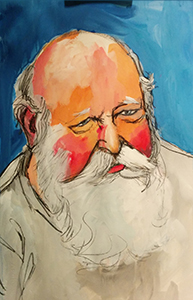

|
Philly-Bob’s Free-for-All 2015One man's visual art, largely consisting of digital manipulations of images drawn from my own photographs or from the Public Domain. |
Although I have been interested in art and graphic design all my life, I only began working seriously after I retired in 2011. The images in Philly-Bob's Free-for-All are digital manipulations of images. The images are either from the Public Domain or from my own archives of photos I have taken.
My images are strongly influenced by the optical textures I see when I close my eyes and by what I see when I dream. They are also influenced by the hallucinatory visions I saw under the influence of anaesthesia following open heart surgery.
I often use commercial art, illustration, and typography as a source of ideas.
For maximum effect with my images, click repeatedly on the image until it is full-size, which may be larger than your computer screen.
Collages
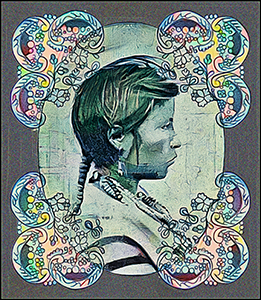
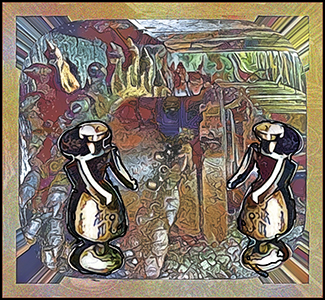
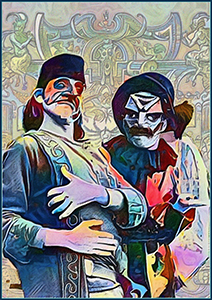
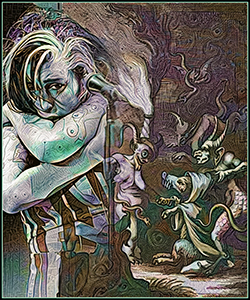
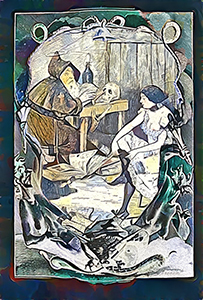
One of the things I'm thinking of for the New Year is doing fewer single images and instead doing more collages. I have learned much by taking a sidetrip into learning the DreamScope graphic filter interface. But I think I'll be returning to the style of work I was doing in April. Unfortunately, this makes the documentation more time consuming, so for a while, I'll skimp on documentation.
Also: I have to think of archiving the work of 2015 and starting fresh for 2016.
Two images combined in the first picture: (1) an Indian maiden labelled Fille Ostiak (Khanty girl) from the 1896 travel journal Du Volga a l'Irtisch (Link1) and (2) a corner pattern for a pocket handkerchief from the 1866 The ladies handbook of fancy and ornamental work : comprising directions and patterns for working in appliqué, bead work, braiding, canvas work, knitting, netting, tatting ... &c., &c. (Link2).
Second image combines a picture of a mine digger from the 2000 BLM Solid Minerals (Link3) report from the U.S. Bureau of Land Managemnt with a a cartoon logo for UHU, an all-purpose adhesive, from a 1943 edition of Frauen-Warte (Link4) (Google Translate: Waiting Woman), a wartime German women's magazine.
Third image, combines a 20th century publicity photo of a mime troup from the 1985 Durov's pig : clowns, politics, and theatre (Link5) with the ornate frontispiece of the 1557 Fasti et trivmphi Rom. a Romvlo rege vsqve ad Carolvm V. Caes. Aug., sive, Epitome regum, consulum, dictatorum, magistror. equitum, tribunorum militum consulari potestate, censorum, impp. & aliorum magistratuum Roman. cum orientalium tum occidentalium, ex antiquitatum monumentis maxima cum fide ac diligentia desumpta (Link6).
Fourth image, one of the last images of tragic Amy Winehouse performing, combined with an image of hellish creatures from the 1782 La Tentation de Saint Antoine : ornée de figures et de musique (The Temptation of
St. Anthony (Link7)). Photographer Brian Basic took the Amy picture; he explained: I had been photographing Amy Winehouse since she started, and her PR and manager organised for me to cover this gig in Belgrade. It was fairly disastrous, but we’d seen that before with her. It wasn’t new and it wasn’t anything you would think about afterwards. When she passed away, I decided to release a few more as I believed the world should see what happened there. They are disturbing photos: you could see she was troubled. When some of my colleagues saw them, they cried. I’ve been documenting music for decades, but I think those pictures of Amy will follow me for ever"
Next row: another variation combining two illutrations from the 1782 Tenptation of St. Anthony (Link7).
Source:
Link1 archive.org/details/duvolgalirtisch00baye
Link2 archive.org/details/McGillLibrary-100199-325
Link3 archive.org/details/blmsolidminerals01unit
Link4 archive.org/details/FrauenWarte11.JahrgangHeft14194320S.ScanFraktur
Link5 archive.org/details/durovspigclownsp00sche
Link6 archive.org/details/fastiettrivmphir00panv
Link7 archive.org/details/McGillLibrary-rbsc-volt_tentation-saint-antoine_PQ2066S6T41781-15401
December 25-6, 2015
Holiday Card
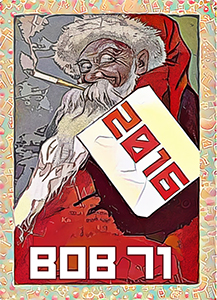
From a volume of 1919 issues of the outdoor magazine Forest and Stream, an illustration for a tobacco ad, MURAD Turkish tobacco, featuring a wrinkled Santa Claus smoking a cigarette. Those who know me may note a resemblance. Added text in
Kremlin font by Vic Fieger mark two other events: my 71st birthday and a New Year.
Source:
Link1 archive.org/details/foreststream4187dahl
December 25, 2015
Photographic Collage
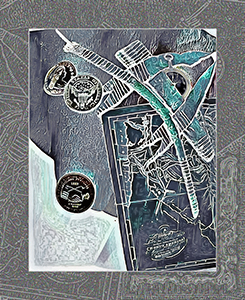
The cover of the 2004 Annual Report Of The Director Of The Mint, showing coins and surveying instruments.
Source:
Link1 archive.org/details/AnnualReportOfTheDirectorOfTheMint2004
December 24, 2015
Spanish Men
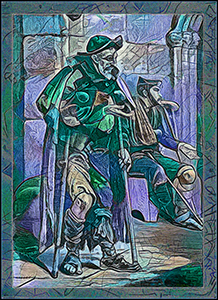
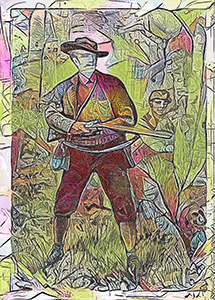
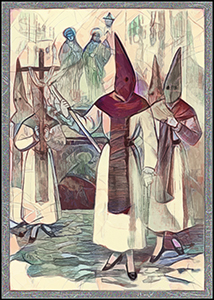
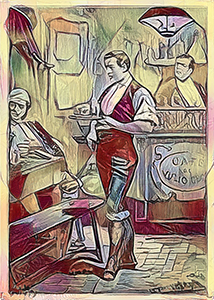
From an 1885 collection of portraits of Los hombres espanoles, there lusitanos pintados americanos por si mismos : coleccion of tipos y cuadros of costumbres peculiar de Espana y Portugal America Escritos por los mas reputados literate paises de estos (Google Translate:
"Spanish men , there lusitanos American painted themselves : collection of paintings of unique types and customs of Spain and Portugal Written by America 's most literate countries reputed these"). First, some beggars hanging around public buildings. Second, a hunter, gun-in-hand; the picture is captioned "Implacable Hunter." Third, is an image showing a procession in Seville during Holy Week. Fourth, a scene in a bar in the mountains of Seville.
Source:
Link1 archive.org/details/loshombresespano00diaz
December 22, 2015
Illustrations
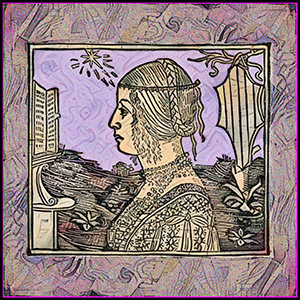
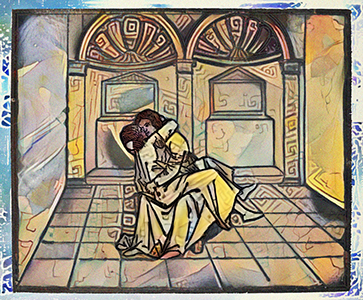
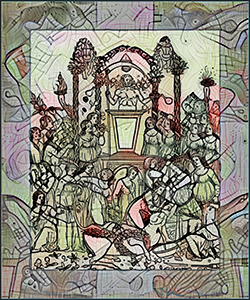
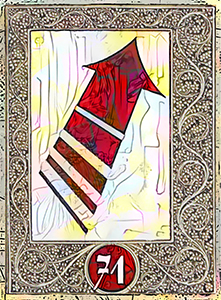
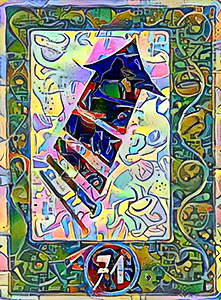
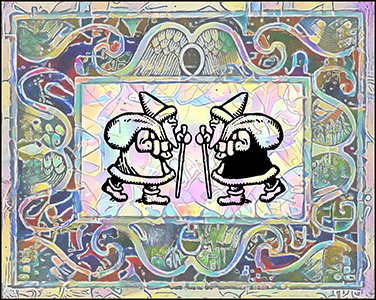
From the 1894 Italian book illustrations : chiefly of the fifteenth century, a woodcut portrait (executed in 1497) of 14-year-old Damisella Trivulzia. Odd background objects, to the left what looks to be a modern high-rise and to the right a highly stylized tree. The second picture is The Meeting of Lovers from the 1499 Hypnerotomachia Poliphili (Google Translate: Poliphilo's Strife of Love in a Dream or The Dream of Poliphilus). Third, from the same book, a depiction of a festival to The Garden God (top), with dancing maidens and a cow with its throat cut as a sacrifice (bottom).
Next row, from the same book, two versions of a treatment of a frontispiece by the talented 15th-century engraver Erhard Ratdolt, enlivened by fonts and designs by talented 20th-century type designer Manfred Klein. The "71" indicates my age at my upcoming birthday, two days away. Next, a cover from the 1899 A list of books made during the year 1899 by the Roycrofters at the Roycroft shop (Link2), overlaid with two Santa Claus images from a Manfred Klein dingbat font, In the original, the text in the middle box reads: Life Without Industry is Guilt, Industry Without Art is Brutality. The Roycroft were an influential 19th century American Arts and Crafts Guilt. My parents owned one of their lavishly illuminated books, Elbert Hubbard's A Message to Garcia.
Source:
Link1 archive.org/details/italianbookillus00poll_0
Link2 archive.org/details/listofbooksmaded00royc
December 18, 2015
Contented Smokers
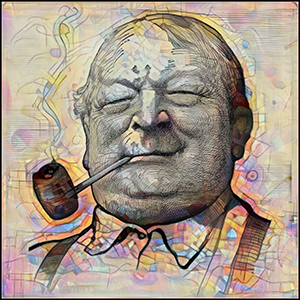
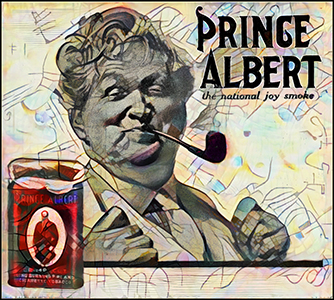
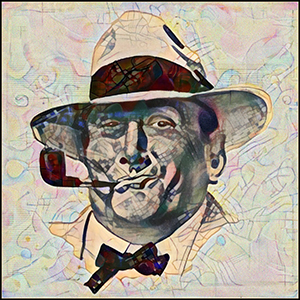
From a volume of issues of the outdoor magazine Forest and Stream in 1919, images of happy smokers from Prince Albert tobacco ads. The accompanying text is archaic American vernacular I can scarcely decipher. The text for the first image is:
Say, you'll have a streak of smokeluck that'll put pep in your smokemotor, all right, if you'll ring in with a jimmy pipe or cigarette papers and nail some Prince Albert for packing!The text for the second image is (click to enlarge):
Just between ourselves, you never will wise-up to high-spot-smoke-joy until you can call a pipe or a home made cigarette by its first name, then, to hit the peak of pleasure you land square on that two-fisted-man-tobacco, Prince Albert.
Well, sir, you'll be so all-fired happy you'll want to get a photograph of yourself breezing up the pipe with your smokethrottle wide open. Quality makes Prince Albert so different, so appealing. And P.A. can't bite or parch. Both are cut out by our patented process!
Right now, while summer's young, you get out your old jimmy pipe or "papers" and land on P.A. for what ails your particular smokeappetite!
The text for the third image is (click to enlarge):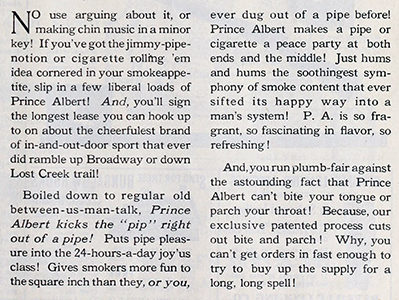
Prince Albert tobacco is still sold. It is manufactured/processed in King of Prussia and Limerick, PA.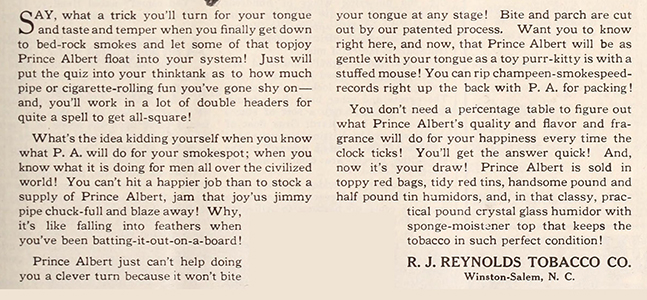
Romanticism, Suicide and Beer
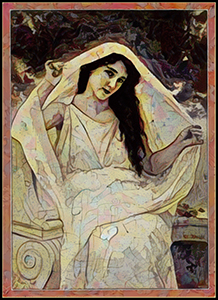
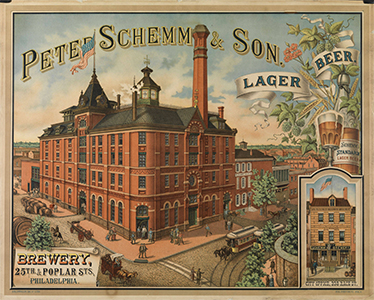
From the 1901 Catalogue of the private collection of paintings belonging to Peter A. Schemm, a painting entitled The Veil by French academic painter W.A. Bouguereau. The catalog contains little information about Schemm, but the catalog was published in Philadelphia, and a company called Peter Schemm & Son was a prominent brewer in Philadelphia's historic Brewerytown (see poster). Also, a Peter Schemm of Philadelphia is listed as committing suicide in 1898 by jumping into Niagara Falls. Interesting excursion into American history, because Philadelphia has so much history.. Schemm lived in the house where Benedict Arnold lived.
Intended to use DreamScope filters marked as Portrait, but instead used a combination of Confetti, Kandinsky Composition V, Golden Age, and Deus Vult.
Source:
Link1 archive.org/details/catalogueofpriva00sche
December 16, 2015
Stitches: Holiday Thoughts
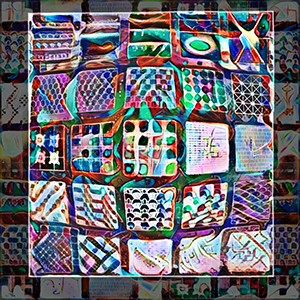
From the 1860 The ladies handbook of fancy and ornamental work : comprising directions and patterns for working in appliqué, bead work, braiding, canvas work, knitting, netting, tatting ... &c., &c. (Link1), a diagram of stitches, sent through DreamScope filters: Leger Contrast of Forms, Graffiti II, and The Wave.
A Skeptic's Holiday Thought: Human life is a brief sequence of sensations, some of them regular patterns, some random. Some pleasant, some not. It is a profound privilege to experience these moments, along with others.
Source:
Link1 archive.org/details/McGillLibrary-100199-325
December 16, 2015
Homages to Pablo Picasso
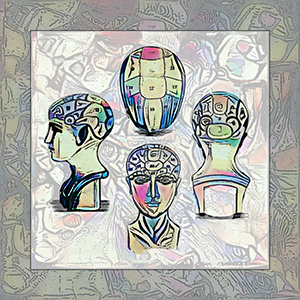
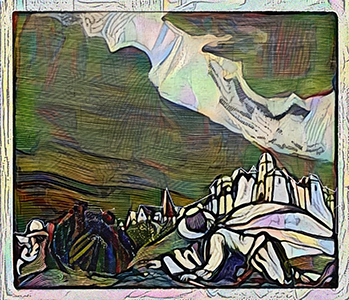
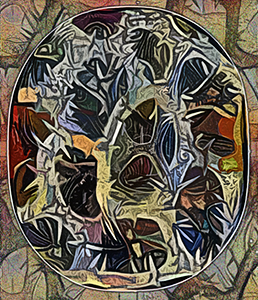
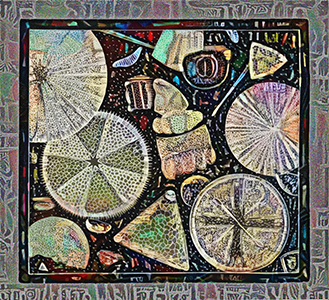
These images are created using four filters from the artistic neural net DreamScope: (1) Picasso, (2) Picasso II, (3) Gris Picasso, and (4) Picasso Portrait. They are done using those filters in honor of the Spanish master. Just yesterday I was in a room in the Yale Art Museum that contained three Picasso originals.
The first image is from the 1814 Outlines of Phrenology (Link1), by Johann Spurzheim. showing busts with headshape markings. Nowadays, Phrenology is dismissed as an old-time psuedoscience, considered "an obsolete amalgamation of primitive neuroanatomy."
Next, from a 1898 edition of The Page (Link2), a one-man magazine by actor and theatre designer Edward Gordon Craig, a wood engraving of a theatrical scene: a man holding a knife creeps up on a victim quietly reading behind a bush. Craig titled the print The Plot Thickens.
Next, a photomicrograph of a sponge from the 1870 La chambre noire et le microscope : photomicrographie pratique (Link3).
Next row, a photomicrograph of a group of diatoms from the same source. Used an additional DreamScope filter, Stained Glass.
Source:
Link1 archive.org/details/b24917679
Link2 archive.org/details/gri_33125014420919
Link3 archive.org/details/lachambrenoireet00gira
December 15, 2015
New Year
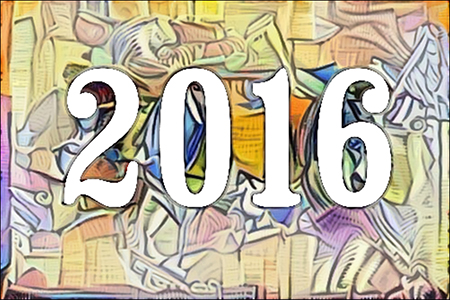
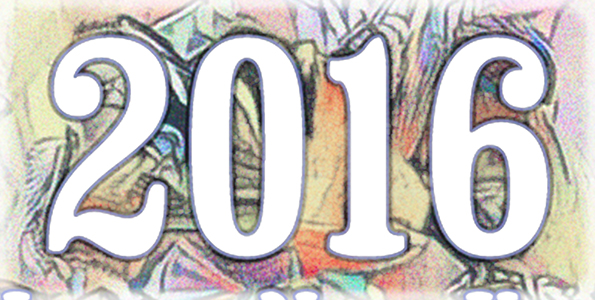
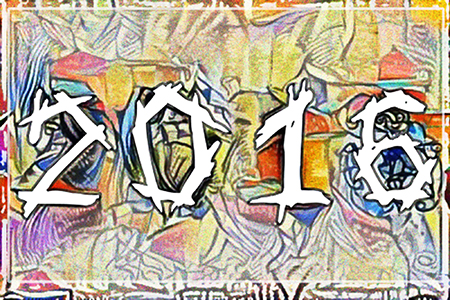
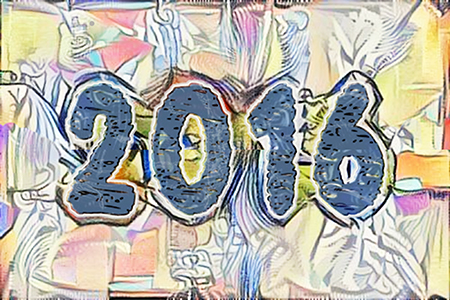
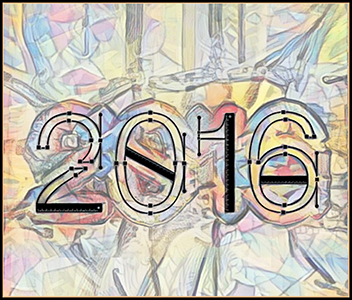

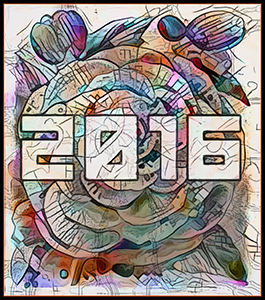
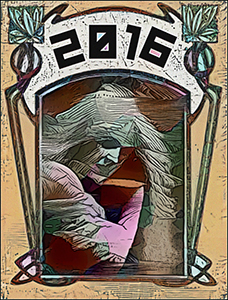
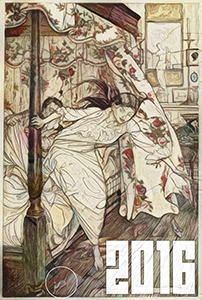
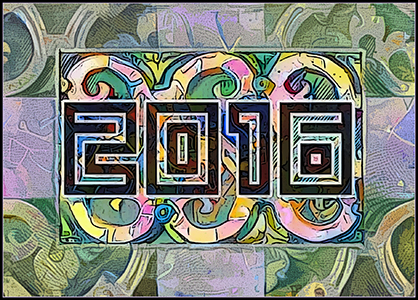
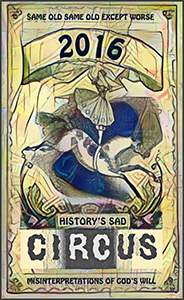
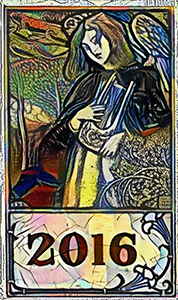
Variations on the typographic representations of the New Year. First row has two images using Dosmilcatorce, a font by one of my favorite font designers, the Spanish Woodcutter Manero.
Next row, first uses a
Escopo font by Miguel Boverto, the second is another Manero font, Meredith.
Third row, the first is Craft-Font by Argentinan Yai Salinas, the second uses another Woodcutter font, Woodcutter-Virus. Third image is Kremlin font by Vic Fieger, laid over a picture of a begonia from an 1860 seed catalog of William Bull (Link1).
Fourth row, first is a 1907 cover to the sheet music for I Am For You (Link2). The mood of the image matches my sense that in 2016 the civilized world is plummeting into irrational chaos, with Trump and Syria, guns and climate change. It uses the Kremlin font again.
Next is an illustration by Arthur Rackham for a 1912 edition of Aesop's Fables, illustrating the story of Venus and the Cat:
A cat fell in love with a handsome young man and begged the goddess Venus to change her into a woman. Venus was very gracious about it, and changed her at once into a beautiful maiden, whom the young man fell in love with at first sight and shortly afterward married. One day Venus thought she would like to see whether the cat had changed her habits as well as her form; so she let a mouse run loose in the room they were in. Forgetting everything, the young woman had no sooner seen the mouse than up she jumped and was after it like a shot: at which the goddess was so disgusted that she changed her back into a Cat.The mouse is circled in white. The cat/lady's sleepy husband is barely visible sitting up in bed, saying "Huh?". The font is Angie's New House by LeFly Fonts. Next image is a decoration from the 1560 Ornement de Ducerceau (Link4), font is Unlearned Bitmap by Aenigma. Next, a circus poster. based on the poster of a traveling California circus in the 1850's (Link5), updated with my text.
Going through boxes of old papers, I ran across the following story I wrote about 30 years ago, a rootless time when I was wandering about in a green Volkswagen, "staying" at my sister's house in Virginia and reading books of mythology.
Source:
Link1 archive.org/details/WilliamBullFirm00WillBZ
Link2 archive.org/details/b10007647
Link3 archive.org/details/aesopsfables00aeso
Link4 archive.org/details/ornementdeducerc00andr
Link5 archive.org/details/californiaspione00unse
Link6 archive.org/details/gri_33125014420919
December 3, 2015
Hanging Fantasies
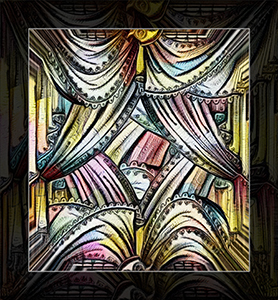
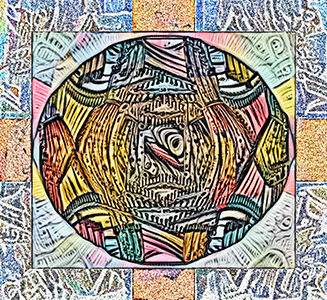
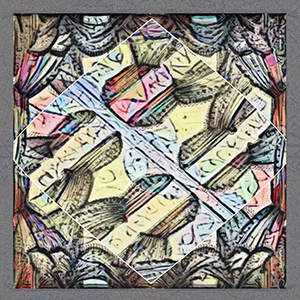
Compositions based on illustrations in the 1800 English book Designs of Draperies.
Source:
Link1 archive.org/details/gri_33125008498772
December 1, 2015
Images from WWII German Home Front
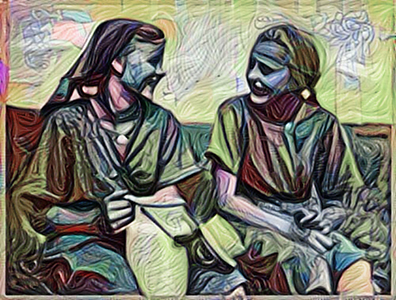
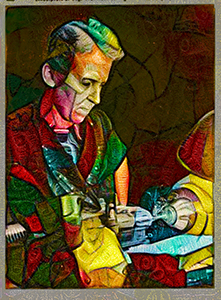
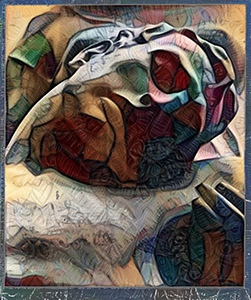
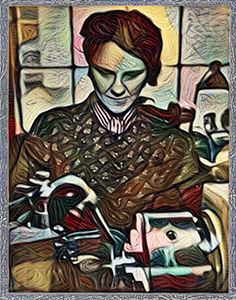
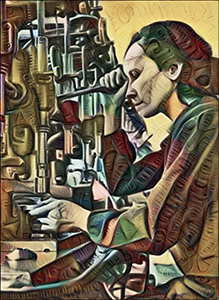
From a 1943 edition of Frauen-Warte (Google Translate: Waiting Woman), a German magazine of domestic scenes and encouragement to wartime wives.
Top row, left, a picture of two young girls in farming garb laughing in the fields; next, an older woman works in a machine shop; next, a detail from a maudlin sculpture of a dying airman by Neoclassical sculptor Josef Thorak, titled Sehn Letzter Flug (Google Translate: "See Last Flight") (Link2); next, another woman doing war work.
Second row: a woman works a drill-press.
Frauen-Warte seems to be designed in the mode of the American Life magazine, with excellent photography. The archived scans I am working with here present technical problems because the paper has turned brown and the images are huge, some 8,000 x 10,000 pixels.
Source:
Link1 archive.org/details/FrauenWarte11.JahrgangHeft14194320S.ScanFraktur
Link2 archive.org/details/FrauenWarte11.JahrgangHeft13194316S.ScanFraktur
November 29, 2015
Images from The Page
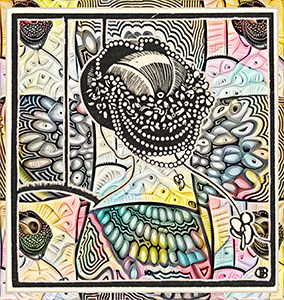
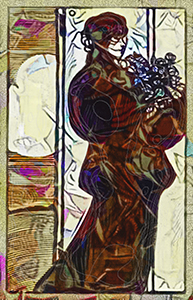
From an 1898 edition of The Page, a one-man magazine by actor and theatre designer Edward Gordon Craig. Craig came up with many innovations in set design, such as movable scenery composed of flat panels and lights mounted overhead rather than in footlights. Craig was the bastard son of a famous architect and a leading actress Ellen Terry. He grew up to be a man of great productivity and the lover of many gorgeous women, including Isadora Duncan. A sad note: for the last 40 years of his life, he refused to work on any project that did not give him complete creative control -- and he got no work. He died in obscurity.
Top row, first, a woman's headdress, next an engraving of a "gentlewoman."
Source:
Link1 archive.org/details/gri_33125014420919
November 28 2015
A Stomach's-Eye View
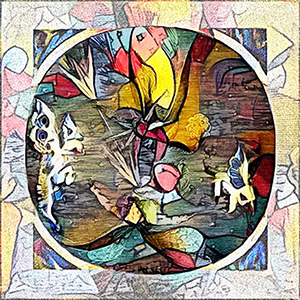
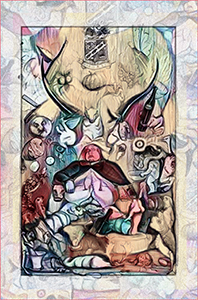
From an odd 1854 volume called Memoirs of a Stomach, left, an artist's conception of the human stomach. Next, a glutton slouches on a chair, surrounded by dreams of food. Writing in the book is florid and dated. Sample: "I may safely aver that I know all the chromatic colorings of taste from those dainty sublimated ones in alto to the more robust but less flavorable in basso, and notwithstanding this heterogenous mass being presented to my court, I should scarcely have been the worse for the introduction (saving certain adulterated abominations) had it not been for that accursed spirit called by the poor Indian, whom it has helped to exterminate, 'fire water'."
Source:
Link1 archive.org/details/b21527738
November 27 2015
Pictures from Reader
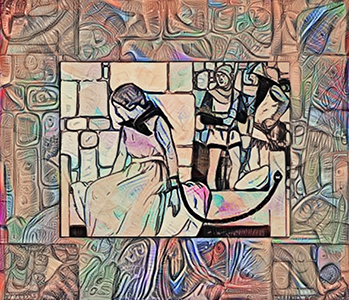
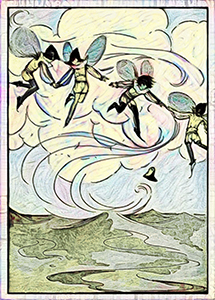
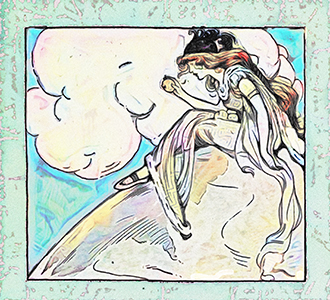
From a 1915 fourth-grade schoolbook The natural method readers. A primer-reader. The illustrator is Mary Blanche Fisher. First, an illustration to the story of Joan of Arc: "...she was kept chained day and night to her bed, mocked at by low and ignorant soldiers." Next, an illustration to a story about a tiny air current that, over time, turns into a great storm, "howling and shreiking." Next, the beautiful princess whose father keeps her on top of a glass hill, and only the man who is able to climb that glass hill can marry her.
Source:
Link1 archive.org/details/naturalmethodrea04mcma
November 25, 2015
Ladies in Motor Cars
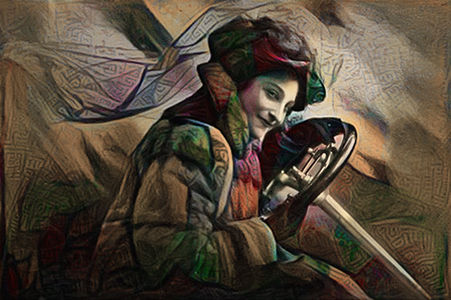
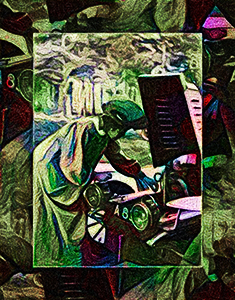
From a 1909 English book The woman and the car; a chatty little handbook for all women who motor or who want to motor, the frontispiece showing a photograph of author Dorothy Levitt at the wheel. Next, the author, in motoring costume, tends to an engine problem during a trip to the woods.
.
Source:
Link1 archive.org/details/McGillLibrary-120928-1526
November 25, 2015
Kitty-Cat Go Bye-Bye; Alphabets
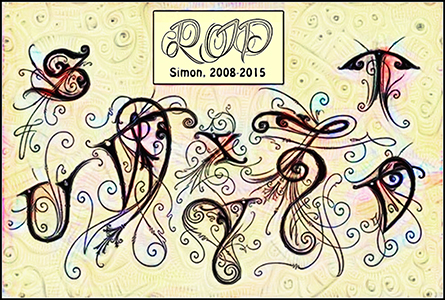
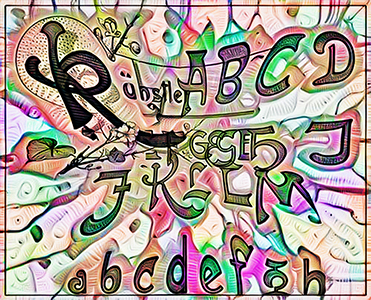
From an 1880 book of calligraphic alphabets Muster-Alphabete : verschiedener Schriftarten in den neuesten Formen, Volume 1, (Google Translate: "Master Alphabets: Different Fonts in the Latest Forms"). Here is a graphic goodbye to the Abyssinian charmer who has shared our home for six years. A gorgeous animal, he was a pure-bred (i.e., a product of inbreeding). The disease that made his father die early also gave him an early death. There wasn't a day that went by that we didn't understand how special he was.
Second picture is a variation of another alphabet in a different volume of Muster-Alphabets,, Volume 9 (Link2).
.
Source:
Link1 archive.org/details/musteralphabetev01unse
Link2 archive.org/details/musteralphabetev09unse
November 23, 2015
Early Photo Examples
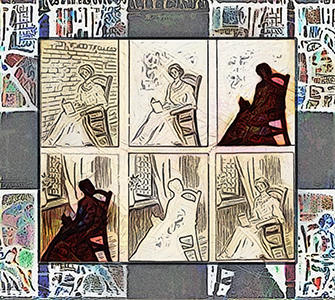
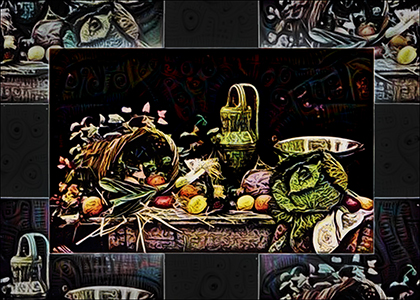
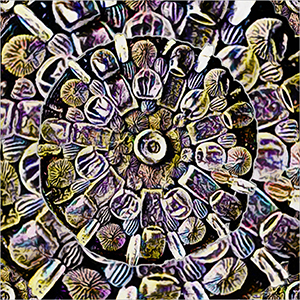
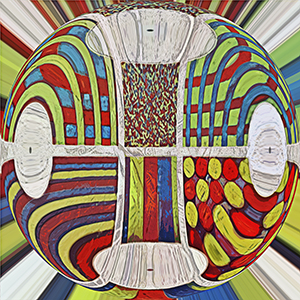
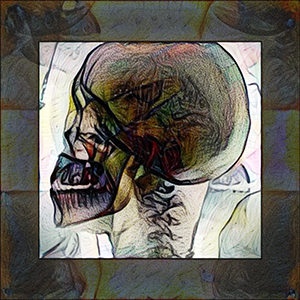
From the 1911 Cassell's Cyclopaedia of Photography: left a chart of sample photo treatments, a still life, a photo-micrograph of a cluster of insects' eggs.
Next row, a deformation of "Screen Plates for Photography in Natural Colours", a photograph of an x-rayed skull (Death is on my mind because Janice and I are considering whether it is time to take our beloved Abysinnian cat Simon in for his final visit to the vet).
May enter insects' eggs in next Plastic Club show, on Geometry and Patterns.
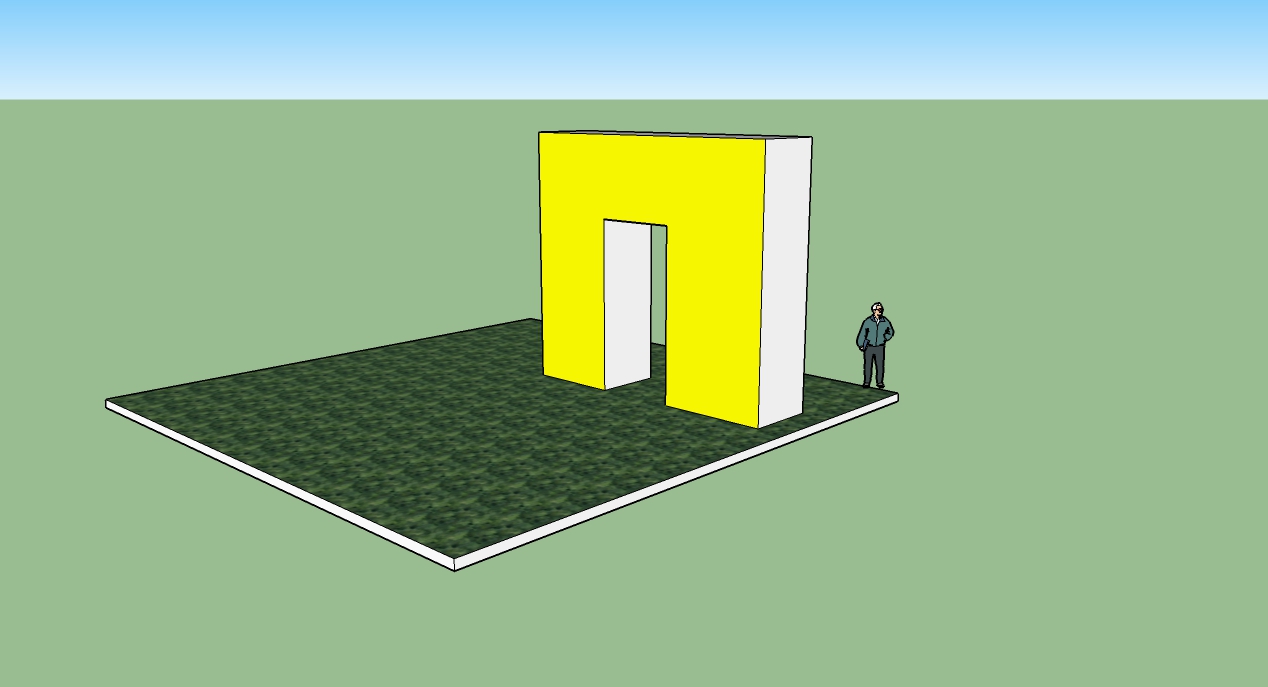
Move====Hold Alt-Command and click-drag.
Orbit===Hold Alt and click-drag.
Zoom====Hold Alt and right click-drag.
The Flythrough mode lets you navigate the Scene View by flying around in first person similar to how you would navigate in many games. Click and hold the right mouse button.
Now you can move the view around using the mouse and use the WASD keys to move left/right forward/backward and the Q and E keys to move up and down. Holding down Shift will make you move faster.
Woman with Rose
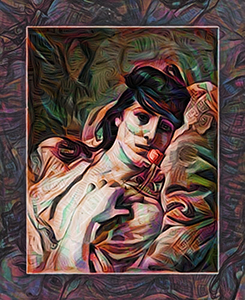
From the 1888 Recent ideals of American art : One hundred and seventy-five oil paintings and water colors in the galleries of private collectors, reproduced in Paris on copper plates by the Goupil photogravure and typogravure processes, a painting by romantic Orientalist painter F.A. Bridgman.
Mugging Actor
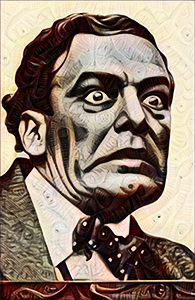
From a 1914 edition of the movie magazine Reel Life, an actor from the film serial, Million Dollary Mystery.
Source:
Link1 archive.org/details/reellife1914191600mutu
November 15, 2015
Marble for Paris
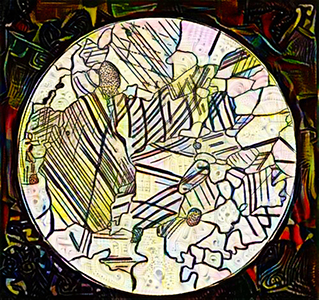
An illustration from the 1912 government document Commercial Marbles of Western Vermont, a diagram of marble markings. This is done in sympathy for the victims of the ISIS attack on civilians in Paris. Who is ISIS? I am angry and suspicious that we do not know the true origins of ISIS. Perhaps ISIS is, as Obama says, an "unintended consequence" of George W. Bush's invasion of Iraq under false pretenses. Janice and I and thousands of others were out in the streets protesting that boneheaded move.
Working mainly on Virtual Reality. One good tutorial for Google Cardboard. Working now on transferring Sketchup 3-D models into Unity, the game utility. Using FBX file format, have been able to get my Sketchup model into a new project's assets, but not onto the new project's workspace.
Source:
Link1 archive.org/details/cmwvt
November 15, 2015
Polygraphice Scenes
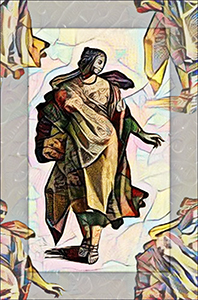
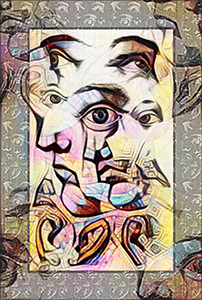
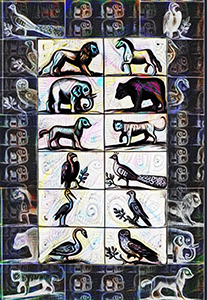
From the 1675 Polygraphice, or, The arts of drawing, engraving, etching, linning, painting, washing, varnishing, gilding, colouring, dying, beautifying and perfuming, in four books ... : to which is added, a discourse of perspective and chiromancy (Link1), various illustrations.
Source:
Link1 archive.org/details/gri_33125008248540
November 10, 2015
Geometry for Carpenters
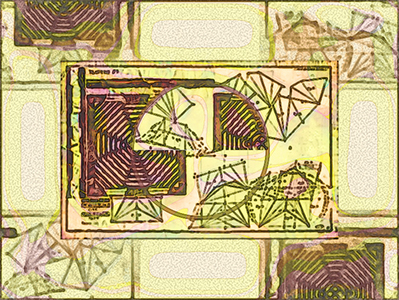
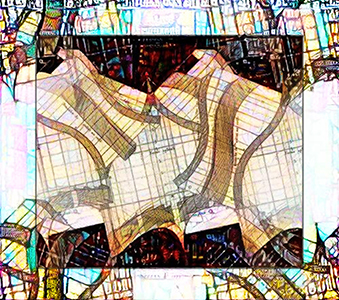
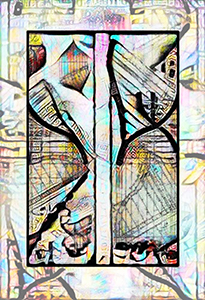
From the 1791 L'art du trait de charpenterie (Link1), a textbook of carpentry.
Source:
Link1 archive.org/details/gri_33125010850077
November 7, 2015
Beauty of Butterflies
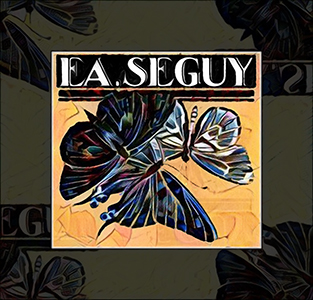
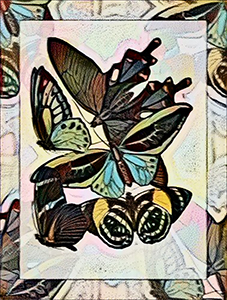
From the 1925 Papillons (Link1) (Butterflies) by E.A.Seguy.
Source:
Link1 archive.org/details/Papillons00SeYg
November 6, 2015
Birds of Brazil
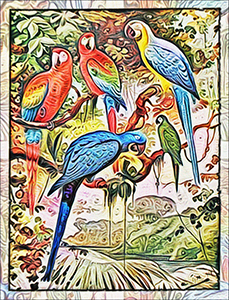
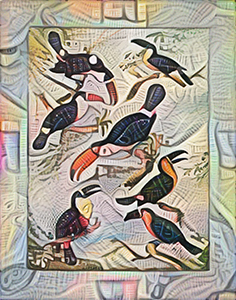
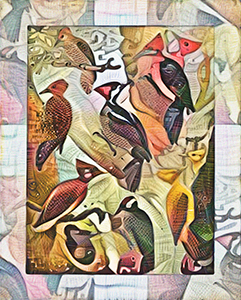
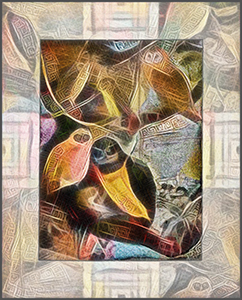
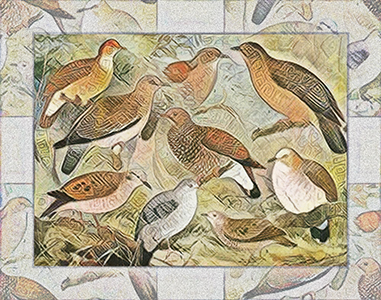
From the 1978 Novo catálogo das aves do brasil; 1ª Parte aves não Passeriformes e Passeriformes não Oscines, com exclusão da família Tyrannidae (Link1) (Google Translate: "New catalog of the birds of Brazil ; Part 1 and perching birds Passeriformes not Oscines not excluding the Tyrannidae family"), an illustration of brightly colored parrots, then one of toucans, then some woodpeckers, then some owls.
Next row: some pigeons.
Note: Considering starting to work in Virtual Reality. Would require some major learning -- but on the other hand, I have a compatible Android phone and I have experience with the Sketchup 3-D modeling program. Does my 70-year-old brain still have the flexibility to learn a cutting edge technology?
Source:
Link1 archive.org/details/Novocatalogodas00Pint
November 3, 2015
Sicilian Volcano
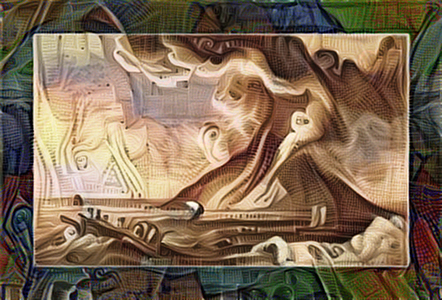
A view of one of the three volcanos on the island of Stromboli, from the 1819 A tour through Sicily, in the year 1815 by George Russell.
Source:
Link1 archive.org/details/gri_33125012275687
October 30, 2015
Old Master Treatments
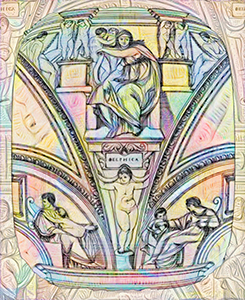
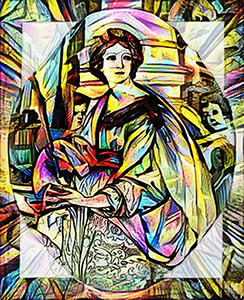
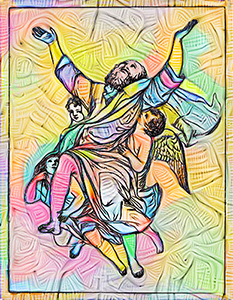
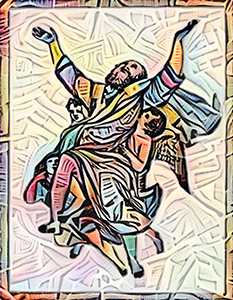
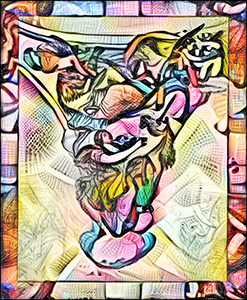
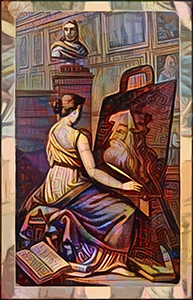
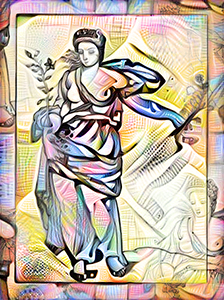
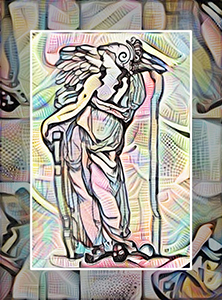
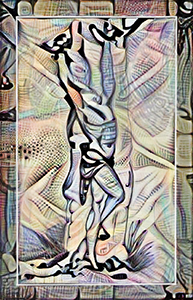
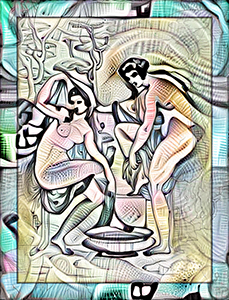
Experimental, from a book of "cartoons" of famous paintings, the 1803 Vies et oeuvres des peintres les plus célèbres de toutes les écoles : recueil classique contenant l'oeuvre complète des peintres du premier rang, et leurs portraits, les principales productions des artistes de 2e et 3e classes, un abrégé de la vie des peintres grecs, et un choix des plus belles peintures antiques, reduit et gravé au trait, d'après les estampes de la Bibliothèque nationale et des plus riches collections particulières (Link1) (Google Translate: "Lives and works of the most famous painters of every school : Classic collection contains the complete works of painters of the first rank , and their portraits , the main productions of the 2nd and 3rd classes of artists , an abstract of the life of Greek painters , and a choice of the most beautiful ancient paintings, reduced and engraved Line , according to the prints of the National Library and richest private collections"). First image is a Sistine Chapel panel by Michaelangelo. Second image is a picture of St. Cecilia. Third, an elderly saint lifted by angels, in two versions.
Next row, left, on an architectural section, various angels and goddesses are shown controlling a wagon pulled by a lion and unicorn, in a study called Temperance. Second in row, from a different book, the Galerie des peintres célèbres : avec des remarques sur le genre de chaque maître (Link2) (Google Translate: "Gallery famous painters : with remarks on the type of each master"), a young woman paints a picture of an old man -- something of a role reversal. Third, from the first book (Link1), an unidentified woman seems to bring Spring. Next, a figure of Military Glory.
Next row, St. Sebastian hangs from a tree. Then two women take a bath.
Considering switching to another DeepDream source.
Source:
Link1 archive.org/details/gri_33125012224933
Link2 archive.org/details/galeriedespeintr01leca
October 29, 2015
Woman Considering Shoe Choice
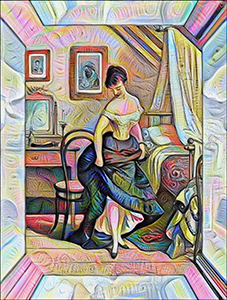
From an 1880 Spanish book of manners, Historia de una mujer : album de cincuenta cromos (Link1), a woman in her chamber examines the shoes on her feet. Illustration by Eusebi Planas.
Source:
Link1 archive.org/details/gri_33125008679579
October 29, 2015
Another Flower Catalog Girl
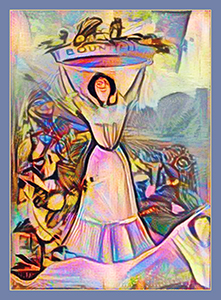
From a 1901 catalog from OK Seeds (Link1), another giant flower maiden distributes blessing over the countryside, from a basket labeled "Bountiful."
Source:
Link1 archive.org/details/CAT31284169
October 28, 2015
Adam and Eve
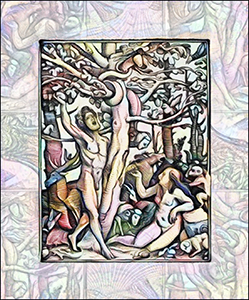
An engraving of Adam, Eve, snake and apple in the 1547 Icones historiarvm Veteris Testamenti : ad viuum expressae, extremàque diligentia emendatiores factae : Gallicis in expositione homoeoteleutis, ac versuum ordinibus (qui priùs turbati, ac impares) suo numero restitutis (Google Translate: "Icones historiarvm of the Old Testament : a living to the given expressions of extremaque diligence emendatiores 's proclamation of the Gallic homoeoteleutis in the exposition...") by Hans Holbein.
Source:
Link1 archive.org/details/gri_33125008662880
October 28, 2015
Ella Wheeler Wilcox
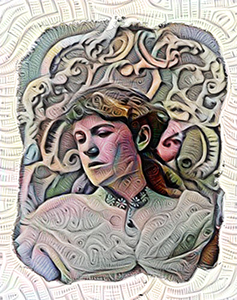
The author's frontispiece portrait from a collection of essays by 19th century poet and spiritualist Ella Wheeler Wilcox, entitled Men, Women and Emotions.
Source:
Link1 archive.org/details/menwomenemotions0000wilc
October 28, 2015
Pagani Print: Woman Reading
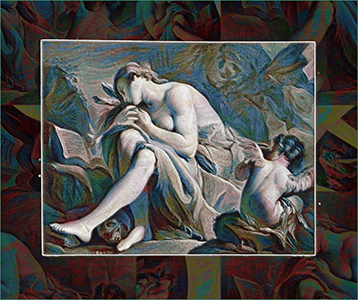
From the 1753 Recueil d'estampes d'apres les plus celebres tableaux de la Galerie Royale de Dresde : contenant cinquante pieces avec une description de chaque tableau en françois et en italien (Google Translate: "After collection of prints of the most famous paintings in the Royal Gallery in Dresden containing fifty parts with a description of each table into French and Italian") (Link1), a print by Paulo Pagani.
Source:
Link1 archive.org/details/gri_33125008696409
October 27, 2015
New Dream Scope Filters
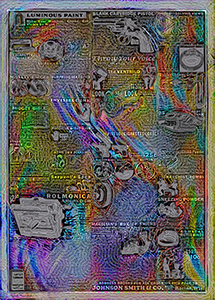
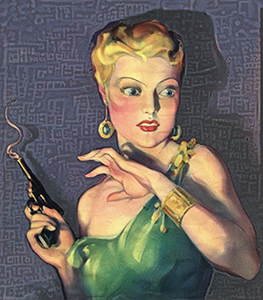
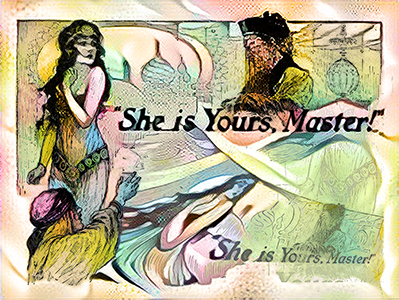
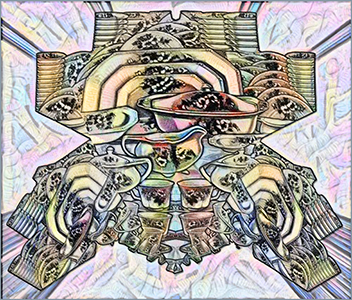
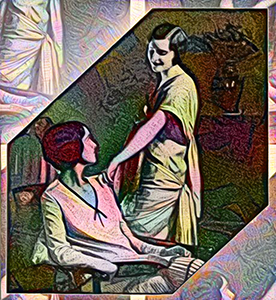
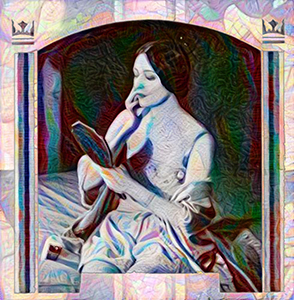
Unexpectedly, the DreamScope tool that I use for some steps of my process introduced ten or so new filters late last night, some named to mark the Halloween occasion. I immediately started experimenting. To the left, a black-and-white page of advertising text from a 1930 True Dective magazine sent through the filters. Next to that, a blonde holding a smoking gun from the cover, also sent through the new filters.
And third, an illustration for a book series called Masterpieces of Oriental Mystery, showing a Gibson Girl-type dressed in harem costume, under the headline She is Yours, Master! Text: Sick at heart the trembling girl shuddered at the words that delivered her to this terrible fate of the East. How could she escape from this Oriental monster..."
First in the next row, variations on a black-and-white illustration for a set of ivory porcelain dishes, 100 pieces for $16.85. "A complete dinner set for 12." 30-day trial for only $1. Next, a "popular" teenager (standing) counsels her "unpopular" friend to seek treatment for her complexion by taking SSS tonic, still sold today as a treatment for anemia.
Next, a woman seated on her bed applies Princess Pat Ice Astringent to remove "Pore Film."
Source:
Link0 archive.org/details/TrueDetective0330
October 25, 2015
World War II Recognition
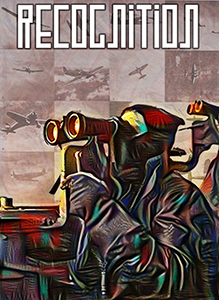
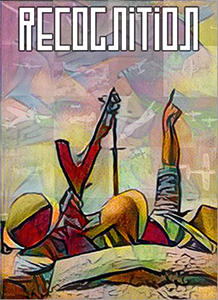
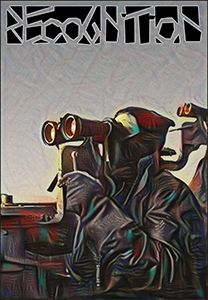
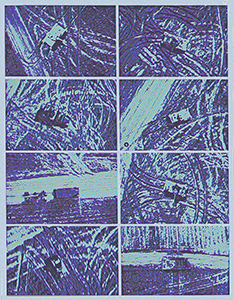
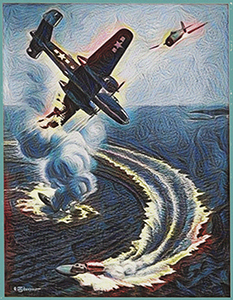
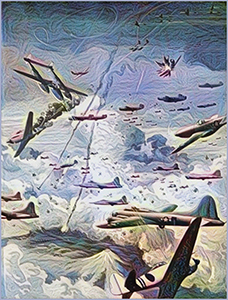
A cover design for a possible new series. (Link0)
From a 1945 Recognition Journal (Link1), a U.S. Army-Navy magazine aimed at training allied troops in how to recognize military hardware and distinguish friend from foe in air, water and land. Left, a page from a two-page quiz, Seen from Above which tests readers' ability to recognize tanks and trucks. The answers, from top left, Row 1: a German Panzer IV tank, a U.S. M-4 medium tank, Row 2: a German 8-ton half-track pulling a flak gun, a Japanese light tank, Row 3: German half track towing 88-mm artillery piece, U.S. M-10 tank destroyer, Row 4: German gun on Czech 38 chassis, British Cromwell tank.
Next to that, from another issue of the same magazine (Link2), a painting used to illustrate an article, It Could Happen to Anybody, explaining what can happen when airmen get confused on the battle field. The caption explains, "In a swirling fight, U.S. planes and PT [boats] stage a useless, fatal battle to an enemy's advantage."
According to the accompanying article, in the Pacific war, a B-25 pilot on patrol spotted two torpedo boats below him. "Not recognizing them as U.S. Navy PT's, he came down on them, strafing with his eight .50-caliber machine guns. They, in turn, opened up on him. While the first PT was still sinking, a patrolling Navy fighter happened along, swung in on the bomber and shot it down. The bomber pilot never lived to make explanations, nor did all the PT men."
The artist of this dynamic painting is Alexander Leydenfrost, an aristocrat in the Austrian-Hungarian empire who moved to the United States (with friends Bela Lugosi and Peter Lorre) and became "The Baron of Aviation Art." He also did science fiction covers.
The third picture is an artist's illustration of the expected air war over Japan -- see Mt. Fuji in the bottom center --in an article written before the march across the Pacific, warning servicemen experienced in the European Theatre, of the new identification problems they would face with the various Japanese planes. Also from the same magazine (Link3).
Foster-Munger: A New Series

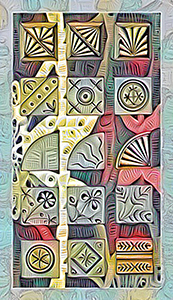
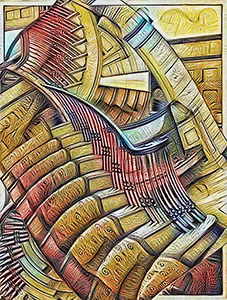
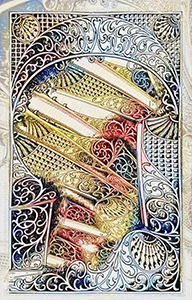
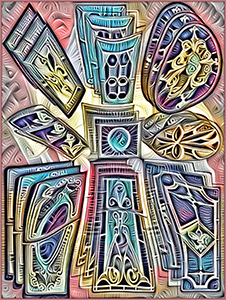
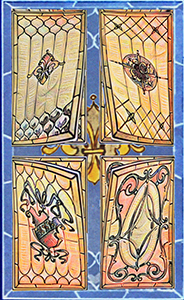
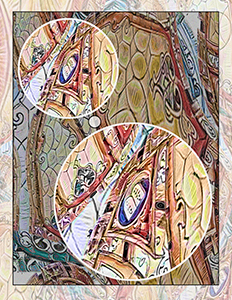
From a 1900 catalog by Foster-Munger Co. (Link1) of Chicago, a wholesale manufacturer of "doors, blinds, glazed sash, mouldings [and] everything in millwork."
First row: The title image is a variation on the catalog's art deco cover. Next, variations on a page of "Fancy Corner Blocks." Third, deformations of the illustration of a two-rise "Special Staircase," list price $85, including "balusters". Fourth, a composition of "grille or fret work."
Second row: First two are variations on pages of stained glass windows for residential use; third is composition of stained glass windows for church use, with the Old Testament Decalogue (10 Commandments) visible.
Roerich: Language of the Birds
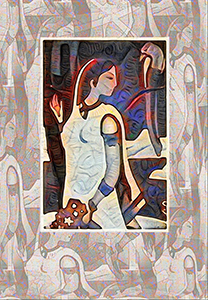
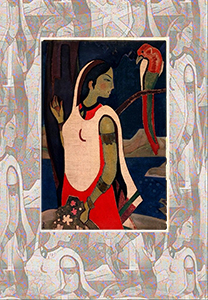
Two variations of a painting by Russian-born painter and spiritualist Nicholas Roerich, titled The Language of the Birds, taken from the 1922 catalog Roerich (Link1). Although Roerich's apocalyptic spiritualism leaves me cold, his art, especially his views of Tibetan mountains, is effecting. Take a look at his Wikipedia profile, he is an interesting figure. In addition, Roerich showed a lifelong interest in the preservation of works of art and culture during period of political torment. The concern is especially relevent today.
Source:
Link1 archive.org/details/roerich00roer
October 18, 2015
World War II Recognition



From a 1945 Recognition Journal (Link1), a U.S. Army-Navy magazine aimed at training allied troops in how to recognize military hardware and distinguish friend from foe in air, water and land. Left, a page from a two-page quiz, Seen from Above which tests readers' ability to recognize tanks and trucks. The answers, from top left, Row 1: a German Panzer IV tank, a U.S. M-4 medium tank, Row 2: a German 8-ton half-track pulling a flak gun, a Japanese light tank, Row 3: German half track towing 88-mm artillery piece, U.S. M-10 tank destroyer, Row 4: German gun on Czech 38 chassis, British Cromwell tank.
Next to that, from another issue of the same magazine (Link2), a painting used to illustrate an article, It Could Happen to Anybody, explaining what can happen when airmen get confused on the battle field. The caption explains, "In a swirling fight, U.S. planes and PT [boats] stage a useless, fatal battle to an enemy's advantage."
According to the accompanying article, in the Pacific war, a B-25 pilot on patrol spotted two torpedo boats below him. "Not recognizing them as U.S. Navy PT's, he came down on them, strafing with his eight .50-caliber machine guns. They, in turn, opened up on him. While the first PT was still sinking, a patrolling Navy fighter happened along, swung in on the bomber and shot it down. The bomber pilot never lived to make explanations, nor did all the PT men."
The artist of this dynamic painting is Alexander Leydenfrost, an aristocrat in the Austrian-Hungarian empire who moved to the United States (with friends Bela Lugosi and Peter Lorre) and became "The Baron of Aviation Art." He also did science fiction covers.
The third picture is an artist's illustration of the expected air war over Japan -- see Mt. Fuji in the bottom center --in an article written before the march across the Pacific, warning servicemen experienced in the European Theatre, of the new identification problems they would face with the various Japanese planes. Also from the same magazine (Link3).
Joli Coueur de Rose
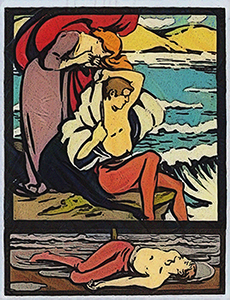
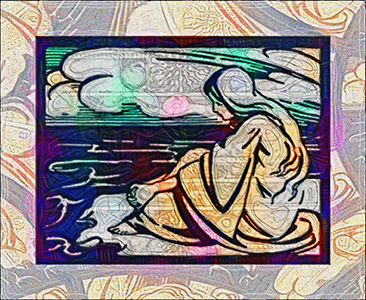
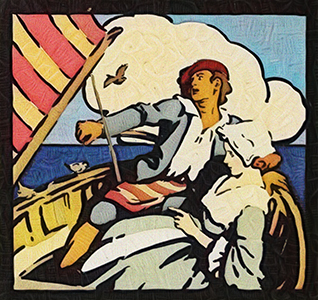
From the superbly illustrated 1904 French songs of old Canada, with wood engravings by English "gentleman artist" Walford Graham Robertson. The song illustrated, Joli Coeur de Rose, tells the story of the sweetheart of a sailor who perished aboard a frigate by that name. To the left, two pictures combined: the top one shows the sailor and sweetheart in love before the accident, the bottom picture shows the drowned sailor as he washed ashore on the beach. To the right, the illustration shows the grieving sweetheart seated on the beach, staring pensively at the sea.
The words of the song are below:
C'était une frégate, mon joli coeur de roseUnfortunately, my smattering of university and tourist French has abandoned me and I lost my French-English dictionary in my various moves.
A la mer à touché, joli coeur de rosier
Y'avait une demoiselle...
Sur l'bord d'la mer pleurait...
Qu'avez vous donc la belle...
Qu'a vous à tant pleurer...
Je pleure mon anneau d'or...
A la mer à tombé...
Que donneriez-vous belle...
Qu'irait vous le chercher...
Je suis trop pauvre fille...
J' n'ai rien à vous donner...
Qu'mon petit coeur en gage...
Pour mon anneau doré...
Le galant se dépouille...
A la mer s'est jeté...
A la première plonge...
L'anneau d'or a touché...
A la deuxième plonge...
L'anneau d'or a sonné...
A la troisième plonge...
Le galant c'est noyé...
Il allait à la drive...
Comme un poisson doré...
Son père à la fenêtre...
Le regardait d'river...
Faut-il pour une fille...
Que mon fils soit noyé...
Bombers of the 40's and 50's
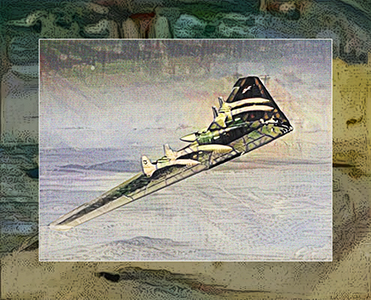

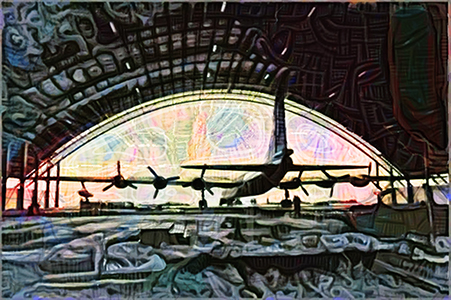
On Flickr.com, a new source of public domain images with an aviation theme. Far left is a 1949 photo of a Northrop YB-49, the Flying Wing bomber in flight. The YB-49 was the coolest plane of my youth. It never went into production. Instead, the military used the six-piston-engine B-36 bomber (next image). Superimposed and barely visible in the bottom of the B-36 image are a picture of a B-36 crash site and a display at an air show. Next the B-36 picture is an image of the bomber in a giant hangar.
Source:
Link1 www.flickr.com/photos/aahs_archives/
October 11, 2015
Imperial Adventure in Africa
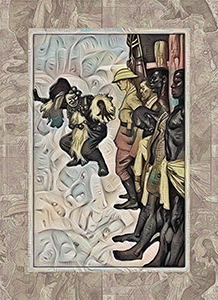
An illustration from a 1915 edition of Allan and the Holy Flower, Victorian novelist H.Rider Haggard's boy's story of adventurer Allan Quatermain's search through Africa for an orchid with special properties. A dancing witch doctor confronts a pith-helmeted explorer and a bearded professor as villagers watch. The novel begins, I do not suppose that anyone who knows the name of Allan Quatermain would be likely to associate it with flowers, and especially with orchids. Yet, as it happens, it was once my lot to take part in an orchid hunt of so remarkable a character that I think its details should not be lost...
Moorish Fretwork
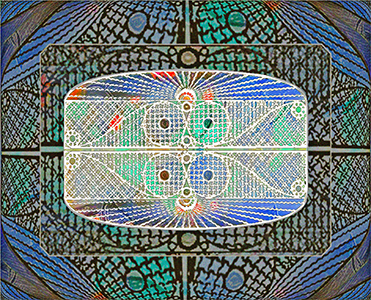
A treatment of an image from an 1891 catalog by C.S. Ransom Co. of milled "Moorish Fretwork" taken from a PDF kindly shared by Paul Taylor who contacted me last week about some of my treatments of Milled Wooden Grills (see below). Unfortunately, I don't have an online link to the PDF.
Source:
NA
October 8, 2015
Eleven 19th-Century Seed Catalog Covers
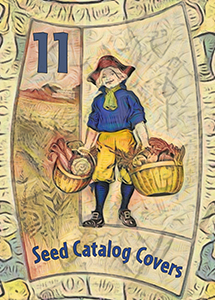
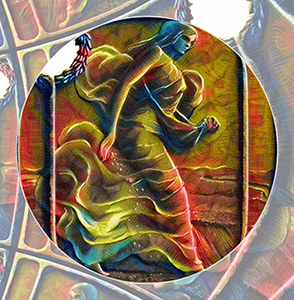
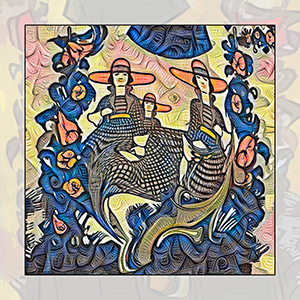
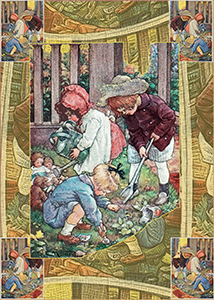
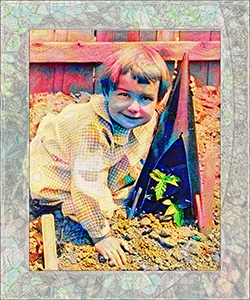
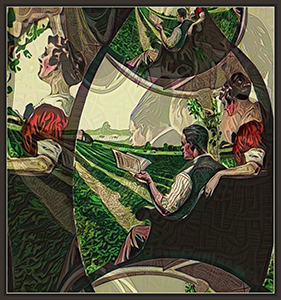
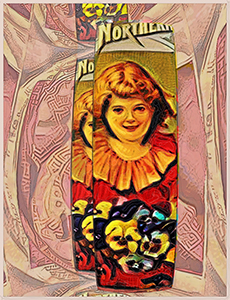
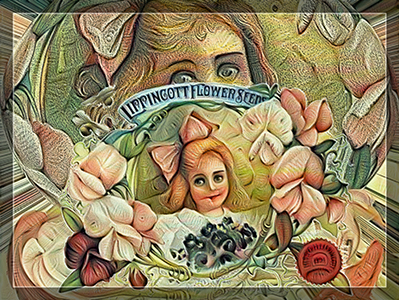
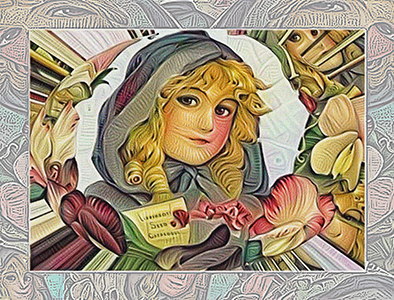
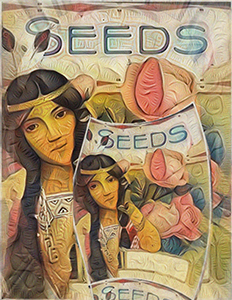
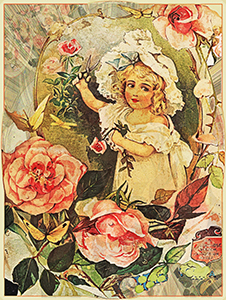
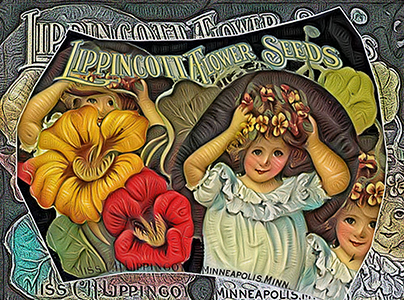
Far left, from a 1920 D. Landreth Seed Company catalog (Link0), a colonial boy carries baskets of flowers.
from the cover of a 1914 seed catalog by Toledo-based Henry Phillips Seed and Implement Co. (Link1), a goddess of harvest spreads seed over the land.
Next, from the cover of a 1904 catalog from Theodore Payne Nursery of California (Link2), a cartoon gardener in an orange hat and gingham sundress.
Third, a treatment of an illustration from the cover of a 1923 seed catalog from Barteldes Seeds of Lawrence, Kansas, three Hummel-figurine children play in a garden. The kids were part of the company's marketing strategy; parents who bought seeds received a free illustrated children's book.
Next, a cover photo of a child tending to a plant from a 1920 seed catalog The Burbank Seed Catalog, a company owned by
botany pioneer Luther Burbank.
Next is a 1919 cover illustration from R.M. Kellogg (Link5) of Michigan, entitled "Great Crops of Strawberries and How to Grow Them". It shows a well-dressed farm couple on a porch surveying their green fields.
A ginger-haired child with a lapful of flowers graces the 1890 seed catalog of L.L. May (Link6) of Minnesota.
From an 1894 catalog from Lippincott Seeds (Link7) of Minnesota, another girl displays flowers.
Another Lippincott (Link8) catalog.
From a 1909 flower catlog from L.L. May (Link8) showing a leather-clad and befeathered Indian maiden surrounded by a new breed called the Minnetonka Rose.
From a 1904 catalog from L.L. May, a little girl in white surrounded by roses.
From a 1906 catalog from Lippincott (Link10), another little girl in white holds up a laurel of flowers.
Ornaments and Dingbats
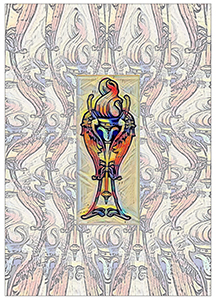
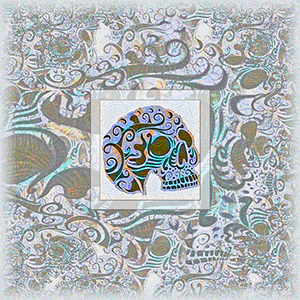
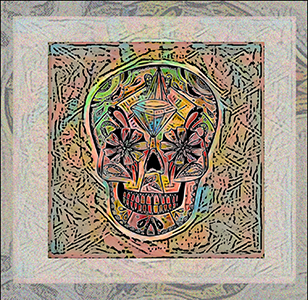
From a 1908 English printers' sample book Specimens of point line type : borders ornaments brass rules &c (Link1), a printers' ornament. Then a Mexican Skull dingbat (Link2) from talented Spanish font designer Woodcutter. Both started out black and white, with color from Dreamscape.
Source:
Link1 archive.org/details/specimensofpoint00step
Link1 www.dafont.com/mexican-skull.font
September 30 - October 1, 2015
Sitting for Portrait Class
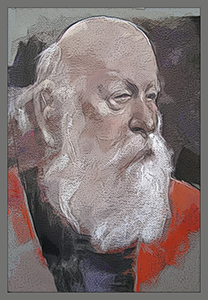
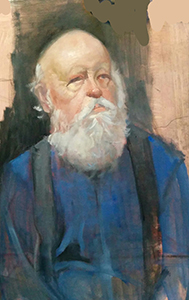
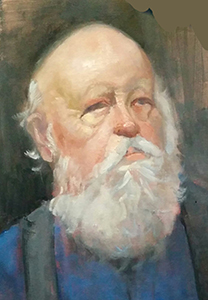
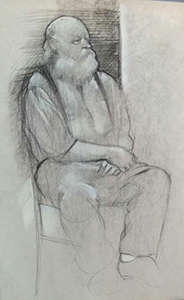
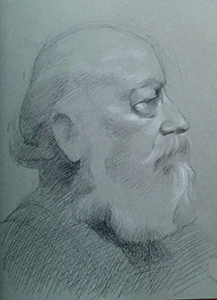
Sat 3 hours -- 20 minutes on, 10 minutes break -- for two portrait painting classes at the Plastic Club. Here is some of the artists' work. Got paid $45 model's fee (which I didn't expect) but the artists kindly agreed to let me take photos of their work.
Those 20-minute stretches of silent stillness was the closest I ever come to meditation. Given my pathetic compulsion to "do" things with my time, I figured out that it was a good chance to practice my Roman Room memory techniques to write stanzas of poetry. First day, I wrote a poem called "Hollow Tube." Second day, I wrote notes on the childhood cottage that I use as my Roman Room. Ended up the second session in deep depression, remembering that cottage and realizing that my relative social and economic status and financial security has declined from that of my parents at the equivalent age.
Source:
NA
September 22 & 29, 2015
Boy in Sailor Suit: Reproduction Methods
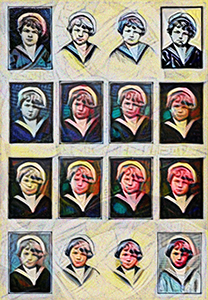
From a 1900 printers' sample book New specimen pages of printing types for all kinds of catalogs, booklets & periodicals, a sample page showing 16 reproduction methods ranging from Wood Engraving in Upper Left to Combination 175 Half-Tone and Line in Lower Right.
Source:
Link1 archive.org/details/newspecimenpages00hunt
September 28, 2015
Heraldic Motifs Dreamscaped
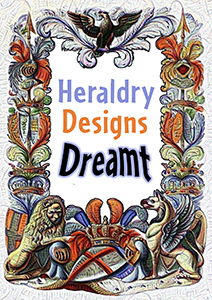
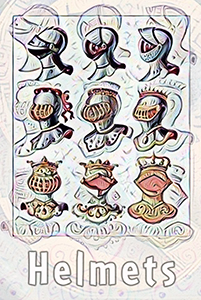
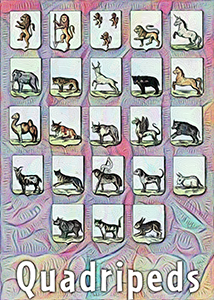

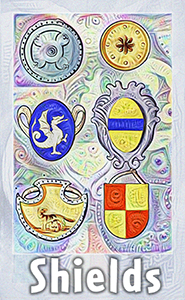
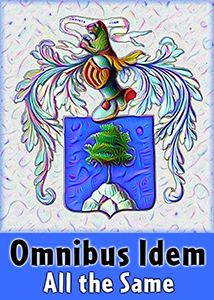
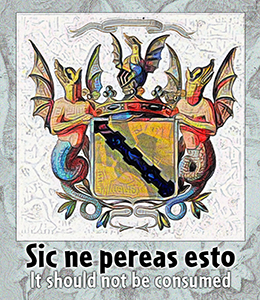
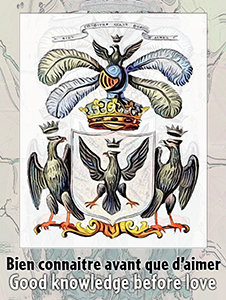
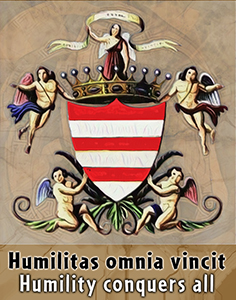
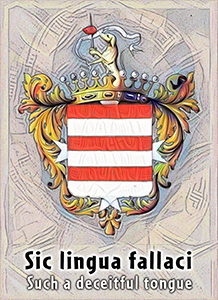
Starting a third series of Google Dream variations on related images, based on illustrations from an 1841 Italian book on heraldry, Teatro araldico, ovvero Raccolta generale delle armi ed insegne gentilizie delle più illustri e nobili casate che esisterono un tempo e che tuttora fioriscono in tutta l'italia : illustrate con relative genealogico-storiche nozioni (Link1). (Google Translate: "Heraldic theater, or general collection of arms and aristocratic insignia of the most illustrious and noble houses that existed at one time and still flourish throughout Italy: illustrated with relevant genealogical-historical notions.") When an illustration includes a motto, I will add it, along with my attempt at finding a translation.
Source:
Link1 archive.org/details/teatroaraldicoov01tett_0
September 23, 2015
Embroidery Patterns Dreamscaped


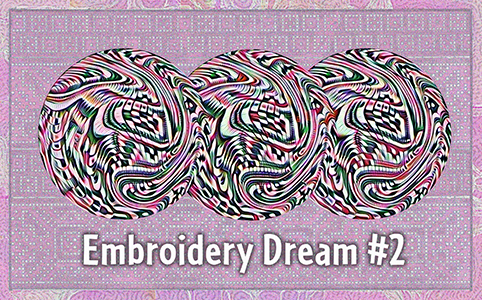

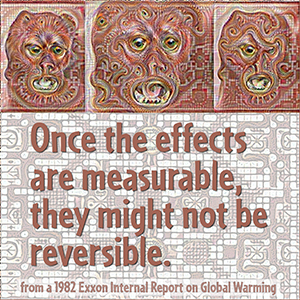
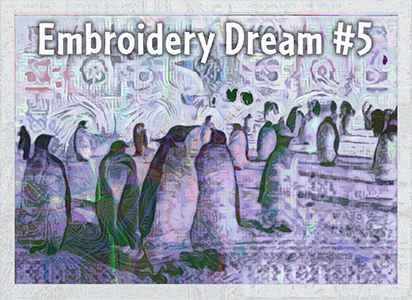
Time to start another series exploring the potential of Google's Deep Dreams neural net graphic generator. This time, the original images are coming from a 1604 German book of embroidery patterns, called Newes Modelbuch in Kupffer gemacht : darinen allerhand Arth newer Mödel von dün, mittel vnd dick aussgeschnidener Arbeit, auch andern künstlichen Nehwerck zu gebrauchen mit Vleiss inn Druck verfertigt (Google Translation makes no sense: "News Model book in copper made: in it all kinds of Arth newer model of dün, medium thick VND aussgeschnidener work, also other artificial Nehwerck to use with Vleiss Inn manufactured pressure").
Source:
Link1 archive.org/details/gri_33125001060827
September 19, 2015
Wooden Grills Dreamscoped
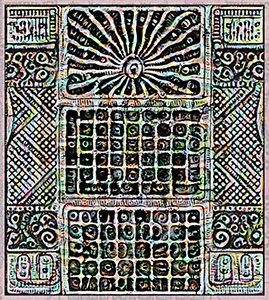
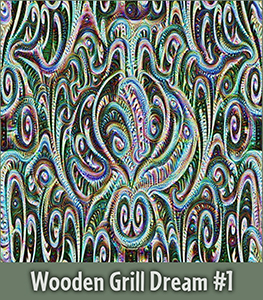
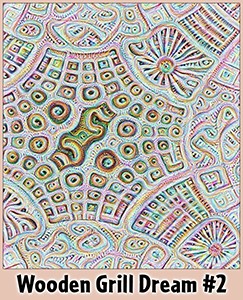
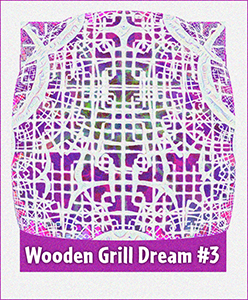
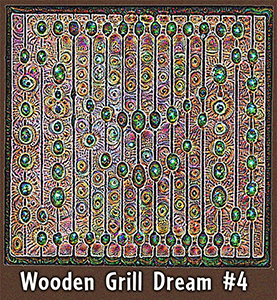
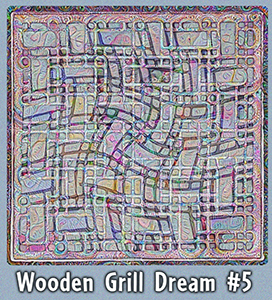

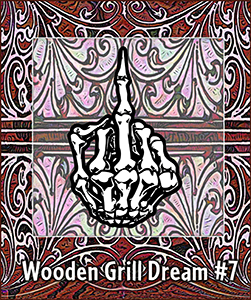
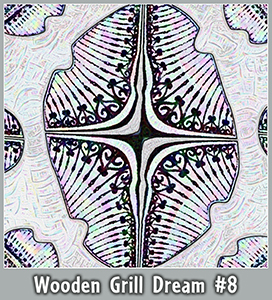
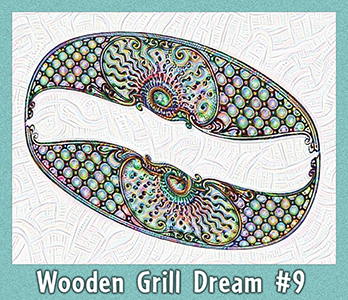


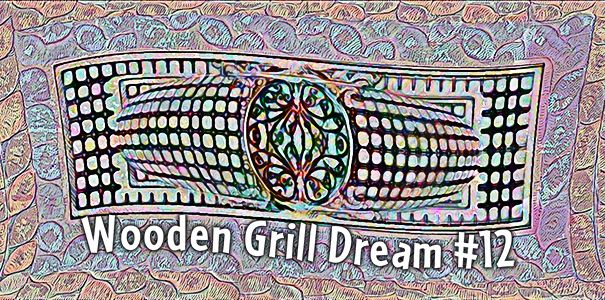
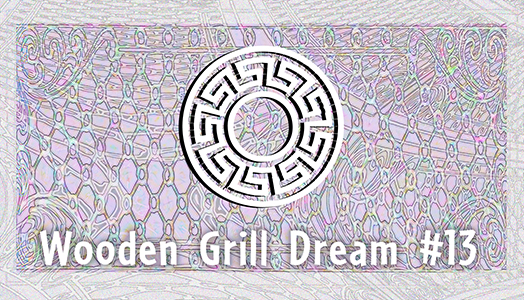
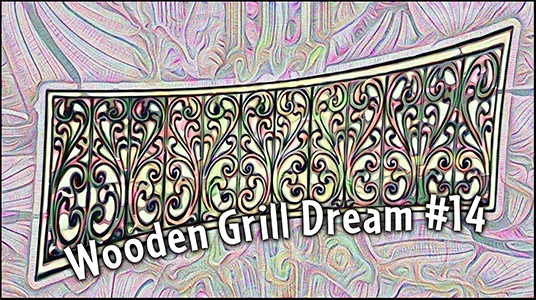
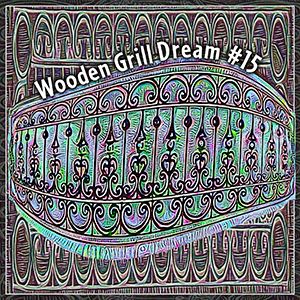
Starting a series based on designs from an 1895 trade catalog, Modern art grilles, which shows pen-and-ink sketches of ornamental wooden grills sold by Boston's Jordan Marsh, an early all-in-one downtown department store. A grill pictured in the 120-year-old catalog is sent through the ultra-modern Google Deep Dreams neural net graphic filter. Other filters come from Gimp, Photoshop, Corel PaintShop, and Corel Painter. But each image includes at leat some work on Dreamscope.
Source:
Link1 archive.org/details/JordanMarshCoCCA90042
September 12, 2015
Portrait Painting by Greuze
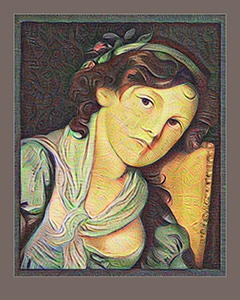
From a 1908 German book Album der Alten Pinakothek zu München : fünfzig Farbendrucke, mit begleitenden Texten und einer historischen Einleitung (Google Translate: "Album of the Alte Pinakothek in Munich : Fifty -color prints , with accompanying texts and a historical introduction
"), a portrait painting by French genre painter Jean Baptiste Greuze. His biography is interesting: rebuffed by the Academy, because of one painting, he withdrew from the Art world until the French revolution and died penniless.
Source:
Link1 archive.org/details/gri_33125008035673
September 11, 2015
Phony Physiognomy on Russian Ornament
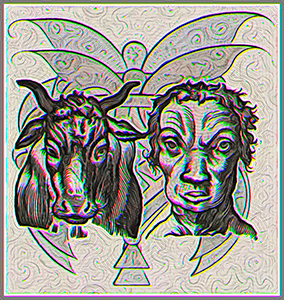
From a 1655 book about the (psuedo-)science of physionomy, an illustration of the supposed similarity between human and animal faces. The book is La physionomie humaine de Iean Baptiste Porta neapolitain, divisée en quatre liures : enrichie de quantité de figures tirées au naturel, ou par les signes exterieurs du corps, on voit si clairement la complexion, les mœurs, & les desseins des hommes, qu'on semble penetrer iusques au plus profond de leurs ames (Google Translate: "The human face of Iean Baptiste Porta neapolitain , divided into four livres : enriched amount of figures from natural or by the external signs of the body, if we see clear complexion , manners , and the designs of men, that iusques seems to penetrate to the depths of their souls ") (Link1), which seems to put forward some primitive conception that human temperament corresponds to facial similarity to animals. The picture of a man and cow is superimposed on an ornament from the 1870 Histoire de l'ornement russe du Xe au XVIe siècle d'après les manuscrits (Google Translate: "History of the tenth to the sixteenth century Russian ornament from the manuscripts") (Link2).
Source:
Link1 archive.org/details/gri_33125008642148
Link1 archive.org/details/gri_33125008542165
September 10, 2015
Announcement for Plastic Club Website

As a member of Philadelphia's old-line art organiation, The Plastic Club, I provided the following graphic for their Member's Showcase page. It was rejected and I was told that I could get a page in October and I had to follow the format of other artists' pages.
Source:
NA
September 9, 2015
indian Chief and Wife
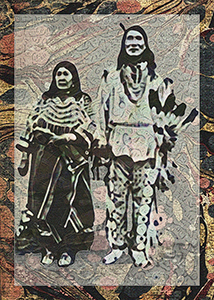
A photo of a Blackfoot leader and his wife from the 1916 Un apôtre du Nord-Ouest Canadien : le P̀ere Lacombe, "L'homme au bon coeur" : d'apr̀es ses mémoires et souvenirs recueillis par une soeur de la Providence, which tells the story of Pere Lacombe, the Canadian missionary. The picture is labelled 'Onistarse Stamik.'
Source:
Link1 archive.org/details/unaptredunordoue00laco
September 8, 2015
Middle East Costume
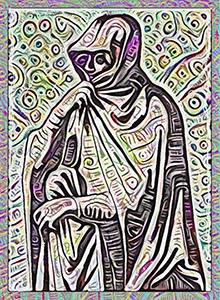
An illustration from Nicolas de Nicolay's 1580 travel book, Le nauigationi et uiaggi, fatti nella Turchia, di Nicolo de'Nicolai del Delfinato, signor d'Arfeuilla, cameriere, & geografo ordinario del Re di Francia, con diuerse singolarità uiste, & osseruate in quelle parti dall'autore, showing an Algerian woman's costume.
Source:
Link1 archive.org/details/gri_33125010923114
September 7, 2015
Illustration from Storybook
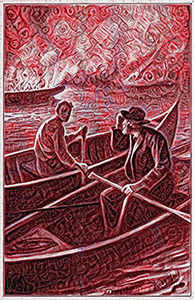
After all my experiments with the Dreamscope application effects (mainly on snapshots of young women of today's selfie generation), an attempt to apply the lessons learned to my previous public domain work. Here, an illustration by Frank T. Merrill from an 1824 boys' adventure novel, The red pirogue : a tale of adventure in the Canadian wilds, showing the young hero in a canoe talking to an old man as they drift next to a burning boat. Not pleased with the result. Would have preferred a style closer to the later Dreamscope images, with a more woodcut/engraved look. Maybe the problem was that the original was a scan of a dot-screened book image, not a pure digital image like the Dreamscope images.
Source:
Link1 archive.org/details/redpiroguetaleof00robe
September 6, 2015
Riffs on Dreamscope Images
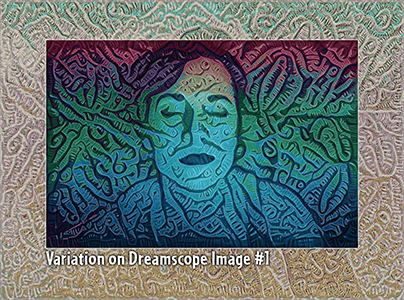
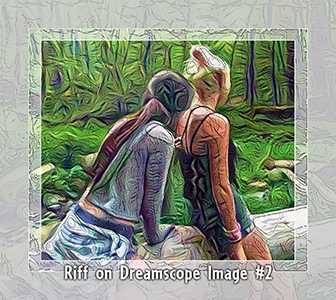
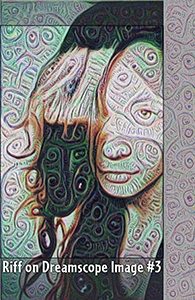
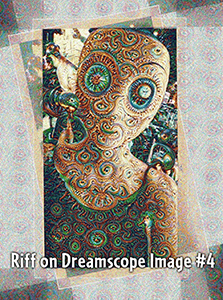
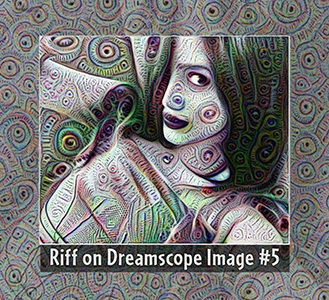
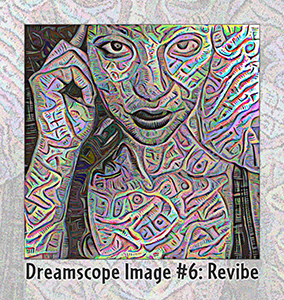
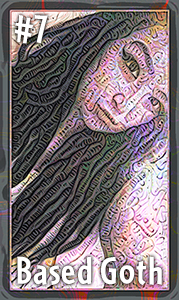
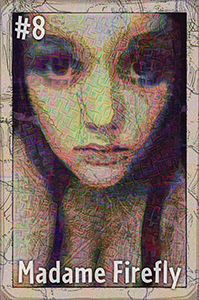
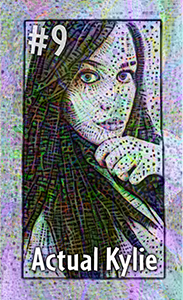
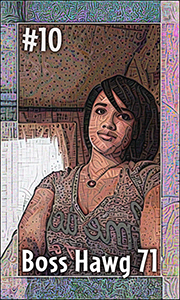
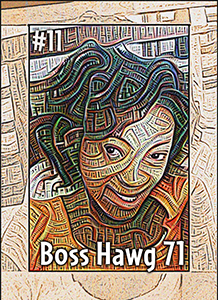

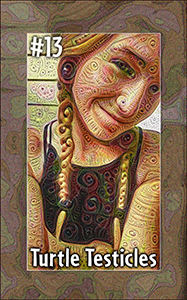
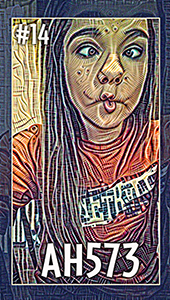
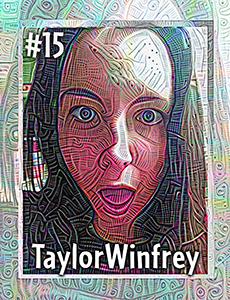
More variations on images uploaded to the Dreamscope filter page, one of the sites which uses Google's Deep Dream image processing method. Again, it is difficult to keep track of the photographers' names; when a Dreamscope user "shares" an image, it is only visible for a few minutes without laborious navigation. I apologize to the photographers.
9/1: Figured out a change in work flow that in some cases will allow me to record the author/photographer of an image. For instance, the photographer of #5 is called 1990, #6 is Revibe, #7 is Based Goth, #8 is Madame Firefly, #9 is Actual Kylie, #10 and #11 are by Boss Hawg 71, #12 is AudreyMarie9, #13 is Turtle Testicles, #14 is AH573, #15 is TaylorWinfrey.
9/3; In a related development, computer scientists are working on training neural nets to follow different artist styles. Here is an example. And more here. A small collection of "Deep Style" images.
.
Source:
NA
August 31, 2015 - September 1, 2015
Oliver Sacks Quote
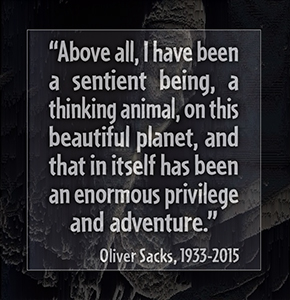
A quote from Oliver Sack's essay in the New York Times after he learned he had inoperable liver cancer. His upbeat and philosophical attitude -- much like Jimmy Carter is in the same situation -- is bracing. (In a great moment in humanitarian neo-machismo, Carter famously said "I'd like for the last guinea worm to die before I do.") But in Sack's case, a depressing footnote to his life is that he was a gay man who remained celibate until late in his life.
Source:
NA
August 31, 2015
Heraldic Frontispiece
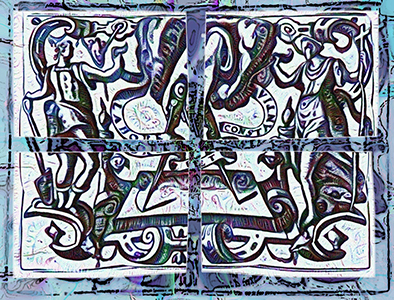
A frontispiece illustration to a 1590 book on war-making machinery by the Flemish Justus Lipsius, Poliorcetic[o]n, sive, De machinis, tormentis, telis, libri qvinqve : ad historiarum lucem (Google Translate: Poliorceticon, or, of the engines , and engines , weapons and books qvinqve: to the stories of the light). The motto displayed is "Laborem et Constantia", or Constant Labor.
Source:
Link1 archive.org/details/gri_33125014521658
August 30, 2015
Fantasia with Google Dream Girl
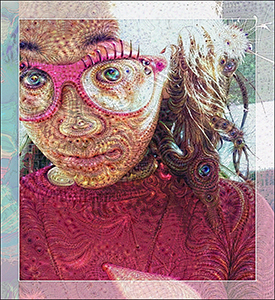
One of the strange images uploaded to the Dreamscope filter page. There is no identification of the subject, nor is there a way to contact the artist; so I just download the ones that catch my eye and sssume they are public domain. Here, a young girl in silly glasses is superimposed on a barely visible design from an old book.
Source:
NA
August 29, 2015
The Autumn Crunch of Football
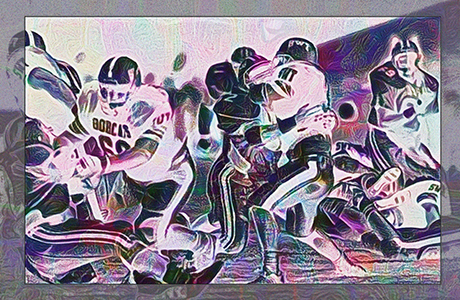
Most of the images in the Texas State University photo archives have to do with football.
Source:
Link1 www.flickr.com/photos/txstate-library
August 28, 2015
Ordinary Moment at a Soda Fountain
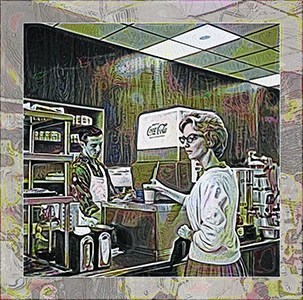
Another scene from the Texas State photo archives. An everyday 1963 scene, a swan-necked co-ed in a bubble hairdo reaches out for a paper cup -- is it Coca-Cola? do the two straws indicate a milk shake? -- prepared by the young attendant behind a campus soda fountain. She is dressed in the fashion of the time, with a bulky sweater and billowing skirt. She carries a clutch bag and wears the rakish eyeglasses of the time, The attendant lacks only the typical white food servers (soda jerk) cap of the time.
Sometimes, I view my artistic explorations of public domain graphics as a kind of mournful longing for a culture and way of life that may soon disappear because of planetary political conflict and environmental collapse. I am very pessimistic about the future of humanity -- as my privileged postwar generation knew it. I wish there was something I could do about it except vote Democratic. Young people with their vampire and zombie movies and cruel Hunger Games pitting all against all for survival seem to sense an oncoming collapse. Gone are the reassuring heroic Westerns of my youth, where the community comes together to protect itself from some threat.
I actually tried to read a book on the spiritual dimensions of all this, Love in the Age of Ecological Apocalypse, but it was very unsatisfying New Age nonsense.
Source:
Link1 www.flickr.com/photos/txstate-library
August 27, 2015
Baton Twirler Warms Up
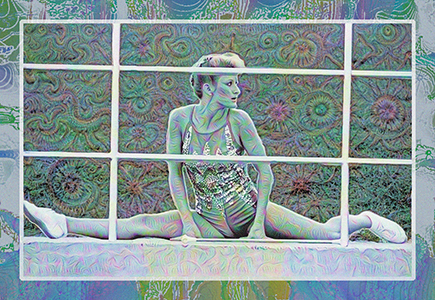
Again from the Texas State photo archives from the 1963 football season, the Bobcats' baton-twirler relaxes and stretches before a performance. Look at her expression: she does not seem happy or relaxed. 1963 was the year I was a senior in college, so I was born about the same time she was. She reminds me of an ex-girlfriend who was a great beauty and college athlete (water gymnastics) but had a hard time achieving simple joy and contentment before she died.
Source:
Link1 www.flickr.com/photos/txstate-library
August 27, 2015
Texas Cowgirl Cheering Section
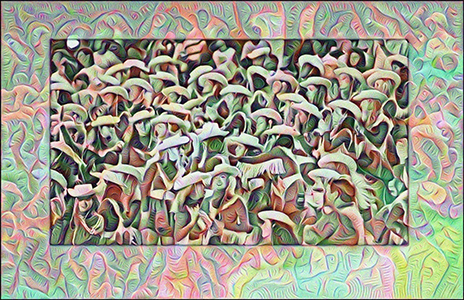
The Flickr.com Commons received contributions of scans from a new archive, Texas State University, mainly from the 1963 football season. Here is a shot of the Bobcats' fans, dressed in cowboys hats and leather fringed vests.
Source:
Link1 www.flickr.com/photos/txstate-library
August 26, 2015
Blonde on Mexican War
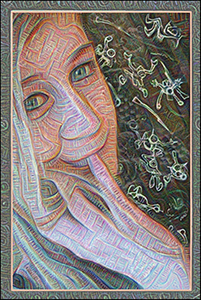
Foreground is one of the young women sent through the Dreamscope filter. The images are displayed for just a few minutes and copyright is apparently not claimed. (Sorry to her and whoever took her picture for lack of credit information.) Background is one of the political cartoons from the 1880 A Comic History of the United States by Livington Hopkins. The cartoon shows a bird's-eye view of the Mexican War. Hopkins' work is little-known and I recommend a look-over.
Source:
Link1 archive.org/details/gri_33125013775057
August 26, 2015
Plaster Ceiling
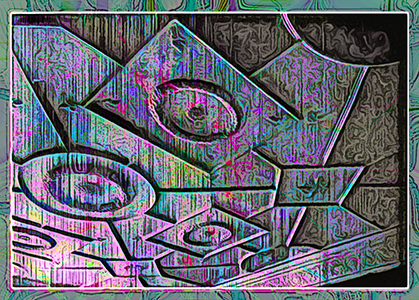
From the 1908 The art of the plasterer; an account of the decorative development of the craft, chiefly in England from the XVIth to the XVIIIth century, a photograph of a stucco ceiling at Daneway House, in Cirencester.
Source:
Link1 archive.org/details/artofplastererac00bank_0
August 25, 2015
Goya's The Prisoner
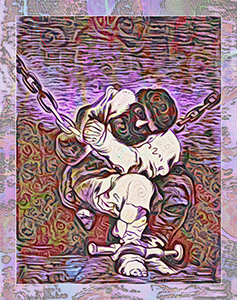
Spanish artist Francisco Goya lived through the now largely-forgotten Peninsular War between Napoleon and the Spanish (and other allies). In a series of engravings called The Disasters of War, he expressed his disgust at the atrocities of that war. From that series, this engraving is called The Little Prisoner. It appears in the 1867 Goya : sa biographie, les fresques, les toiles, les tapisseries, les eaux-fortes et le catalogue de l'oeuvre. Early in his life, Goya was a skilled Romantic painter, but later, his work turned very dark so we could see him, in modern terms, as a victim of Post-Traumatic Stress Disorder.
In this manipulation, the effect of the Dreamscope filters is very evident.
Source:
Link1archive.org/details/gri_33125004500100
August 25, 2015
Brigham Young Family Outing, Aerial View
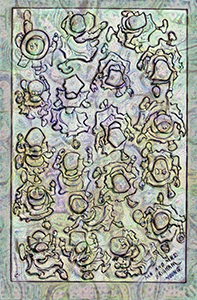
A cartoon from the 1880 A Comic History of the United States by Livington Hopkins. It shows Mormon leader Brigham Young, in the top left corner, with some of his 55 bonneted wives. Hopkins finished the History in time for the 1876 U.S. Centennial, but because of Hopkins' iconoclastic wit, it was not a best seller. In 1882, "Hop" moved to Australia, where he was a cartoonist for the Sydney-based Bulletin.
Source:
Link1 archive.org/details/gri_33125013775057
August 25, 2015
French Fable
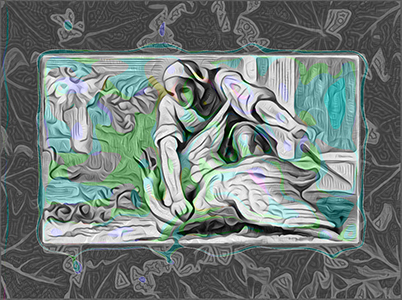
An illustration from an 1882 reissue of Fables de La Fontaine: Précédées de la Vie d'Ésope containing the stories of Jean La Fontaine. This one illusdtrates the fable of the Swan and the Cook. The swan shared a yard with a number of geese; the geese were used for cooking, the swan was decorative. One day, by mistake, a cook took the swan to put in the cooking pot.
The bird's complaint resoundedThe moral of the fable, La Fontaine explains, is
In glorious melody;
Whereat the cook, astounded
His sad mistake to see,
Cried, "What! make soup of a musician!
Please God, I'll never set such dish on.
No, no; I'll never cut a throat
That sings so sweet a note."
"'Tis thus, whatever peril may alarm us,The illustrations is by the romantic Swiss painter Karl Girardet.
Sweet words will never harm us."
Dutch Architect
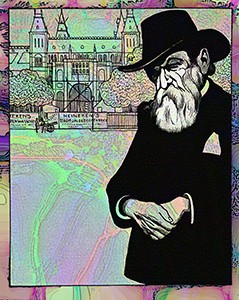
A portrait of Dutch architect Pierre Cuypers by Dutch political cartoonist Albert Hahn (1877-1918) in his 1906 picture book Het land van Rembrandt (The Land of Rembrandt). Hahn was an antiwar activist and Socialist. One of his famous works shows a civilian trapped on the electrified Dead Wire fence erected by the Germans between Belgium and the Netherlands during World War I.
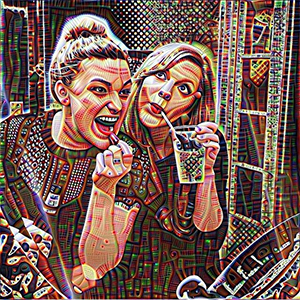
What's Been Happening
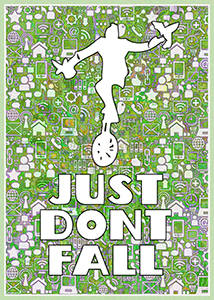
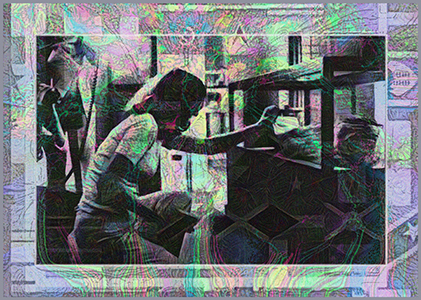
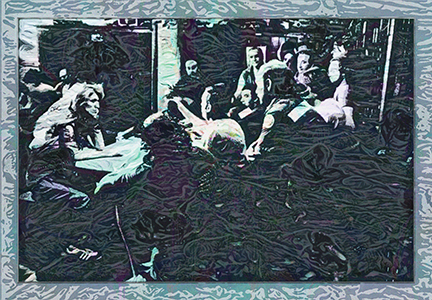
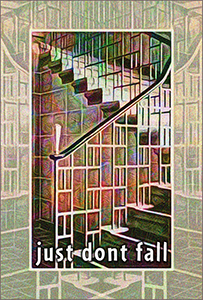
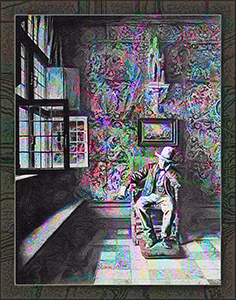
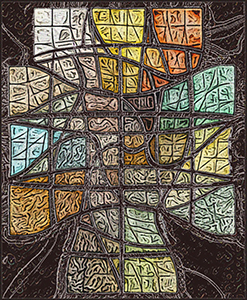
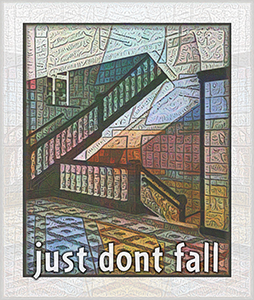
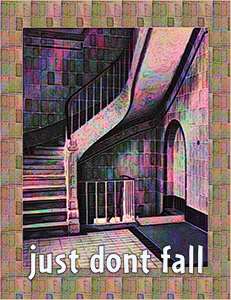
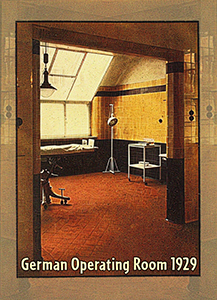
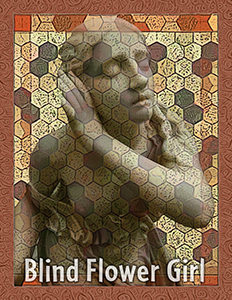
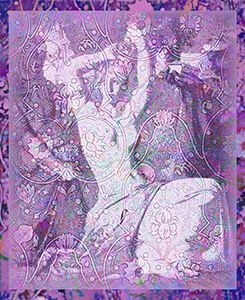
When I go through wordless periods, like the one that just passed, this usually means I am thinking about something. Since July 18, when I ran across a reference to Dreamscope, an online version of Google's hot-topic Deep Dream, I have experimented with this neural-net-based image generator, developing a technique different from my normal technique. Some examples above.
What is exciting is that i am more than usually familiar with the technical details (Link1) of the Deep Dream project, knowing something about both the computer language Python and about neural nets from my old, fruitless work on the market forecaster Predicto. The vexing question is whether my 70.6-year-old brain still has the flexibility to climb such steep learning curve.
Source:
Link1: blog.jetbrains.com/pycharm/2015/08/googles-deep-dream-in-pycharm/?utm_source=Python+Weekly+Newsletter&utm_campaign=767b1d882f-Python_Weekly_Issue_204_August_13_2015&utm_medium=email&utm_term=0_9e26887fc5-767b1d882f-312720201
August 10-15, 2015
R-r-r-riffs While Ruminating
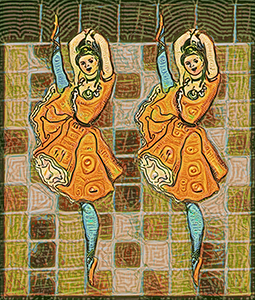
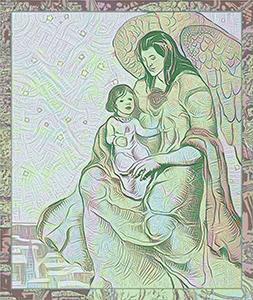
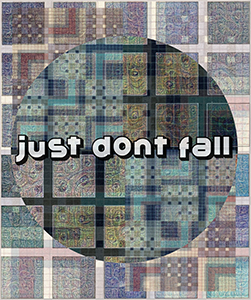

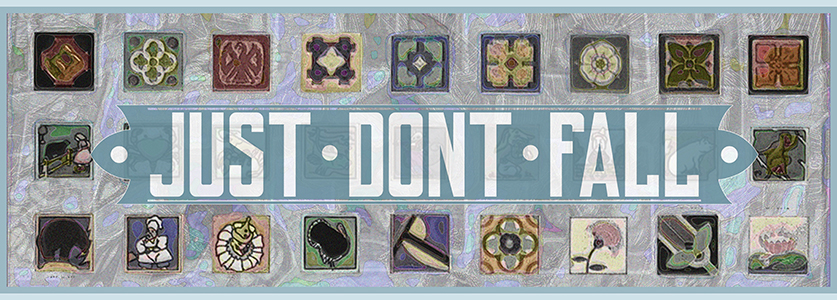
First image is from the 1911 [Hans Christian] Andersen's Best Fairy Tales illustrated by William P. Henderson. Followed by various riffs on images from the 1939 HandBook of Mosaic Clay-Tiles, where "mosaic" seems to the name of the company, Mosaic Tile Co. of Zanesville, Ohio. Font in the first "Just Dont Fall" scarf is Gribal by Studio Typo, in the second and third is York Whiteletter by UK-based Pilaster Davy.
Source:
Link1 archive.org/details/Sweets1939812Cat26
Link2: archive.org/details/andersensbestfai00ande
August 4-9, 2015
Gates and Locks
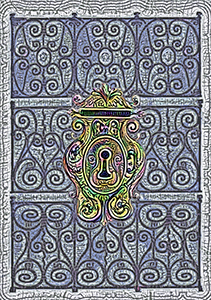
Some iron work -- gates and a lock cover -- from the 1814 The American artist's manual, or, Dictionary of practical knowledge in the application of philosophy to the arts and manufactures : selected from the most complete European systems, with original improvements and appropriate engravings : adapted to the use of the manufacturers of the United States.
Source:
Link1 archive.org/details/gri_33125011898281
August 3, 2015
Gears, Just Dont Fall!
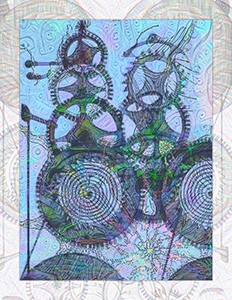
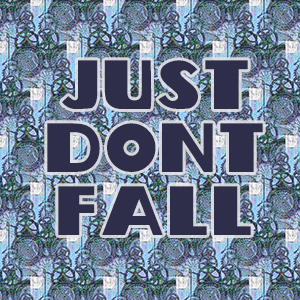
A diagram of gears (a clock, perhaps) from the 1814 The American artist's manual, or, Dictionary of practical knowledge in the application of philosophy to the arts and manufactures : selected from the most complete European systems, with original improvements and appropriate engravings : adapted to the use of the manufacturers of the United States. Next to the digitally dizzified diagram is a return to the continuing graphic challenge, a wish for all my friends, JUST DONT FALL.
Source:
Link1 archive.org/details/gri_33125011898281
August 3, 2015
Early Descending Staircase
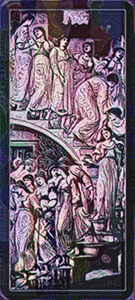
From the 1898 The painter in oil : a complete treatise on the principles and technique necessary to the painting of pictures in oil colors, a reproduction of Pre-Raphaelite artist Edward Burne-Jones' 1880 "The Golden Stairs."
Source:
Link1: archive.org/details/gri_33125012646291
August 1, 2015
Dutch "TimeWarp," Other Scenes
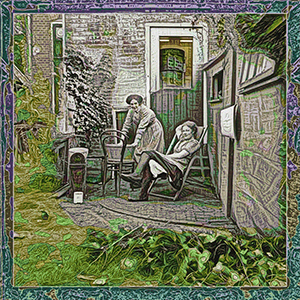
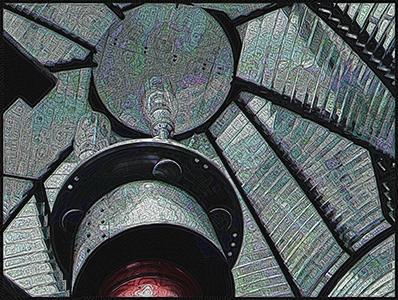
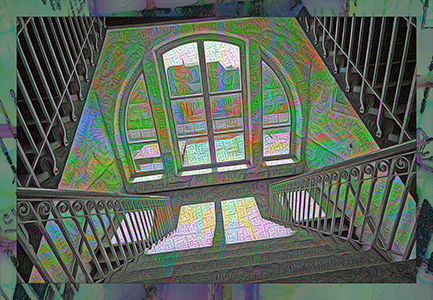
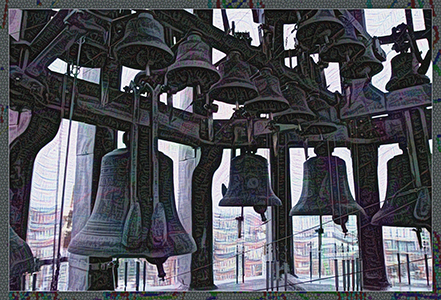
From the Flickr.com Commons archive from the Regionaal Archief Alkmaar in North Holland, a "TimeWarp" photo -- a backyard scene from two different eras superimposed, one color in 2014, one black and white, undated. Next to that, a view of a fresnel lens in a lighthouse, and a stairway in an abandoned school; and a carillon.
Source:
Link1: www.flickr.com/photos/archiefalkmaar/15337860947/in/album-72157632593064270/
July 30, 2015
Finnish Artist Working on Murals
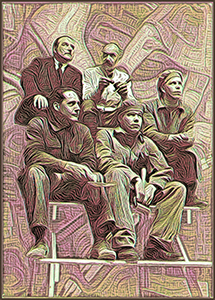
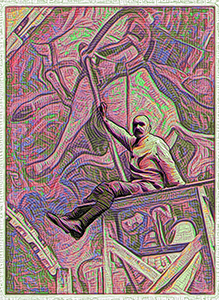
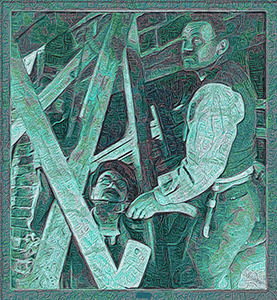
From the Flickr.com Commons archive from the Gallen-Kallen Museum in Finland, dedicated to the works of Akseli Gallen-Kallela, two images showing his work on oversize murals. In the left, he is shown (top right) sitting with his assistants. In the center, he is shown atop the scaffolding used to paint the murals. In the right, Gallen-Kallele and an assistant on a mural scaffolding.
Source:
Link1: www.flickr.com/photos/gallen-kallelanmuseo/
July 26, 2015
Plumbing Repair
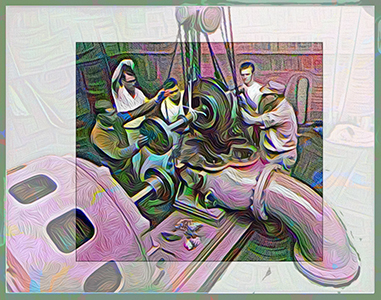
From the Flickr.com Commons archive from the State of Virginia, a crew of five workers reassemble a water pump in Byrd Park, Virginia.
Source:
Link1: www.flickr.com/photos/library_of_virginia/2898506709/in/album-72157607704129043/
July 25, 2015
After Catheterization II
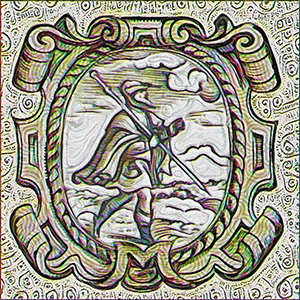
Again from the 1603 Doni book, a more optimistic and confident view of the future. A heraldic emblem shows a jaunty, bearded walker, with a stick over his shoulder, strolling through the rolling countryside.
Source:
Link1: archive.org/details/imarmideldoniaca00doni_0
July 24, 2015
After Catheterization
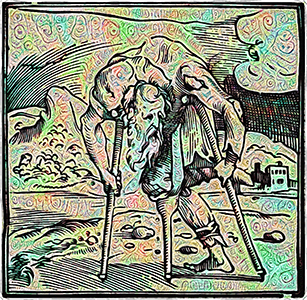
The recent concerns with health issues, for both Janice and myself, has altered my view of my self. Here, from a Renaissance book of stories by Italian writer Anton Francesco Doni, an engraving that illustrates this adjusted view of ourselves. (Smile) Doni is a wild-eyed mystical early humanist, little known in the English-speaking world. The illustrations in his book I marmi del Doni, academico peregrino, cioè, Ragionamenti introdotti a farsi da varie conditioni d'huomini, à luoghi di honesto piacere in Firenze (Link1, Google Translation: The marbles of Doni , academic pilgrim , that is, to step Ragionamenti introduced various general conditions of huomini, a place of pleasure honesto in Florence), are entertaining.
Source:
Link1: archive.org/details/imarmideldoniaca00doni_0
July 23, 2015
Lady Liberty Holding Out an Olive Branch
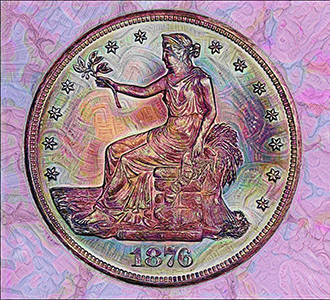 From the cover of a 2009 issue of a numismatists' magazine, The Gobrecht Journal for Collectors of the Liberty Seated Coin Series (LInk1), an 1876 coin with interesting discolorations. The magazine is dedicated to collectors of the coins of Engraver Christian Gobrecht and of the Seated Liberty series of U.S. coins.
From the cover of a 2009 issue of a numismatists' magazine, The Gobrecht Journal for Collectors of the Liberty Seated Coin Series (LInk1), an 1876 coin with interesting discolorations. The magazine is dedicated to collectors of the coins of Engraver Christian Gobrecht and of the Seated Liberty series of U.S. coins.
Workers in Turkish Pasteurized Milk Factory, 1939
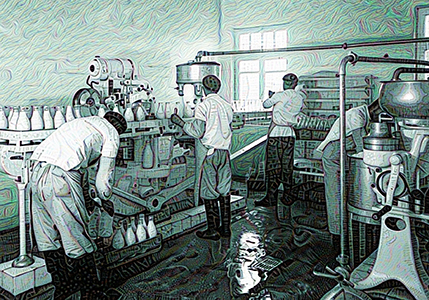
From the Flickr Commons archive of images from Turkey, a 1939 photo in the milk processing room of the Ataturk Forest Farm.
Here's the text with the picture:
"Wine and Juice Factory and Beer Factory were founded in 1925 and 1933 respectively. Pasteurized Milk Factory, yogurt, butter and cheese plants were opened. Ice Factory was able to produce 4 tonnes of ice daily."Done solely using DreamScope filters.
Perfect Swan Dive in a Turkish Park, 1939
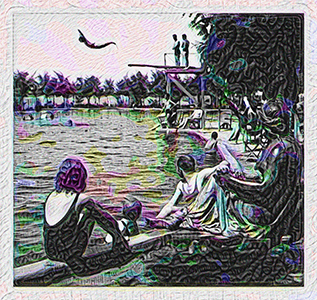
From the Flickr Commons archive of images from Turkey, a 1939 photo of the "Black Sea Pool" in Ankara's Ataturk Forest Farm.
Here's the text with the picture:
"People in Ankara used to come to the Gazi (Ghazi) Forest Farm by cars, buses and the train. During fine weather, they wouldn’t even acknowledge each other and just walk. The small, pretty train station building was built in 1928 and designed by architect Ahmet Burhanettin Bey. During holidays, it was possible to see people having picnics under thick trees. Marmara and Karadeniz (Black Sea) were pools which might have satisfied the need for a sea to some extent. People used to organize rowing and swimming contests between schools."Again, experimenting with DreamScope filters.
Workers in Istanbul Cigarette Factory, 1940s
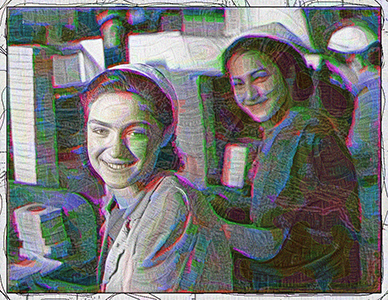
From the Flickr Commons archive of images from Turkey, a photo of female workers in the Cibali Cigarette Factory in the 1940's. In 1995, the factory was closed and turned into the modern Kadir Has University.
Still experimenting with DreamScope filters. Challenge is adjusting the colors.
From
Source:
Link1: www.flickr.com/photos/128445772@N04/16944335438/
July 19, 2015
Another Mexican Woman in Costume
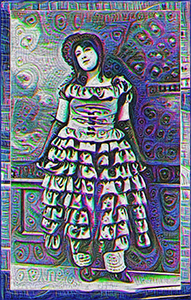
From the Flickr Commons archive of images from the Mexican state of Sinaloa, an undated photo of a young woman dressed in satin or taffeta costume. Besides my usual Photoshop, Gimp, and Paintshop filters, some additional processing from a set of relatively new filters on DreamScopeApp.
Source:
Link1: www.flickr.com/photos/99115493@N08/19183434271/in/album-72157655082651532/
July 18, 2015
Mexican Festival Queen 1939
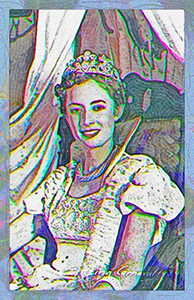
From the Flickr Commons archive of images from the Mexican state of Sinaloa, a publicity shot of the young woman chosen to preside over the 1939 Sinaloa Carnival. A caption reads "Clarita I, Reina Carnaval 1939" (Clarita I, Carnival Queen 1939).
Source:
Link1: www.flickr.com/photos/99115493@N08/19174105582/in/album-72157655082651532/
July 17, 2015
Mexican Woman Poses on Car
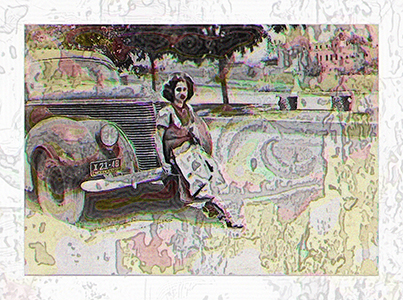
From the Flickr Commons archive of images from the Mexican state of Sinaloa, a snapshot of a young woman sitting next to the massive radiator of an old 1930's car, along a riverbank. The image is overlaid with texture from a crumbling decorated stucco wall in a crumbling ruin in the 16th-century Spanish settlement of Mocorito.
This is an image in which traditional photographic detail is dropped or obscured, as I attempt to duplicate the effect of a fading memory or dream.
Sinaloa is also the home of an infamous drug cartel, whose boss recently made a daring and well-funded escape from prison.
Source:
Link1: www.flickr.com/photos/99115493@N08/
July 17, 2015
Billy Goat and Boy
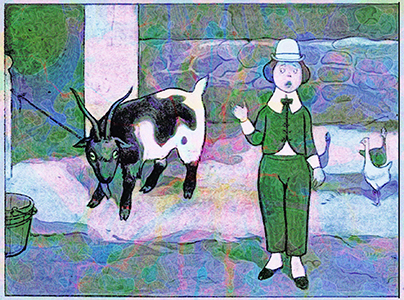
Illustration from an 1899 book of children's poetry, by Peter Newell. Ths poem associated with the image is this:
A VICIOUS GOATExperimenting with uploading this image to VOAT, which has risen as a replacement to the popular board REDDIT and uses a goat as as mascot. As a first step, uploaded image to IMGUR.COM, then uploaded link to that to VOAT.CO's "Whatever" subverse.
I do not love my billy-goat, I wish that he were dead
Because he kicked me, so he did -- he kicked me with his head.
Artist Painting Wall Mural
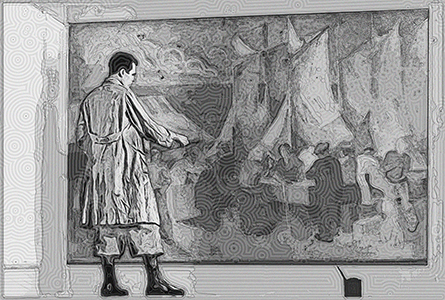
From the online Flickr commons archive of the Aalto University in Finland, a 1930 photo of a student artist painting a wall mural of a seaport market. Here's Flickr's introduction to the Aalto archive.
Source:
Link1: www.flickr.com/photos/aaltocommons/14150014887/in/album-72157644927475122/
July 15, 2015
Nature's Profusion
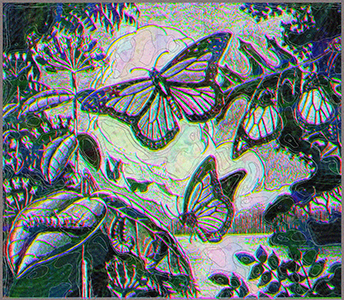
Cover illustration from the August 1942 edition of The Chicago Naturalist by W.J. Beecher.
Source:
Link1: archive.org/details/ChicagoNaturalistV5N2
July 14, 2015
Death of an Actor: Janice's Off-Broadway Past
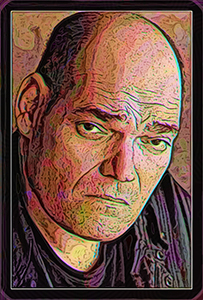
Janice was just ending her career as an Off-Broadway actress when I met her 30 years ago. When I first stayed at her place in the West Village, I heard answering machine messages from playwright Donald Kvares begging her, "darling," to take a role in his latest work. She had a trunk full of costumes that served us for many Halloweens. Ever since, she has shared her strong opinions on acting performances with me.
Sad news from those days: her old acting friend Irwin Keyes died.
Janice and Irwin auditioned together at the Actors Studio playing a scene from John Steinbeck's Of Mice and Men, where Irwin played the simple-minded brute Lenny and Janice played Curley's flirtatious wife, whom poor confused Lenny murders. Here's the scene played in Hollywood, with John Malkovich as Lenny and Sherilee Fenn as Curley's Wife.
Irwin was a sweet, lovable guy, despite his terrifying bad-guy stage persona. But when we met, he gave me his fiercest theatrical scowl and said "You better be good to Janice..." with an implied underworld "or else..."
Source:
NA
July 14, 2015
Another Just Dont Fall
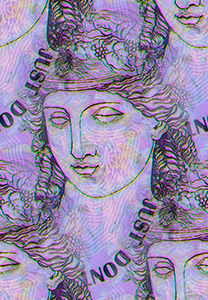
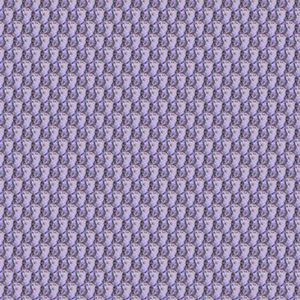
From the 1816 Of statuary and sculpture among the antients [i.e. ancients] : with some account of specimens preserved in England (Link1), by James Dallaway, a head figurine, tresses decorated with fruit, with an obscured JUST DONT FALL motif, and a 24"x24" pattern based on that.
Source:
Link1: archive.org/details/ofstatuarysculpt00dall
July 11, 2015
Welsh Beggar Woman
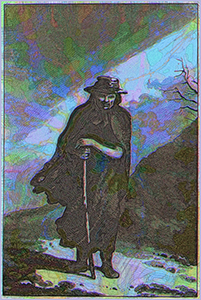
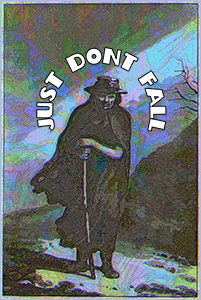
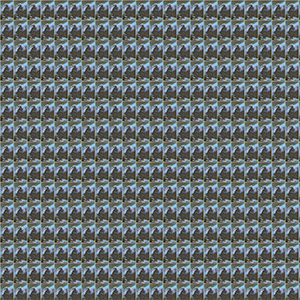
From the 1815 Journal of a tour and residence in Great Britain, during the years 1810 and 1811: with remarks on the country, its arts, literature, and politics, and on the manners and customs of its inhabitants (Link1), by Louis Simond: a picture of a Welsh beggar woman. Next to that, a fabric element with the JUST DONT FALL motif, and a 24"x24" pattern based on that.
Source:
Link1: archive.org/details/gri_33125012633232
July 9, 2015
Fourth Try at Fabric Design


Source: NA
July 9, 2015
Online Drama
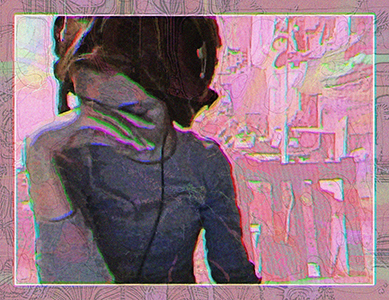
A young girl slumping sadly after reading something on the computer screen. Women are treated shamefully in male-oriented online chat boards; greeted with TGTFO or routinely called cum dumpsters. Those who protest at this treatment are called SJW's. Online anonymity allows antisocial young NEETs living in a parent's basement to lash out at women, jews, blacks, etc. It's an ugly online cyberspectacle that I guiltily observe. I watch four of them: (1) 4chan.net, (2) 8chan.net, and the bruising battle for millenial eyeballs between Ellen Pao's (3) Reddit and newcomer (4)Voat. I monitor them for the occasional spark of brilliance and the fuck-it-all mood of alienated rebellion. These may, after all, be the Last Days -- with climate change and widespread species extinctions, possibly including our own. Besides there's always the angry guys that post their girlfriends' nudes after painful break-ups and the tech-savvy soldiers discussing world military affairs.
Source: NA
July 8, 2015
Third Try at Fabric Design
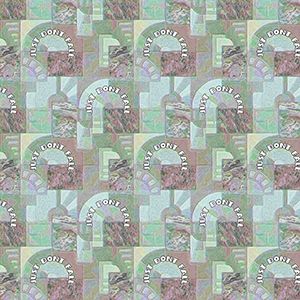
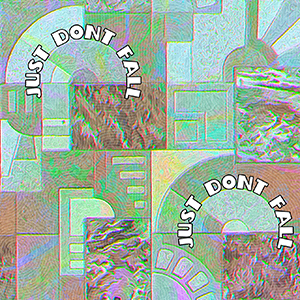
This is part of a plan for a fabric design for seniors, built around a theme of JUST DONT FALL. The advertising goes like this:
The mysterious woman in the blue cape
slipped you an envelope sealed with wax
and asked you to deliver it
to an address in Kansas City.
She said you would be amply rewarded.
You're retired. You can do it.
The train costs $820 and takes 26 hours.
You can take a cab from the train station.
You can do it --
JUST DONT FALL
Source: NA
July 8, 2015
Second Try at Fabric Design
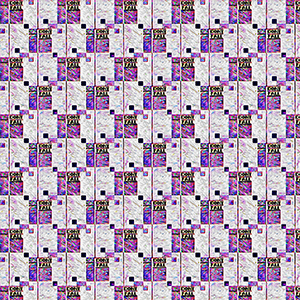
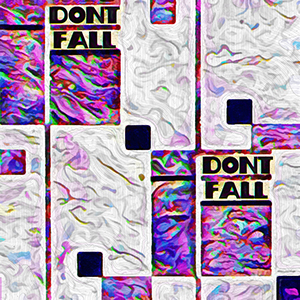
TBA
Source: NA
July 2, 2015
First Try at Fabric Design

TBA
Source: NA
June 28, 2015
Crane Illustration
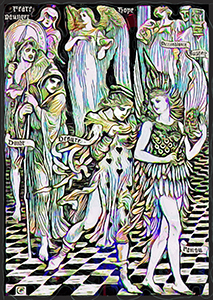
TBA
Source:
Link1: archive.org/details/gri_33125012663791
June 28, 2015
Cowboy Movie Star of the Past
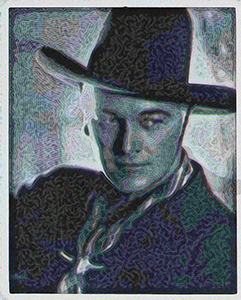
From the 1937-38 International Motion Picture Almanac (Link1), a publicity headshot of fictional cowboy Hopalong Cassidy. As a seven-year-old in 1951, he was my favorite. Grim passionless rectitude in a searing geologic desert. He was played by actor William Boyd, who took a big chance by putting all his money into the purchase of the rights to the fictional character. When the character made the successful transition from movies to television, Boyd won big.
You can watch an episode of Hopalong Cassidy here. Viewing it again, sixty years after it was aired, I was struck by one of the recurring themes of American existence: the greed of the rich. The plot involves a cynical conspiracy by a bank manager and a land developer to swindle an elderly greenhorn and his lovely daughter. I was also struck by a constant in action movies, then and now: the last third of the movie is filled with gunplay and chases that are rather boring and repetitive.
Sources:
Link1: archive.org/details/international193738quig
June 24, 2015
Soviet Film about Paris Commune
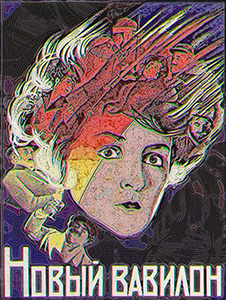
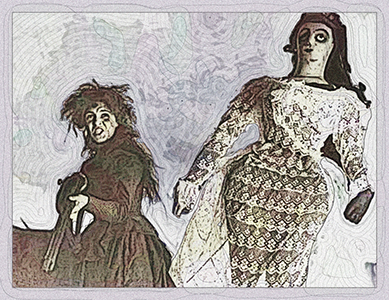
Spending a day in the Pennsylvania Hospital Family Room awaiting word on Janice's hip surgery -- good news: surgeon says it went well with no complications -- I ran across an unexpected decoration. Withut explanation or context, in a side room used for telephone conferences, there was a movie poster mounted casually on black poster board. The object (left) sparked my curiosity and I found out that it was a poster for the 1929 The New Babylon, (Novyy Vavilon), a silent film about worker and citizen resistance during the 1871 Paris Commune. Right, is a scene from the film, when a tough "Communard" climbs a street barricade made of paving stones and department store dummies to defend the righteous workers' Commune against the "bourgeois" army intent on closing it down.
The film was enlivened by a score written by composer Dmitri Shoshtakovich and sensitive black and white photography of Parisian citizens. You can watch the movie with English subtitles here.
Sources:
NA
June 19, 2015
Turkish Wealth Tax
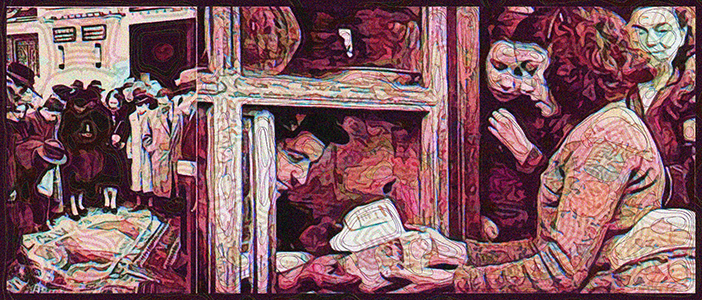
In 1942, the Turkish government, faced with possible invasion from Nazi Germany on the one hand and Russia on the other, imposed an unbelievably unjust tax, called the Varlik Vergisi: Muslims were taxed at 5% on fixed assets. Other ethnic groups were charged higher tax rates: Greeks, 156%; Jews, 179%; Armenians, 239%.
Inhabitants had just fifteen days to pay the tax, in cash. Here are two pictures from those hectic days; left, a crowd gather around to purchase rugs sold at distressed prices; right, two young women transfer money after another sale. It was an ugly scene, with many suicides and families condemned to debtor prisons in the country. There is 1999 Turkish film on the subject, Mrs. Salkim's Diamonds, available online, but without English subtitles.
Sources:
NA
June 15, 2015
Paraguayan Repression Victim
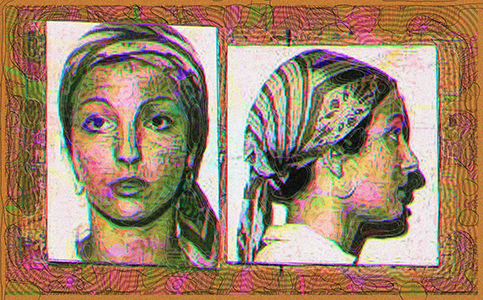
In 1992, a human rights advocate in Paraguay discovered the horrifying record of repression by latin American strongmen Augusto Pinochet of Argentina and Alfredo Stroessner of Paraguay, and others (Bolivia, Brazil, Chile, and Uruguay). The mass repression of progressive and leftist thinkers was known as Operation Condor. The documents found have been called the Archives of Terror. Torturers and totalitarians tend to keep good records, and here are the images from the record of one 29-year-old victim, Dora, who was one of 30,000 people who disappeared into the region's terror apparatus, along with 50,000 people murdered outright.
Sources:
Link1: archive.org/details/international193738quig
June 23,2015
Yawl in Storm
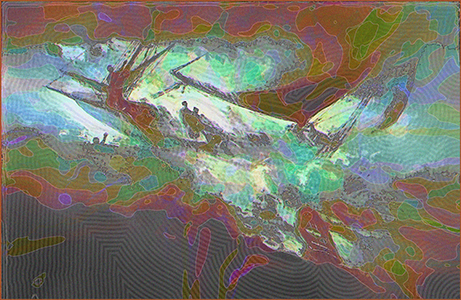
From a 1909 edition of Metropolitan Magazine, an illustration for a sailing story called The Sancified Man by T. Jenkins Hains. The story tells the adventure of a rich dandy with a 60-foot yacht who, on the recommendation of a local parson, takes on a passenger ("the sanctified man"). Turns out the passenger (a giant) is a recently released convict. It is not a great story -- but the backstory of the author is more interesting. Hains and his brother were involved in a murder (The Regatta Murder) that became front-page news. The resulting trial "played an important role in the development of criminal and matrimonial law." Disgraced after the trial, Hains wrote under a psuedonym and achieved a kind of accidental fame when a story he wrote for The Popular Magazine which seemed to prophecy the Titanic sinking hit the newstands just days before the actual event.
Doing a lot of work on my walkabout photos in Ten Thousand Steps. Rethinking my whole approach. In some ways, I feel as if my public domain work was mainly practice for developing my own style -- the way art students of the past spent years sketching old statues and copying paintings. On the other hand, I enjoy the historical and bibliographic adventures the public domain sources take me on. Like the Regatta Murder trial and the short story that prophesied the sinking of the Titanic. You can't make this stuff up!
Sources:
Link1: archive.org/details/bub_gb_g3rNAAAAMAAJ
June 15, 2015
Existential Risks
I have lately become interested in the issue of existential risk.
Here is an English resource on the subject: the Existential Risk page of the Oxford Future of Humanity Institute. Another resource is the Global Catastrophic Risk Institute.
Nick Bostrom recently wrote an important paper on the subject, Existential Risk Prevention as Global Priority.
May 24, 2015
Figures of Law Against Ceramic Tile
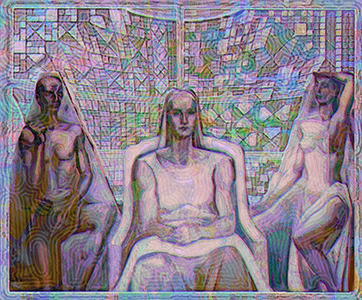
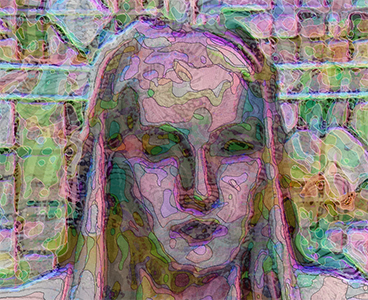
Another painting from the U.S. Department of Justice office in Washington, DC: a 1941 mural "The Continuity of Law," by Maurice Stern. (Link1)
The image is overlaid on a pattern formed by deforming a page of samples from the 1932 Lloyd floor and wall tile company catalog (Link2). Next to that, a detail.
Sources:
Link1: https://archive.org/details/pacerpostcards05unse
Link2: https://archive.org/details/CatalogNo32LloydFloorAndWallTileCompany
May 23, 2015
Birds Nest over Color Chips
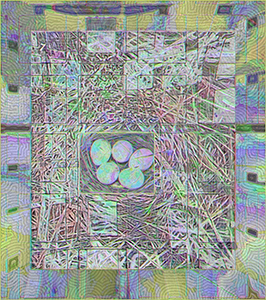
A photograph of the nest of a small beach raptor from a 1942 edition of Aquila (Link1), a magazine about birds. The image is overlaid on a pattern formed by deforming a page of samples from the 1932 Lloyd floor and wall tile company catalog (Link2).
Sources:
Link1: archive.org/details/aquila4649alli
Link2: https://archive.org/details/CatalogNo32LloydFloorAndWallTileCompany
May 21, 2015
Female Federal Office Workers
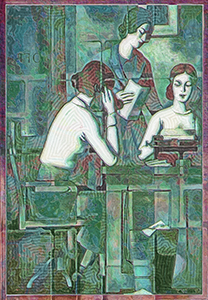
A photograph of a 1937 mural in the Department of Justice building in Washington, DC, entitled "Contemporary Justice and Women". It was uploaded as one of a series of postcards used in a petition campaign. (Link1) The artist is Emil Bisttram, who later became one of the interesting artists (along with Georgia O'Keefe) who moved to Taos, New Mexico. The picture is subtly overlaid on a sample of quarry tile from the 1932 Lloyd floor and wall tile company catalog (Link2).
Sources:
Link1: https://archive.org/details/pacerpostcards05unse
Link2: https://archive.org/details/CatalogNo32LloydFloorAndWallTileCompany
May 20, 2015
Dramas Behind Residence Windows
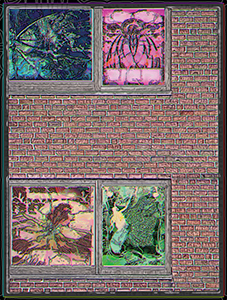
A sketch of a treatment for an upcoming Cityscapes show. My photograph of a section of our co-op's wall, with four window openings. In each window is a different book cover, thoroughly distorted and manipulated, from the 1903 bookbinding manualHandbuch der Buchbinderei eine leichtfassliche Anleitung zur Herstellung sämtlicher Buchbinderarbeiten (Link1).
Sources:
Link1: archive.org/details/bub_gb_K5c3AQAAMAAJ
May 18, 2015
Purple Orchid over Page Break Typographic Ormament
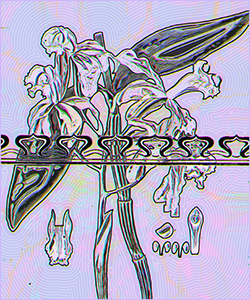
Frequently, when I "harvest" a bunch of new images, my first task is to choose the most challenging technical task. In this case, there was a nice flower split over two pages from the 1823 Exotic flora: containing figures and descriptions of new, rare or otherwise interesting exotic plants, especially of such as are deserving of being cultivated in our gardens : together with remarks upon their generic and specific characters, natural orders, history, culture, time of flowering, &c. (Link1). Could I combine the two halves into one whole orchid? Unfortunately, not so easy, so to cover up my messy joint, I imported a typographic ornament from the 1903 Handbuch der Buchbinderei eine leichtfassliche Anleitung zur Herstellung sämtlicher Buchbinderarbeiten (Link2).
Sources:
Link1: archive.org/details/bub_gb_7CcDAAAAMBAJ
Link2: archive.org/details/bub_gb_K5c3AQAAMAAJ
May 18, 2015
Composition in a Practical Vein
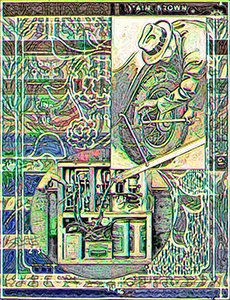
The two images in the foreground are from a 1933 Popular Science (Link1): in the rectangle in upper right, a diagram explaining how to adjust tension on tire chains for winter driving, and in the circle in the lower left, a homemade battery-powered radio. Also in the background is a diagram for a colored woodcarving from the same issue -- notice the "stain brown" instruction at upper left. These are laid over a woodblock illustration from the 1843 Sämmtliche Gedichte, a book of poetry (Link2). Again, the color in the background is from the 1923 Glass, paints, varnishes and brushes: their history, manufacture, and use (Link3).
Sources:
Link1: archive.org/details/bub_gb_7CcDAAAAMBAJ
Link2: archive.org/details/bub_gb_NWYHAAAAQAAJ
Link3: https://archive.org/details/GlassPaintsVarnishesAndBrushesTheirHistoryManufactureAndUse
May 17, 2015
Global Switchboard Operator
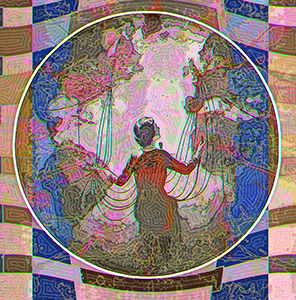
From an ad in a 1933 Popular Science (Link1), a switchboard operators juggles the world's cables in an advertisement from the the old American Telephone & Telegraph (AT&T). Also in the picture, barely visible, is a photograph of trees in the 1905 With Flashlight and Rifle: Photographing by Flashlight at Night the Wild Animal World of Equatorial Africa, by big game hunter Curt Schillings (Link2). The color in the background is from the 1923 Glass, paints, varnishes and brushes: their history, manufacture, and use (Link3).
Sources:
Link1: archive.org/details/bub_gb_7CcDAAAAMBAJ
Link2: archive.org/details/bub_gb_l4gCAAAAYAAJ
Link3: https://archive.org/details/GlassPaintsVarnishesAndBrushesTheirHistoryManufactureAndUse
May 16, 2015
Still from Movie
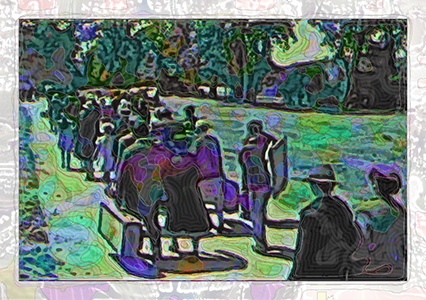
An experiment. A captured still from a movie, the Serbian series about World War II, The Rift of a Nation. Shows civilians evacuating after the Nazis invaded Serbia. Used Pause/Print-Screen/Paste to go from Browser movie window to Photoshop.
Opening tonight was a great success. Sold a couple pieces.
Source:
Link1: www.viki.com/videos/1023425v-rift-of-a-nation-episode-2
May 15, 2015
Miscellanous
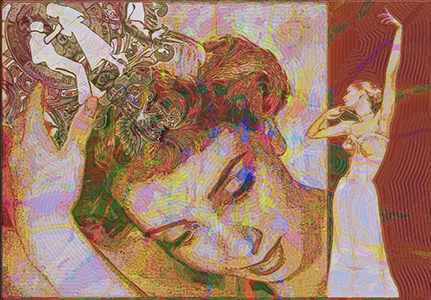
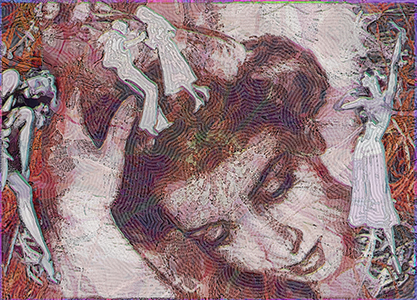
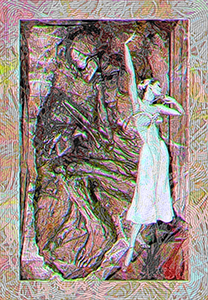
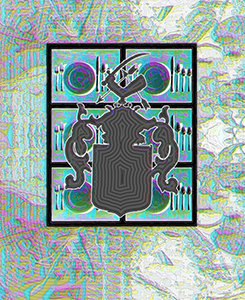
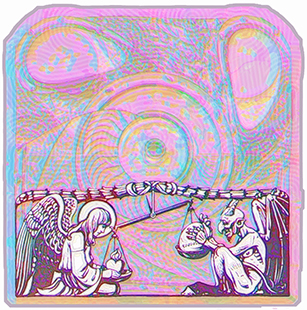
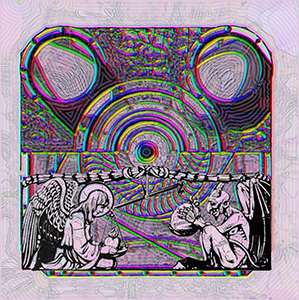
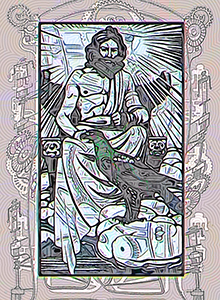
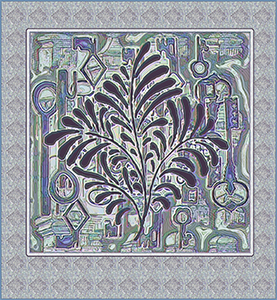
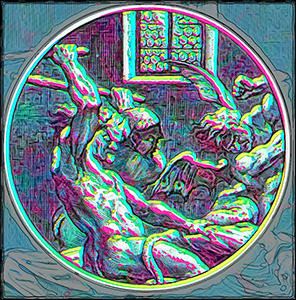
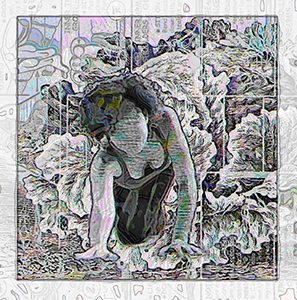
Again, a time of busi-ness. A lot of the images are from a 1950 Life magazine and a 19th century book of Hungarian family coats of arms. Too busy for detail.
Source:
April 30, 2015
Suffering Souls Caught in Machine
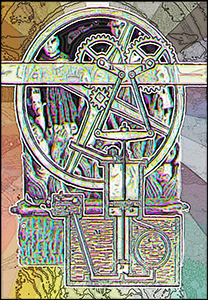
A picture of a steam engine from the 1827 The steam engine, comprising an account of its invention and progressive improvement (Link1). Behind the wheel of the engine is a bas-relief depicting a protector of souls from the 1998 Antropoloxía Mariñeira (Link2). The whole is overlaid on a church carving from the same source, showing Mary Mother of Jesus sheltering poor souls in Purgatory. Finally, the overall image is placed on a color wheel from the 1940 Armstrong Pattern Book (Link3).
Source:
Link1: archive.org/details/bub_gb_MywKAAAAIAAJ
Link2: archive.org/details/bub_gb_60uB5N0YguYC
Link3: archive.org/details/ArmstrongPatternBook
April 27, 2015
Apostles before Archaeological Artifacts
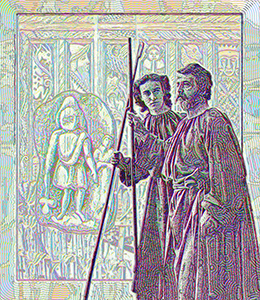
From a 1910 souvenir book of the four-century-old German Passion Play staged by a small German town, Oberammergau: its passion play and players : a 20th century pilgrimage to a modern Jerusalem and a new Gethsemane (Link1), a photograph of the actors who play apostles Peter and John. Their image is placed on a collage composed of (1) an emblem (left center) from a Roman sepulchral monument in England, shown in the 1731 The Gentleman's Magazine (Link2), (2) from the same source, a "rood screen" (which separated the choir from the main church) from a Cornish church (top left background), and (3) from the 1998 Antropoloxía Mariñeira (Link3), some octupi set out in the sun to dry (bottom left background).
Source:
Link1: archive.org/details/bub_gb_MylMAAAAMAAJ
Link2: archive.org/details/bub_gb_Md0hAAAAMAAJ
Link3: archive.org/details/bub_gb_60uB5N0YguYC
April 27, 2015
Mary Magdalene in Ruins
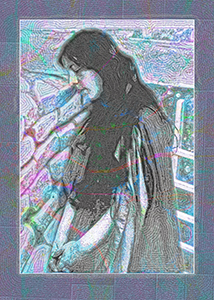
From a 1910 souvenir book of the four-century-old German Passion Play staged by a small German town, Oberammergau: its passion play and players : a 20th century pilgrimage to a modern Jerusalem and a new Gethsemane (Link1), a photograph of Marie Mayr, the actress who plays Mary Magdalene. Her image is placed on a photograph of an old Roman gateway in Cardiff, Wales from the 1846 Archaeologia cambrensis (Link2). Some of the color and pattern in the frame comes from the 1940 Armstrong Pattern Book (Link3). Image was used as a birthday card for neighbor Henry Pashkow.
Source:
Link1: archive.org/details/bub_gb_MylMAAAAMAAJ
Link2: archive.org/details/bub_gb_57MVAAAAYAAJ
Link3: archive.org/details/ArmstrongPatternBook
April 25, 2015
Captive in Old Frame, Lipstick and Linoleum
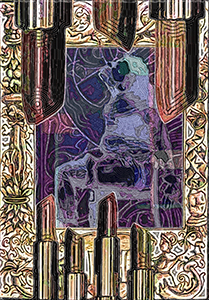
Two images from a 1994 New York Magazine (Link1). One is a painting from an article called "Black Like Them" about then-current Black artists, showing a kind of x-ray picture of a bound woman titled "Injustice Case" by David Hammons. Also shown are lipstick tubes from an Estee Lauder advertisement. The frame is from Wiens Buchdrucker-Geschichte ("Vienna Book History" Link2)-- a title page from a German volume. Also, some color comes from the 1939 Armstrong's Quaker and Standard Rugs and Floor Coverings (Link3).
Source:
Link1: archive.org/details/bub_gb_MeQCAAAAMBAJ
Link2: archive.org/details/bub_gb_iAExAQAAMAAJ
Link3: archive.org/details/ArmstrongsQuakerAndStandardRugsAndFloorCoverings
April 24, 2015
Return to Full Bibliographic Entries
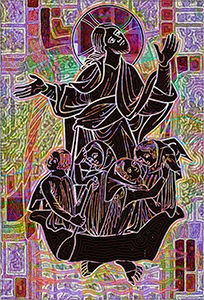
Two images from the 1859 Handbuch der Kunstgeschichte ("Handbbook of the History of Art") (Link1). One is author Franz Kugler's (FK) exquisite line-drawing of "The Transfigured Redeemer" rising, from a Munich church. Below that is Kugler's drawing of a book illustration, showing a man rowing three women in a boat. The combined image is overlaid on a distorted flooring sample from the 1939 Armstrong's Quaker and Standard Rugs and Floor Coverings (Link2). Then colors in the whole are reversed.
You would not be mistaken if you guessed that the lapse of bibliographic entries between April 1 and April 24 represented a troubled period: a co-op election, a collaboration, and a questioning of the value of my work.
Source:
Link1: archive.org/details/bub_gb_Mdk9AAAAcAAJbr>
Link2: archive.org/details/ArmstrongsQuakerAndStandardRugsAndFloorCoverings
April 24, 2015
Some Miscellaneous Images
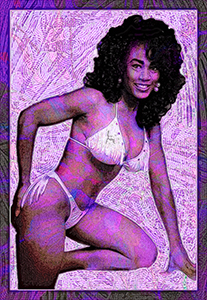
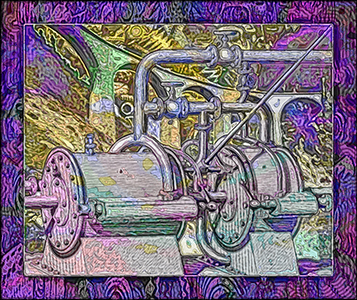
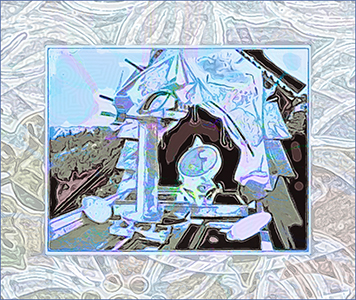
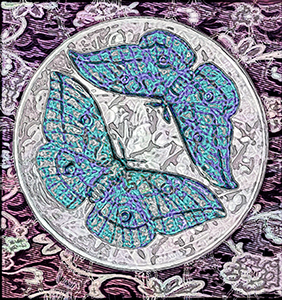
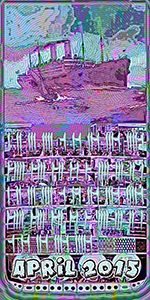
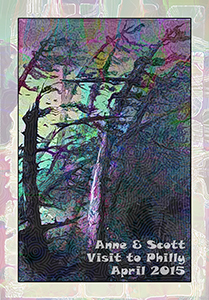
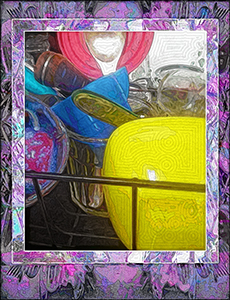
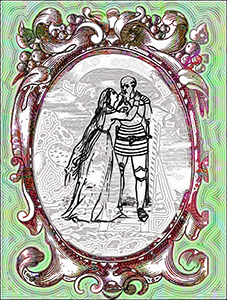
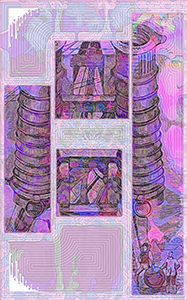
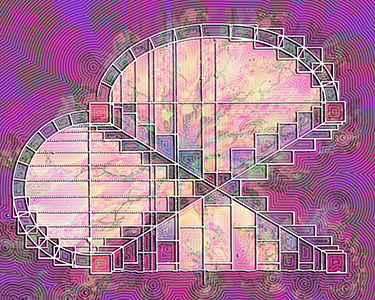
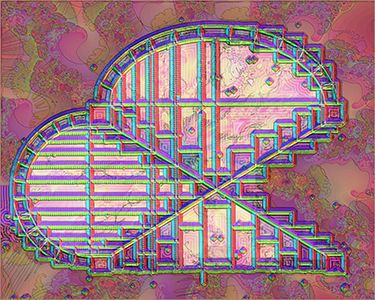
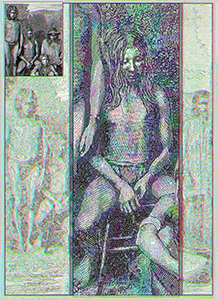
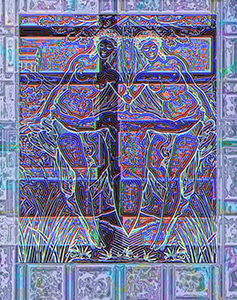
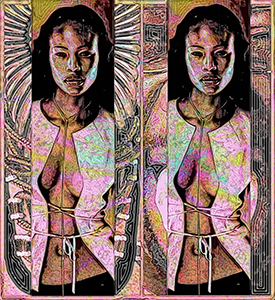
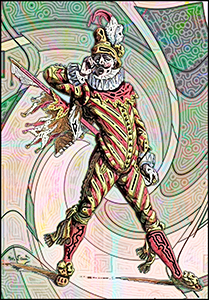
My mind is elsewhere, on this Easter / Passover / Lunar Eclipse weekend.
Source:
Link1: archive.org/details/bub_gb_M7wDAAAAMBAJ
Link2: archive.org/details/bub_gb_LghYAAAAcAAJ
Link3: archive.org/details/bub_gb_YCQ6AQAAMAAJ
Link3: archive.org/details/bub_gb_YCQ6AQAAMAAJ
April 4, 2015
Teensy Critters on Horseman Frame and Wallpaper
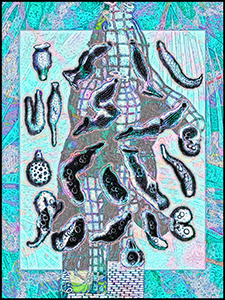
Trouble Sleeping
Troubled Mind
Scattered in front are some microscopic creatures from the 1718 Descriptions et usages de plusieurs nouveaux microscopes (Descriptions and uses of several new microscopes) (Link1). Behind them is a form for an equestrian stature from the 1757 Geschichte und Abbildung der besten Mahler in der Schweitz (History and illustration of the best Mahler in the Schweitz) (Link2) Finally, all are laid upon a wallpaper from the 1954 Sears 1954 wallpaper and wall oilcloths (Link3).
Source:
Link1: archive.org/details/bub_gb_1fYmPo84uk8C
Link2: archive.org/details/PaintCatalogSpring1926
Link3: archive.org/details/Sears1954WallpaperAndWallOilcloths
April 1, 2015
Roman Churchmen's Emblems
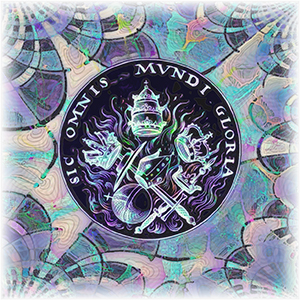
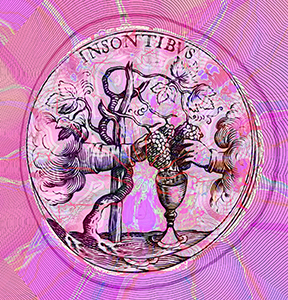
16th Century Churchmen
Chose Cartoon-like Emblems.
Here is Martinus v. Romanus' Emblem
with a motto
Sic Omnia Gloria Mundi
and a Picture of Symbols
of Wealth and Power
Cast into Fire
Translation: "So pass away all the glories of the world." From the first volume of the 1600 Symbola diuina & humana pontificvm, imperatorum, regum, a book of heraldry and emblems (Link1). It is placed over a deformation of color chips from the 1935 Bay state one-coat dultint flat oderless wall enamel (Link2). To its right, another emblem from the same source, with the motto Insontibus (We Innocents).
Source:
Link1: archive.org/details/symboladiuinahum00sade
Link2: archive.org/details/BayStateOne-coatDultintFlatOderlessWallEnamel
March 24, 2015
Locusts on Flowers
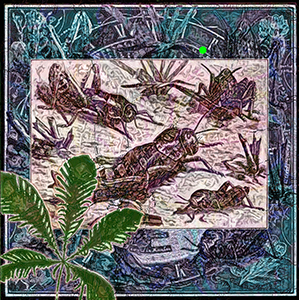
Locusts
on a Kansan Floral Clock
With A Single Tree Leaf Placed
Upon a Carpet Background
From a 1903 Prometheus illustrierte Wochenschrift über die Fortschritte in Gewerbe, Industrie und Wissenschaft (Link1) ("Prometheus illustrated weekly on progress in business, industry and science"), a picture of locusts on a floral clock from Kansas and a chestnut leaf. All on a Trentone rug from the 1952 Floor and Wall Fashions by Sloane (Link2).
Source:
Link1: archive.org/details/bub_gb__y0-AQAAMAAJ
Link2: archive.org/details/FloorAndWallFashionsBySloane
March 23, 2015
Electric Illumination
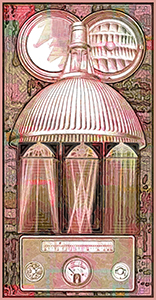
Imaginary Instrument
Composed of Illustrations
from Electric Lighting Manual,
On Carpeting Background
From a 1930 Electric Illumination (Link1) text, a stacking of several illustrations create a machine-like image. Background color comes from the 1952 Floor and Wall Fashions by Sloane (Link2). Attributions are unclear because work was done ten days ago.
Source:
Link1: archive.org/details/ElectricIllumination/v2
Link2: archive.org/details/FloorAndWallFashionsBySloane
March 22, 2015
Back to Work
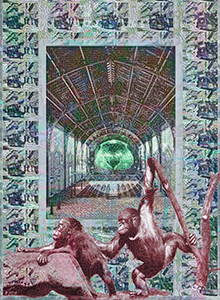
Loading Bay
for Zeppelin Passengers
with Astrological Chart,
Monkeys Playing
All on Filmstrip and Floor Background
A long delay in working -- because I'm running for a seat on the Co-op Board, because I had to work on the Collaboration show, because I had an out-of-town visitor, and because I had a cold. I brought this image to the Plastic Club class with Alice Meyer-Wallace, and she encouraged me to use brighter colors, but I pulled back in the above example.
The zeppelin landing and the monkeys are from the 1896 Prometheus illustrierte Wochenschrift über die Fortschritte in Gewerbe, Industrie und Wissenschaft (Link1). Overlaid on the green cabin of the zippelin to be loaded is an astrological chart from the 1689 Curiosora et selectiora variarum scientiarum miscellanea. In tres partes divisa (Link2). Generally, color comes from the 1952 Floor and Wall Fashions by Sloane (Link3). Attributions are unclear because work was done ten days ago.
Source:
Link1: archive.org/details/bub_gb_si0-AQAAMAAJ
Link2: archive.org/details/bub_gb_1rQFMLtQJq0C
Link3: archive.org/details/FloorAndWallFashionsBySloane
March 21, 2015
Homage to Albrech Durer (or is it Anonymous?)
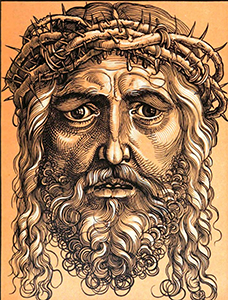
To my mind, Albrecht Durer, the German printmaker (1478-1521) may be the greatest artist who ever lived. Here is a picture of Jesus from the 1897 book of prints Dürer (Link1) -- just masterful. I've never seen it before. I simply reproduce it here, with no Photoshop post-processing.
But things can never be simple. Looking into it, I find there are some sources who say that the image is NOT by Durer but from another artist - Hans Sebald Beham. For instance, the Louvre attribution goes: "Anonymous - After Hans Sebald Beham (1500 – 1550) - After Dürer (1471 – 1528)". Also, most other online versions show it in black and white, not the lovely red, black, and white of this version. I shrug in confusion.
I have been thinking more on Religion these days. Today, religion is too important to be left to the Ultra-Religious. From my memory of reading the Bible, Jesus clearly had a preference for social justice and equality. Now I am reading French "Christian Anarchist" Jacques Ellul; the cover says it contains Ellul's arguments against inequality, but so far it is a difficult-to-read line-by-line exegesis of two books, Amos and the epistles of James, presented with the characteristic off-putting prose density of modern French philosophers.
Source:
Link1: archive.org/details/bub_gb_oQMEAAAAYAAJ
March 10, 2015
Composition 2
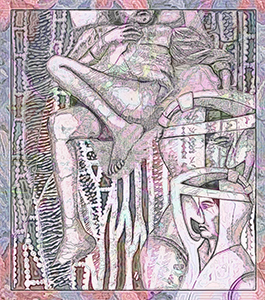
Boy in Hospital Bed
With Twisted Legs,
Man in Gear Protecting Nose.
Placed on a Microscopic View
of Tangled Sections of Wood.
With Color from a Rug Pattern
The image of the boy and the headgear is from the 1899 RealEncyclopadie der Gesammten Heilkunde (Link1) ("Real Encyclopedia of All Medicine"). The background image (of a section of filaments in an ailanthus tree) is from the 1899 Prometheus (Link2), a German science magazine. The background rug design is from the 1952 Floor and Wall Fashions (Link3).
After the first draft of my collaboration with Ron's photographs, I am rethinking my work. The deadline for the Collaboration show is March 27, and I will return to those images, with an eye to getting better skin color and somewhat neater selections.
Source:
Link1: archive.org/details/bub_gb_oP8WcZ6_OSAC
Link2: archive.org/details/bub_gb_si0-AQAAMAAJ
Link3: archive.org/details/FloorAndWallFashionsBySloane
March 10, 2015
Composition 1
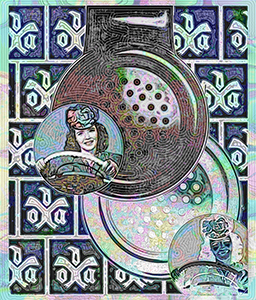
Mouthpiece of Old Phone,
Smiling Behatted Lady Driver;
Both, Doubled and Reversed.
Placed on a Book Cover Pattern
with Color from Wallpaper
Familiar but obsolete black plastic phone is from ad in 1992 InfoWorld (Link1). Either the lady is tiny, perhaps sitting on a phone book, or that steering wheel is huge; it's from an ad in a 1946 issue of LIFE (Link2) magazine. The background pattern is a design used in the cover of a book Il Dio Straniero ("The Foreign God") by Italian religious writer Guiseppe Gangale, shown in the 1935 Bollettino della Società di Studi Valdes (Link3) ("Bulletin of the Waldensian Studies Society"). The Waldensians are a religious movement dating from 1170 or so and still extant today. Wallpaper sample is from the 1942 ColorPerfect Wallpaper book (Link4).
Source:
Link1: archive.org/details/bub_gb_LlEEAAAAMBAJ
Link2: archive.org/details/bub_gb_LkoEAAAAMBAJ
Link3: archive.org/details/bollettinodellas1902soci
Link4: archive.org/details/ColorPerfectWallpaper1942
March 9, 2015
Three Wings
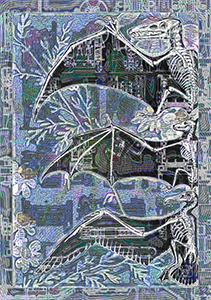
Wing of pterodactyl,
wing of bat,
wing of bird.
Placed on a field
of patent drawings
and wallpaper.
Wings are from the 1892 Darwin and After Darwin. An Exposition of the Darwinian Theory and a Discussion of Post-Darwinian Questions (Link1), patent drawings are from the the 1887 Verkehrszeitung und Industrielle Rundschau ("Traffic and Newspaper Industry Magazine")(Link2). Wallpaper sample was from the 1942 ColorPerfect Wallpaper book (Link3).
Source:
Link1: archive.org/details/bub_gb_LpuaCrHQ8MIC
Link2: archive.org/details/bub_gb_xIstAQAAMAAJ
Link3: archive.org/details/ColorPerfectWallpaper1942
March 8, 2015
St. Rosalia of Palermo
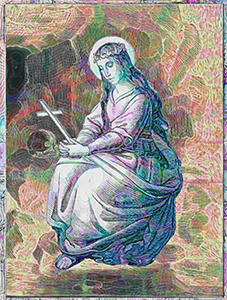
A saint's picture from the 1845 BilderLegende für das Christkatholische Volk (Link1) ("Pictures Legend of the Old Catholic people"). It tells the story of Rosalia, a pious young girl of such beauty that she attracted suitors from all over. When her parents promised her in marriage to an older man, she ran away from home and hid in a cave in the mountains, where she died. Years later, when Palermo, her hometownm, was threatened by plague, they found her bones and the city was spared. More of the story here and here. These stories were the staple of my Roman Catholic youth. Reminds me of stories from the Middle East today.
Her image is placed upon some wallpaper samples from the 1942 ColorPerfect Wallpaper, (Link2)
Source:
Link1: archive.org/details/bub_gb_LrxMAAAAcAAJ
Link2: archive.org/details/ColorPerfectWallpaper1942
March 7, 2015
Scoliosis Boy and Spine
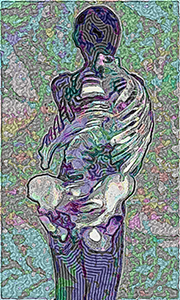
Two pictures from the 1899 Orthopaedic Surgery: A Textbook of the Pathology and Treatment of Deformities (Link1), one showing a photograph of a 13-year-old boy with a spinal deformity and the other showing a skeletal spine with scoliosis. Some additional color is provided by a wallpaper sample from the 1942 ColorPerfect Wallpaper, (Link2)
Source:
Link1: archive.org/details/65130780R.nlm.nih.gov
Link2: archive.org/details/ColorPerfectWallpaper1942
March 5, 2015
Logs Used in Executions

There is a very strange book, allegedly by the 16th century Flemish humanist Justus Lipsisu (the founder of Neostoicism). It is a 1595 volume called De Cruce Libri Tres ad Sacram Profanamque Historiam Utiles (Rough translation: "The book of the history of the three from the cross, its sacred and profane uses.") Anyway, the oddity is that this book is not listed among Lipsius' works, and it is a distastefully sadistic depiction of the various uses of crosses in torture and executions (of slaves and rebels). The image is of a man tied to a stake being burned. The only online references to this volume are in obscure arguments among religious types over "What is the shape of the true cross?" The image was ugly enough that I cropped and inverted most of the gruesomeness out. I also used a sample of a wallpaper from the 1942 Color Perfect Wallpaer to add shape and color.
Source:
Link1: archive.org/details/bub_gb_0_WulOOeAf4C
Link2: archive.org/details/ColorPerfectWallpaper1942
March 4, 2015
Collaborative Work with Photographer
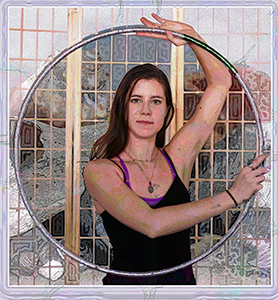
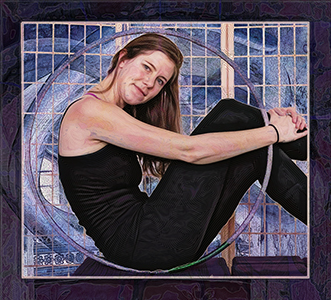
The Plastic Club is hosting a Collaborations show (prospectus here) for members, and I am working with photographer Ron Ploeg, taking his original photographs and applying my "post-processing" techniques.
Here are the first two, based on photographs of a young woman holding a hulu hoop in front of a latticed screen.
March 3, 2015
Sewer Grates, Armenian Sewn Design, Mother Bathing Child
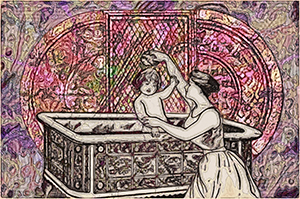
Backmost texture of all is an illustration from the 2001 Treasures from the Ark: 1700 years of Armenian Christian Art. In front of that is a composition of manhole gratings from the 1954 iron works catalog Alhambra Foundry Co., Ltd: Catalog no. 15 (Link2). The foreground (or "hero", as my teacher Alice Meyers-Wallace calls it) is a picture from the 1896 The Household Guide, or, Domestic Cyclopedia: A Practical Family Physician, Home Remedies and Home Treatment on All Diseases, An Instructor on Nursing, Housekeeping, and Home Adornments (Link3), showing a mother bathing a child in an old iron bathtub.
Source:
Link1: archive.org/details/bub_gb_2vxGAgAAQBAJ
Link2: archive.org/details/AlhanbraFoundryCo.LtdCatalogNo.15
Link3: archive.org/details/8004287.nlm.nih.gov
March 2, 2015
World of Commerce and Restaurant Supply
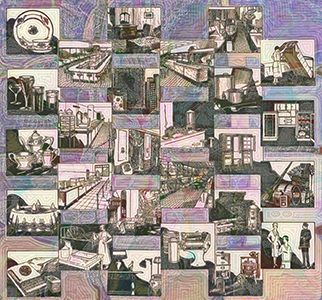
A set of ink-drawings used as headings for a restaurant and institutional supply catalog, the 1926 General Catalog of Equipment, Furnishings, and Supplies for Hotels, Restaurants, Clubs, and Institutions. They are superimposed over a deformation of a page of color chips from the 1950 Now You Can Spread Color Quickly, Easily, at Low Cost - Texolite.
Source:
Link2: archive.org/details/GeneralCatalogOfEquipmentFurnishingsAndSuppliesForHotels
Link1: archive.org/details/NowYouCanSpreadColorQuicklyEasilyAtLowCost-Texolite
March 1, 2015
Cross Memorial on Mycological Moon
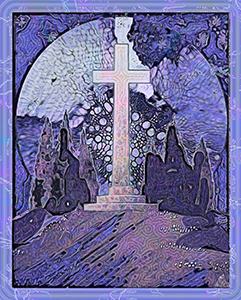
From the 1928 catalog of funeral monuments Memorials: Today for Tomorrow (Link1), a marble Latin Cross monument set against a grove of trees. The monument is set against a diagram of a mushroom from the the 1909 Mycologia (Link2).
Source:
Link1: archive.org/details/MemorialsTodayForTomorrow
Link2: archive.org/details/mycologia41912newy
February 28, 2015
Mushrooms on Paint-Chip Swirl
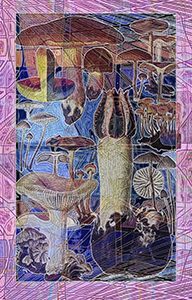
In the background, a deformation of a page of color chips from the 1950 Now You Can Spread Color Quickly, Easily, at Low Cost - Texolite. In the foreground, a page of mushrooms from the 1909 Mycologia.
Source:
Link1: archive.org/details/NowYouCanSpreadColorQuicklyEasilyAtLowCost-Texolite
Link2: archive.org/details/mycologia41912newy
February 27, 2015
Rosetti Sun Dial
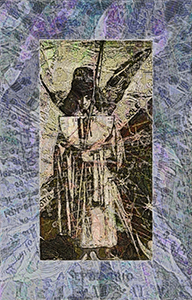
In the background again, barely visible, is a sample of wallpaper from the Sears' 1930 Style Book Certified Fadeproof Wall Paper. (Link1)
The foreground figure is from an engraving from the 1902 Sun Dials and Roses of Yesterday: Garden Delights which are here displayed in every Truth and are moreover regarded as Emblems. It is a version of Dante Gabriel Rossetti's painting Dante's Amor, a man in an old-time costume with a sundial on his chest. See original here.
Source:
Link1: archive.org/details/1930StyleBookCertifiedFadeproofWallPaper
Link2: archive.org/details/00938250.34655.emory.edu
February 26, 2015
Lady Fortune
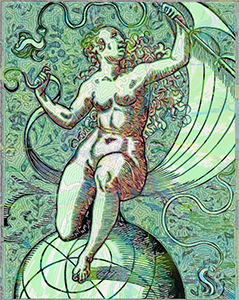
In the background is a sample of wallpaper from the Sears' 1930 Style Book Certified Fadeproof Wall Paper. (Link1) The figure is from an engraving from the 1893 Wappen & Stammbuch (Coat of Arms and Studbook) (Link2). The particular coat of arms is called "La Fortuna".
Source:
Link1: archive.org/details/1930StyleBookCertifiedFadeproofWallPaper
Link2: archive.org/details/bub_gb_KDMEAAAAYAAJ
February 26, 2015
Oliver Sacks on Mortality

In the background is a sample of wallpaper ("Heraldic") from the Sears' 1930 Style Book Certified Fadeproof Wall Paper. (Link1) The quote is from a moving op-ed article by doctor/scientist Oliver Sacks, after he was informed that he has only a short time to live. The font is Cafeteria.
Source:
Link1: archive.org/details/1930StyleBookCertifiedFadeproofWallPaper
February 25, 2015
Jaguar
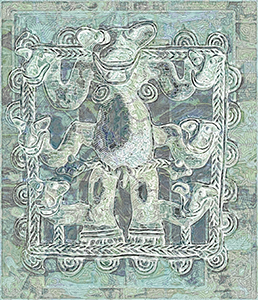
Foreground is an illustration from the 1911 A study of Chiriquian Antiquities (Link1), showing a metalwork effigy of a being part human and part jaguar, from a "province on the coast of Panama. The human/jaguar effigy is set against two different background images, barely visible: one is a depiction of woodworking in German churches from the 1898 Die kunst-und geschichts-denkmäler des grossherzogthums Mecklenburg-Schwerin; im auftrage des grossherzoglichen ministeriums des innern (The art and history monuments of the Grand Duchy of Mecklenburg-Schwerin ; on behalf of the Grand Ducal Ministry of the inner"). Color comes from a sample sheet of wallpaper from the Sears' 1930 Style Book Certified Fadeproof Wall Paper.
Source:
Link1: archive.org/details/studyofchiriquia00macc
Link2: archive.org/details/bub_gb_IPFYAAAAYAAJ
Link3: archive.org/details/1930StyleBookCertifiedFadeproofWallPaper
February 23, 2015
Baroque Palace Decorations
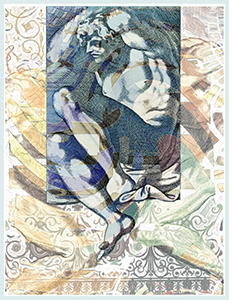
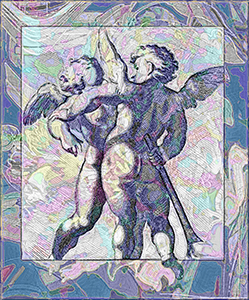
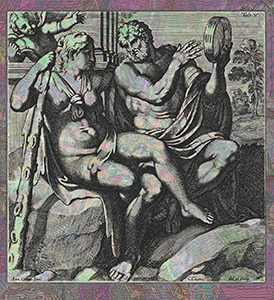
Left: A composition of images from the 1753 Aedium Farnesiarum tabulae ab Annibale Caraccio depictae, a Carolo Caesio aeri insculptae, atque a Lucio Philarchaeo explicationibus illustratae (Link1) ("Farnese Palace boards from Annibale Caraccio painted by Charles Caesio sculpted in bronze , and stipulating Philarchaeo illustrated explanations") showing the tableaux on the walls of the Roman Palazzo Farnese, painted by Annibale Carracci.
Color comes from a deformation of a page of color samples from the 1922 Painting and Decorating Working Methods (Link2). The same source provides a barely visisble example of wallpaper with the "Crown Effect" -- it starts out at the top of the wall in full detail and then tapers off the pattern as it approaches the bottom. Color in the left two images come from deformations of wallpapers in the 1954 Sears 1954 Wallpaper and Wall Oilcloths (Link3).
Source:
Link2: archive.org/details/gri_33125009313681
Link2: archive.org/details/PaintingAndDecoratingWorkingMethods
Link3: archive.org/details/Sears1954WallpaperAndWallOilcloths
February 20, 2015
The Church of Endangered Amphibians
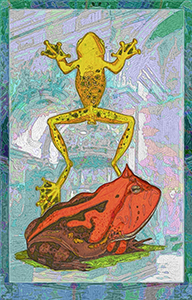
Two more images from the 1837 Abbildungen Neuer Oder Unvollständig Bekannter Amphibien : Nach der Natur oder dem Leben Entworfen (Pictures of new or incompletely known amphibians: designed according to the nature or life) (Link1), overlaid on a church scene from the 1899 Photographische Korrespondenz; Zeitschrift für Wissenschaftliche Und Angewandte Photographie und die Gesamte Reproduktionstechnik (Photographic Correspondence: Journal of Scientific and Applied Photography and the Entire Reproductive Technology) (Link2).
Source:
Link2: archive.org/details/Abbildungenneue00Schl
Link1: archive.org/details/bub_gb_jOkWAAAAYAAJ
February 19, 2015
Moroccan Woman on Tortoise Shell
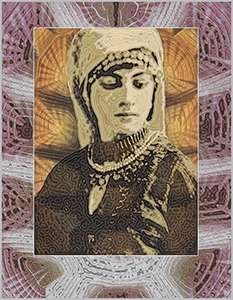
A photograph of a woman from the 1899 Photographische Korrespondenz; Zeitschrift für Wissenschaftliche Und Angewandte Photographie und die Gesamte Reproduktionstechnik (Photographic Correspondence: Journal of Scientific and Applied Photography and the Entire Reproductive Technology) (Link1), framed and set against a section of a pattern from a turtle shell, shown in the 1837 Abbildungen Neuer Oder Unvollständig Bekannter Amphibien : Nach der Natur oder dem Leben Entworfen (Pictures of new or incompletely known amphibians: designed according to the nature or life) (Link2).
Source:
Link1: archive.org/details/bub_gb_jOkWAAAAYAAJ
Link2: archive.org/details/Abbildungenneue00Schl
February 19, 2015
Church Troll
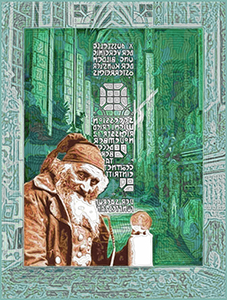
Collage of pictures from two editions of Zeitschrift für Reproduktionstechnik (1899 and 1903) (Magazine of Printing Technology). In the foreground in orange is some sort of "troll" -- an old bearded man, much like myself -- with his tobacco pipe and a tankard of ale. In his background is a picture of a German church with sunlight streaming through a window, overlaid by a typographic poster from the 1897 Vienna Secession.
Occasional color comes from the 1941 paint catalog, M-P-M Color Chart of Modern Finishes (Link3).
I am also considering submitting this for the next Plastic Club Small Works show.
Source:
Link1: archive.org/details/bub_gb_z6QaAAAAYAAJ
Link2: archive.org/details/bub_gb_Q58aAAAAYAAJ
Link3: archive.org/details/M-p-mColorChartOfModernFinishes
February 18, 2015
Lady in Red
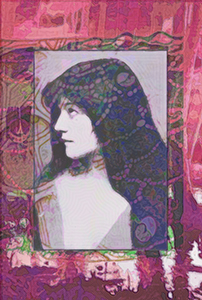
My work lately has been dominated by images of attractive young women in their childbearing years -- a kind of old man's discreet porn. Except most of the beauties depicted have either been dead for a century or are creatures of artist's ink. Not sure what psychosexual cellar it all comes from, but I suspect it's the same impulse that sends newspeople into paroxysms of worry about missing (white) girls and conservatives into shocked outrage at Super Bowl nipple slips and twerking. Anyway, here's another one...
From the 1897 Photographische Rundschau (Photographic Magazine) (Link1), in the center, a studio porrait of a woman with long black hair from the Paris studio of M. Bremard. From the same volume of photography, in the far background and frame, a picture of a flooded forest titled "After the Storm". Two textures (in the woman's hair and to the left of her face) come from the 1908 Histologisches Praktikum der Ticre für Studenten und Forscher (Link2), a textbook of tissue samples for students and researchers. Occasional color comes from the 1941 paint catalog, M-P-M Color Chart of Modern Finishes (Link3).
I currently intend to submit this for the next Plastic Club Small Works show.
Source:
Link1: archive.org/details/bub_gb_lBA_AAAAYAAJ
Link2: archive.org/details/bub_gb_8mkaAAAAIAAJ
Link3: archive.org/details/M-p-mColorChartOfModernFinishes
February 17, 2015
Valentine
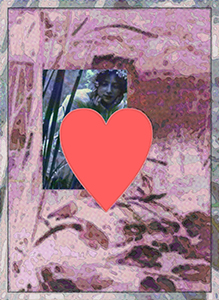
After a long break -- some if it caused by the intestinal flu, some by travel -- a composition of a picture from the 1903 Photographische Mitteilungen (Photographic Selections)
along with a symbol from the Bookshelf Symbol 7 font.
Color in this picture
comes from the 1935 paint catalog
Bay State One-Coat Dultint Flat Odorless Wall Enamel (Link4).
Source:
Link1: archive.org/details/bub_gb_zAI_AAAAYAAJ
Link2: archive.org/details/BayStateOne-coatDultintFlatOderlessWallEnamel
February 15, 2015
Woodland Girl over Ceramic Plate
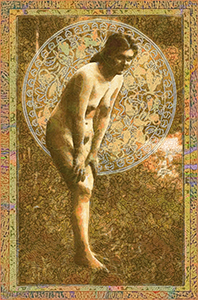
A young woman pauses in her woodland frolic, from the 1890 German book Die Nackheit ("Nudity") (Link1). She is haloed by a ceramic plate
design from the 1896 Ueber fremde Einflüsse in der chinesischen Kunst ("Foreign Influences on Ceramic Art") (Link2). Colors are from the 1930 White Lead and Oil Plastic Finishes (Link3).
Source:
Link1: archive.org/details/bub_gb__akRAAAAYAAJ
Link2: archive.org/details/bub_gb_VeHunqf-hOgC
Link3: archive.org/details/WhiteLeadAndOilPlasticFinishes
February 5, 2015
Book Spines, Girl and Peasant Woman
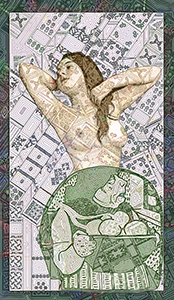
The background of this image is an arrangement
of book spine designs
from a 1900 Danish periodical on book design,
Bogvennen. (Link1)
Book spine designs are the backs of books,
visible when the book is shelved;
at their finest,
they are bright gold leaf on dark leather.
The bare-breasted woman
is from the 1910 German book
Sexuelle Verirrungen des Menschen und der Natur (Link2)
("Sexual Aberrations of Man and Nature," subtitled "Large illustrated anthology about the morbid appearances of the sexual impulse in man, the real and the sham, hermaphroditism and other mysterious phenomena of nature in the sexual areas").
The picture of the girl is titled
"Young Sicilian Woman with Large Nipples,"
to my eye,
more of a dreamy pin-up than an illustration of any morbid condition.
At bottom, in green,
is an image from
from Ludwig Thoma's 1897 Agricola (Link3),
a book of sketches of rural life in Bavaria.
It shows a peasant woman carrying a bowl
of steaming food.
Color in this picture
comes from the 1935 paint catalog
Bay State One-Coat Dultint Flat Odorless Wall Enamel (Link4).
Source:
Link1: archive.org/details/bub_gb_2pQ9AQAAMAAJ
Link2: archive.org/details/bub_gb_6C8zAQAAMAAJ
Link3: archive.org/details/bub_gb_N2nZAAAAMAAJ
Link4: archive.org/details/BayStateOne-coatDultintFlatOderlessWallEnamel
February 3, 2015
Papal Election Cheating: Fake Medieval Document
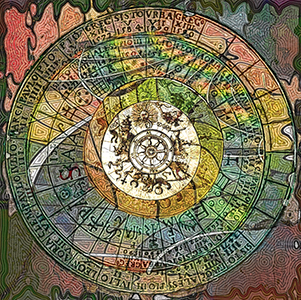
I have recently decided to spend more time on the writing of these notes, so I am changing from an image-per-day schedule to an image-every-other-day schedule, so I can spend more time on the accompanying text.
Had a nice chat at an art opening with my art teacher's brother,
Dick, who recently collaborated on this song.
Thinking about World War I
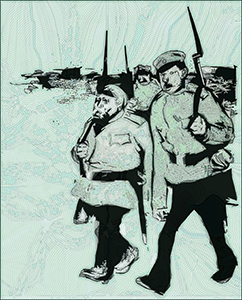
Image shows soldiers of the pre-World War I era from the 1897 Agricola : Bauerngeschichten. Finished second straight book on WWI, A Mad Catastrophe: The Outbreak of World War I and the Collapse of the Habsburg Empire, by Geoffrey Wawro. Two thoughts: (1) Austria and Hungary were joined together by a mysterious process after some war -- and they never really cooperated. The reluctant Hungarians resisted every attempt to modernize the army or improve the infrastructure. The result was a startling, sudden collapse of Austro-Hungarian forces when WWI began. Reminds me perhaps of the relation between the North and the South in America. The Confederacy lives in a Republican faction in Congress that says NO to everything the President proposes. (2) There are times when disobedience to authority is absolutely necessary for survival. Desertion (or emigration to avoid service) in those woefully underequipped Austro-Hungarian armies fighting Serbia and Russia was the best strategy. Massive casualties -- especially among the front-line officers -- no heroes. The best strategy sometimes is to disobey the authorities.
Source:
Link1: archive.org/details/bub_gb_N2nZAAAAMAAJ
January 31, 2015
Dissection and Medical Illustrations
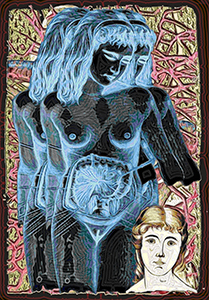
A collage composed of four images from an 1881 Handbuch der Anatomie des Menschen für Studierende und Aerzte ("Handbook of Human Anatomy for Students and Physicians"). Negative in the center is a young girl with stomach flap removed to show internal organs. Bottom right is an image of a young girl used to diagram parts of the neck. And in the background, are two tissue samples: I can't read German (especially Fraktur types) but I think one is a sample of muscle tissue and one looks like ganglion in the brain. Color in some cases is copied from samples in the paintcatalog Cottage Colors.
Source:
Link1: archive.org/details/bub_gb_njcAAAAAQAAJ
Link2: archive.org/details/CottageColors
January 29, 2015
Four Fairy Tale Heroines
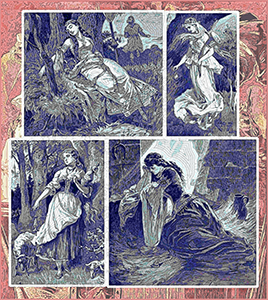
A collage composed of four images of good-lookin' characters from the 1887 Unsre Vorzeit, a collection of German folk tales. Color is supplied from sampling the color samples of the 1906 Seraco Paints catalog.
Source:
Link1: archive.org/details/bub_gb_D8AJ5z7FTkgC
Link2: archive.org/details/SeracoPaints1906
January 28, 2015
River Maiden from the Rheingold
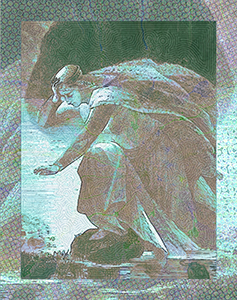
An illustration from the 1877 Elfenreigen Deutsche und Nordische Märchen aus dem Reiche der Riesen und Zwerge, der Elfen, Niren und Kobolde (My translation: The Elfen Kingdom: German and Nordic Fairy Tales from the Realm of Giants, Dwarves, Elves and Goblins""), from the chapter on the Rheingold legend, a lady reaches into the waters for the hidden treasure there. Color supplied by a paint catalog, the 1927 Masury Liquid House Paint (ready to use) Also Railroad Paints
Source:
Link1: archive.org/details/bub_gb_D8AJ5z7FTkgC
Link2: archive.org/details/MasuryLiquidHousePaint
January 28, 2015
Poetic German Nightmare
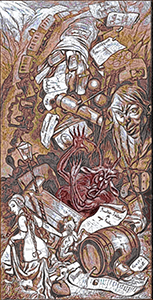
An illustration from the 1890 OberländerAlbum, a collection of poetry. I have a hard time reading German Fraktur print, but the title of the poem this image illustrates is something like "financial speculator from hell". Note the devilish figure in the center. Oberland is a region of Europe. I also added two elements from other illustrations from the same book: (1) the fiendish face in the middle right and (2) the comely lass in the lower left. Color comes from a 1914 catalog of wood stains, Masury's Nomar Wood Stain.
Source:
Link1: archive.org/details/bub_gb_elFRAAAAcAAJ
Link2: archive.org/details/MasurysNomarWoodStain
January 26, 2015
Early Aviation Surfaces and Hail to the Queen
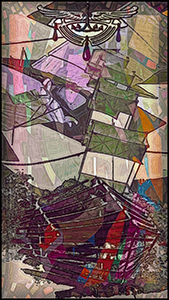
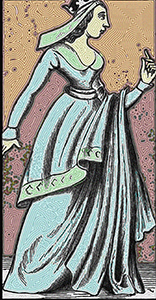
From an 1898 German aviation magazine, Illustrirte Aëronautische Mittheilungen, a selection of the various wood and canvas contraptions and gasbags that marked that tentative moment in aviation history. At top is a medallion of a flying group. At bottom, a view of a flying machine with nearly 50 wings. Color is from a 1930 paint catalog, Color Magic with Nu-Enamel.
Also, a very old playing card queen from the 1854 Les Cartes a Jouer et la Cartomancie (Link3) with color from the 1930 A pail, a Brush, Hot Water and Muralite Makes a Perfect Wall Finish (Link4).
Source:
Link1: archive.org/details/bub_gb_9Ss5AQAAMAAJ
Link2: archive.org/details/ColorMagicWithNu-emamel
Link3: archive.org/details/bub_gb_V7GrblnrhU8C
Link4: archive.org/details/APailABrushHotWaterAndMuraliteMakesAPerfectWallFinish
January 24, 2015
Lunar Peasant Girl Dips Toe in Water
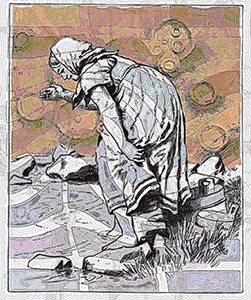
From the 1881 Auswahl norwegischer Volksmärchen und Waldgeister-Sagen (Link1; Google Translate: "Selection of Norwegian folk tales and Forest Spirits Sayings"), a picture of a peasant girl in the woods, stepping into a stream. Behind her, a drawing of lunar volcanos from the 1862 Volcanos the Character of Their Phenomena, Their Share in the Structure and Composition of the Surface of the Globe, and Their Relation to Its Internal Forces (Link2), superimposed on a pattern showing "Plastic Paint" (Lead Paint mixed with Oil Paint) from an undated catalog Painting with White Lead (Link3). The background color stripes in the foreground also come from the same paint catalog.
Source:
Link1: archive.org/details/bub_gb_TWQUAAAAYAAJ
Link2: archive.org/details/bub_gb_sxB6Hph1qGIC
Link3: archive.org/details/PaintingWithWhiteLead
January 23, 2015
Faceless Transhuman
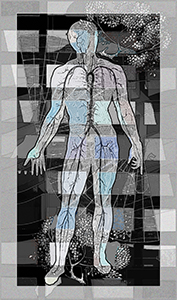
From the 1873 Traité d'Histoire Naturelle Appliquée a l'Agriculture, a l'Industrie, au Commerce et a tous les Arts Technologiques (Link1). a picture in the center of the cirulatory system of man and above and below that a picture of a human saliva gland. Behind the figure, a couple illustrations from the 1786 Nouvelles Récréations Physiques et Mathématiques (Link2). The background pattern is a composition of color samples from the undated Paints Varnishes: Price Wrecker no. 121 (Link3).
Source:
Link1: archive.org/details/bub_gb_T2y3eBAkaooC
Link2: archive.org/details/bub_gb_T2tn6cMehI0C
Link3: archive.org/details/PaintsVarnishesPriceWreckerNo.121
January 22, 2015
Morbid Collage
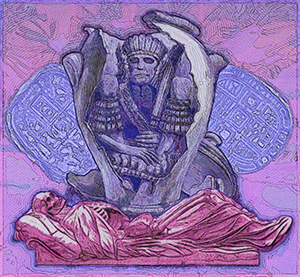
Three elements to this collage. At the center, a broken funerary urn from Peru, with mummified remains visible, as shown in an 1884 Les Contrées Mystérieuses et Les Peuples Inconnus Link1; Google Translate; "Mysterious Lands and Unknown Peoples"). That same book is the source for the two trays branching out right and left from the urn; they are embossed leather tablets from Timbuktu (Africa). At bottom is a reclining skeleton in stone from .the 1894 Mittheilungen der Kaiserl. Königl. Centralcommission zur Erforschung und Erhaltung der Baudenkmale.
Macabre tone may be explained by recent reading (Hell Before Breakfast: America's First War Correspondents; Making History and Headlines, from the Battlefields of the Civil War to the Far Reaches of the Ottoman Empire, 2014, by Robert H. Patton) about European wars in the late 19th and early 20th century -- a bloody time of small tribal wars, mainly in the Balkan states. Especially memorable was the 1876 massacre of Bulgarian villagers who rebelled against the Ottoman Empire. The incident is depicted in atrocity paintings by Antoni Piotrowski and Konstantin Malakovsky.
Much like the Armenians a bit later, the Bulgarians -- men, women, and whildren -- were slaughtered by Ottoman mercenaries ("irregulars") but still, according to this source, Bulgaria would soon be independent and the Ottoman Empire would soon fall in the European great-power machinations after World War I.
Source:
Link1: archive.org/details/bub_gb_UyVAAAAAYAAJ
Link1: archive.org/details/lescontresmystri00tiss
January 21, 2015
Institutional Marks Collage
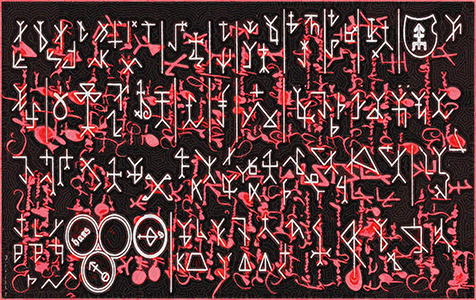
From the 1894 Mittheilungen der Kaiserl. Königl. Centralcommission zur Erforschung und Erhaltung der Baudenkmale, a collage composed of some kind of identifying marks. Perhaps they were craftsman's marks, perhaps church marks, perhaps cities -- who knows? I don't read German. The top layer in white are the marks themselves. The red marks in the background are from some kind of document, apparently signed with a combination of institutional marks and script..
Source:
Link1: archive.org/details/bub_gb_UyVAAAAAYAAJ
January 20, 2015
Medieval Couple in Stone
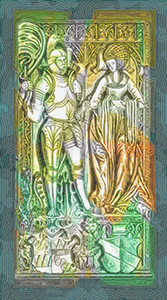
An illustration of a carving showing a knight in armor and a lady from the 1894 Mittheilungen der Kaiserl. Königl. Centralcommission zur Erforschung und Erhaltung der Baudenkmale (Google Translate: "Communications of the Imperial . königl . central commission for exploration and conservation of monuments"). The image is laid on a composition of pastel wall colors from the 1930 Phelan's Interior Gloss: An Artistic and Economical Finish for Walls and Woodwork.
Source:
Link1: archive.org/details/bub_gb_UyVAAAAAYAAJ
Link2: archive.org/details/PhelansIneriorGlossAnArtisticandEconomicalFinishForWallsAndWoodwork
January 20, 2015
Martin Luther King Day Sign

Designed for a friend who is participating in a march. He cautions me that the quote "as is" is not accurate, the statistics apply to male teenagers.
Plastic Club Critter Show
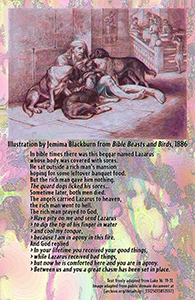
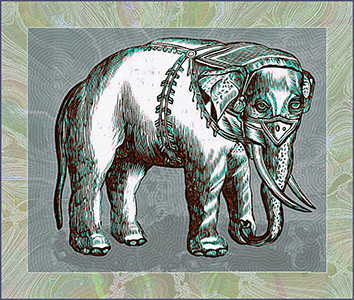
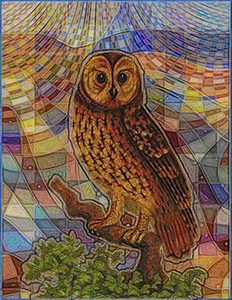
Deciding on my entry for the next Plastic Club exhibition with the subject of Critters and Beasts.
To the left is a July, 2014 Philly-Bob's Free for Fall image based on a biblical verse; I don't often get religious but the recent Charlie Hebdo shooting in Paris makes me think that if we expect moderate Muslims to re-evalaute Islam in a modern light, we moderate Christians (in this case, an American ex-Catholic) should re=evaluate Christianity in a modern light; we shouldn't just abandon it to the zealots like the American Christian Right. The image source is one of Jemima Blackburn's magnificent illustrations for the 1886 Bible Beasts and Birds: A New Edition of Illustrations of Scripture by an Animal Painter.
The other image is a picture of an Indian White Elephant from the 1849 A Pictorial Geography of the World. "The white elephant, of which there is now but one, is estimated above all price. He is treated like a prince of the blood, and has a suite composed of some of the most prominent officers of the court. Indeed, the vulgar actually pay him divine honors, though this ridiculed by the intelligent."
The third image is from the 1811 British Ornithology : Being the History with a Coloured Representation of Every Known Species of British Birds (Link3), depicting an owl, It is superimposed on a design created from a color sample chart in the 1923 Powdrpaint : A Remarkable Discovery, Reduces Cost of Painting 75% (Link4).
Not sure which picture I'll enter in the show. Printing and framing is always an issue.
Source:
Link1: archive.org/details/gri_33125013853557
Link2: archive.org/details/pictorialgeograp21849good
Link3: archive.org/details/Britishornithol2Grav
Link4: archive.org/details/PowdrpaintARemarkableDiscoveryReducesCostOfPainting75
January 17=18, 2015
Protective Coloration, Wheelbarrow, Chrysanthemum: Cleaning up my Bookmark List 10

From an advertisement for a wheelbsrrow in an 1860 edition of The Gardeners' Magazine, superimposed on a photograph of a Japanese chrysanthemum. One slight deviation from symmetry: the image is flipped horizontally, which to me, gives it a slightly disoriented look. Color comes from an illustration from the 1909 Concealing-Coloration in the Animal Kingdom.
Source:
Link1: archive.org/details/mobot31753002331236
Link1: archive.org/details/Concealingcolor00Thay
January 16, 2015
Protective Coloration & Radiation: Cleaning up my Bookmark List 9
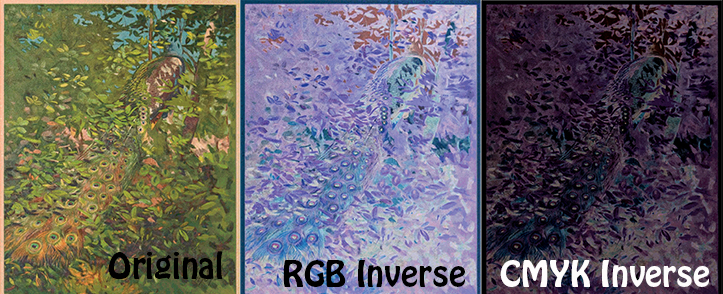
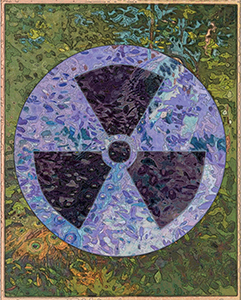
First, another experiment in the differing effects of color inversion on RGB layers and CMYK layers. It is applied to an illustration from the
1909 Concealing-coloration in the animal kingdom; an exposition of the laws of disguise through color and pattern. The illustration shows a peacock in its natural habitat. The peacock goes diagonally from bottom left to top right. You can see the characteristic "eyes" of the peacock's tail feather in the lower left corner.
Below that is an application of the two textures to the radiation symbol.
Source:
Link1: archive.org/details/Concealingcolor00Thay
January 12, 2015
Bugs on a Beach: Cleaning up my Bookmark List 8
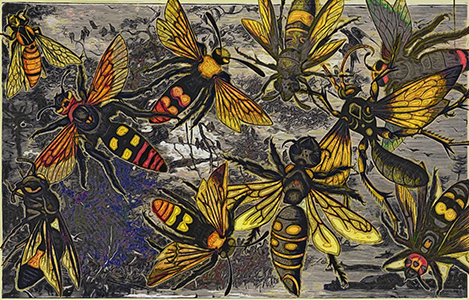
Still cleaning up my bookmark list, removing another two here. In the foreground is an arrangement of bugs from the 1791 Naturgeschichte, Klassification und Nomenclatur der Insekten vom Bienen, Wespen und Ameisengeschlecht : als der fünften Klasse fünfte Ordnung des Linneischen Natursystems von den Insekten, Hymenoptera : mit häutigen Flügeln (Google Translate: "Natural history, classification and nomenclature of insects from bees , wasps and ants Gender: as the fifth grade fifth order of the Linnaean system of nature from insects , Hymenoptera : with membranous wings"). The bugs are placed around a beach scene (labelled teh Salvador River) from the 1880 The history of the sea : a graphic description of maritime adventures, achievements, explorations, discoveries and inventions ... covering the many centuries of development in science and civilization from the ark to the present time.
Source:
Link1: archive.org/details/naturgeschichtekchri_0
Link2: archive.org/details/historyofseagrap00good
January 11, 2015
Sponge and Zeppelin in Radiation Symbol: Cleaning up my Bookmark List 7
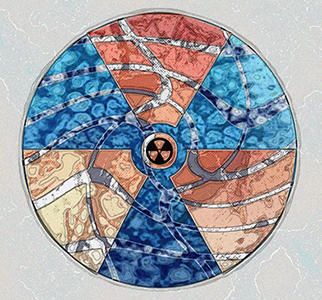
Still cleaning up my bookmark list, removing two here. Inside a radiation symbol from the unattributed Science dingbat font, I combine two entirely different textures. The blue segments are from an illustration of a sponge (magnification 300x) from the 1910 book The Sponges. The orange segments are from a photograph of a German zeppelin shown down over England, from the 1917 book The British Army at War. An interesting account of the downing of a German airship describes the dilemma of the German crew: "Burn or Jump." The background color is a deformation of one of the pages of color samples from the 1948 Plochere Color System.
Source:
Link1: archive.org/details/sponges11910lend
Link2: archive.org/details/britisharmyatwar00foxf
Link2: archive.org/details/PlochreColorSystem
January 10, 2015
Girl on Girl with Skell & Skull: Cleaning up my Bookmark List 7
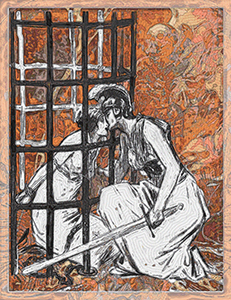
Still cleaning up my bookmark list, removing three at once. Here's a collage composed of three elements: (1) another image from the English outrage over the German invasion of Belgium, with Belgium shown as a bound woman in a cage and the rescuing Allies as a helmeted and sword-bearing woman, from a 1917 book called Through the Iron Bars (Link1); (2) a cartoon titled "Pro Patria" showing a skeleton beating the drum of war (dimly visible in the swirl of color in the top right quarter), from the 1914 The Changing Attitude toward War, as Reflected in the American Press (Link2); and (3) colors for this image (the first two images are black and white) come from an illustration of the neck and head from the undated Netter's Anatomy Flash Cards (Link3).
Source:
Link1: archive.org/details/throughironbars00camm
Link2: archive.org/details/changingattitude00amer
Link3: archive.org/details/NettersAnatomyFlashCards3rdEd.
January 8, 2015
Wonder Woman Headband at Radiation Oncology Clinic


Janice begins a weeklong regime of twice-a-day radiation treatments today. I made her a headband based on the stylized clip-art radiation symbol on the left. It was printed on paper, then laminated, cut from the laminated sheet, and finally tied with matching ribbon. Here she is outside the Radiation Oncology clinic at the hospital showing off her new accessory. Doctors and nurses were amused.
January 8, 2015
Suffering Belgium African Birds: Cleaning up my Bookmark List 6
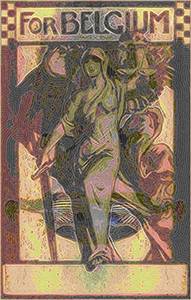
Still cleaning up my bookmark list, two down this time. Foreground, an announcement for a 1914 anti-World War I book of poems, from a book of atrocities from the German invasion of Belgium, A Plain Tale from Malines (Link1). In the background some exotic birds from an 1871 travel book, Baron Carl Claus von der Deckenʼs Reisen in OstAfrika in den Jahren 1859 bis 1865 herausgegeben im Auftrage der Mutter des Reisenden, Fürstin Adelheid von Pless Neue Reisen im Inneren und an der Küste, die ostafrikanische Inselwelt Madagaskar, Seschellen, Réunion, Nossibé und Komoren, Reisen in den Ländern der Galla und So (Google Translate: "Baron Carl Claus published by the Decken's traveling in East Africa between 1859 and 1865 commissioned by the mother of the traveler, Princess Adelheid von Pless New Tourism in the interior and on the coast, the East African islands of Madagascar, Seychelles , Reunion, Nossibé and Comoros, Travel in the countries of the Galla and so on").
Source:
Link1: archive.org/details/plaintalefrommal00clei
Link2: archive.org/details/bub_gb_jd4tffB4lWcC
January 7, 2015
Ice Beard Bird: Cleaning up my Bookmark List 5
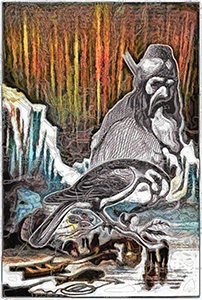
Still cleaning up my bookmark list, removing three at once. Here's a collage composed of three elements: (1) an image of a bearded fellow that goes with a poem titled
L'Emotion de Barberousse (Link1) from the 1844 Les Beauxarts illustration des arts et de la littérature 2; (2) an image of a bird on a branch from the 1601 Il Canto de Gl'Augelli, an opera by Antonio Valli da Todi (Link2); and (3) an image of an eskimo village from an 1865 travel book Fast in the Ice, or, Adventures in the Polar Regions.
Source:
Link1: archive.org/details/bub_gb_JF855R26AbgC
Link2: archive.org/details/bub_gb_m6Q2Bbo41LgC
Link3: archive.org/details/bub_gb_lzUoN5MKfy0C
January 6, 2015
World War I: Cleaning up my Bookmark List 4
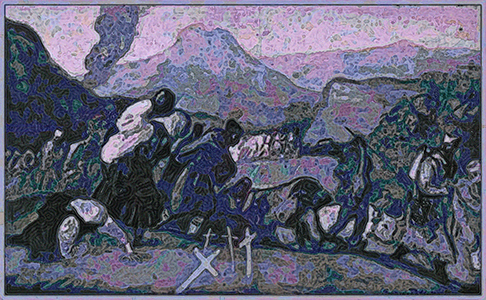
Still cleaning up my bookmark list. Here's an illustration from the 1919 The war in Eastern Europe, written by left-wing journalist John Reed. The illustrations are by Boardman Robinson; this one shows a line of refugees and soldiers marching through the mountains of Serbia. Misery was everywhere, between constant warfare in the Balkan area and the various epidemics among citizens and soldiers alike. I downloaded the EPUB version of this book and will sample it.
Later: Finished Reed's book. Most memorable quote:
"The Macedonian question has been the cause of every great European war for the last fifty years, and until that is settled there will be no more peace either in the Balkans or out of them. Macedonia is the most frightful mixup of races ever imagined. Turks, Albanians, Serbs, Rumanians, Greeks, and Bulgarians live there side by side without mingling and have so lived since the days of St. Paul."Not too pleased with this one either, and I depart from my resolution to be assymetric.
Early Robin Hood: Cleaning up my Bookmark List 3
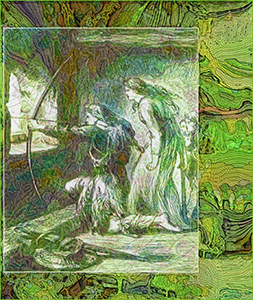
Still cleaning up my bookmark list. Here's an illustration from the 1864 Old English Ballads: A Collection of Favourite Ballads of the Olden Time. The picture shows a scene from a long 1550 "outlaw ballad," Adam Bell, Clim of the Clough, and William of Cloudesley, showing a Robin Hood-like figure, an expert bowman, holed up with his family in his house, surrounded by lawmen. It's a rip-roaring story.
"Yelde the, Cloudesly," sayd the justiseAlice and her three children escape from the burning house, but William the outlaw is captured, condemned to death ... until finally he is rescued by his woodsmen friends.
"and thy bowe and thy arrowes the fro."
"Gods curse oo hys hart," says fair Alice (Cloudesley's wife),
"that my husband councelleth so."
"Set fyre on the house," saide the sherife,
syth it wyll no better be,
and brenne we therin William," he saide,
"his wife and children thre."
They fyred the house in many a place,
the fyre flew up on hye,
"Alas!" then cryed fayr Alice,
"I see we here shall dy."
Study of The Plant: Cleaning up my Bookmark List 3
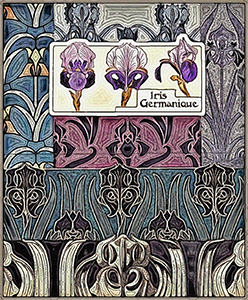
Still cleaning up my bookmark list. Here's a magnificent book, the 1903 French Etude de la Plante : Son application aux industries d'art : pochoir, papier peint, etoffes, céramique, marqueterie, tapis, ferronnerie, reliure, dentelles, broderies, vitrail, mosaïque, bijouterie, bronze, orfévrerie (Google Translate: Study of the plant: its application to art industries : stencil , wallpaper, fabrics , ceramics, marquetry, carpets, metalwork , binding, lace, embroidery, stained glass, mosaic , jewelry, bronze, goldsmith"). The idea of the book is to combine study of individual plant species (such as German Iris, in this example) with examples of how artists and craftsmen have used the plant in their images.
Source:
Link1: archive.org/details/gri_33125005959479
January 3, 2015
Planning of Ornament: Cleaning up my Bookmark List 2
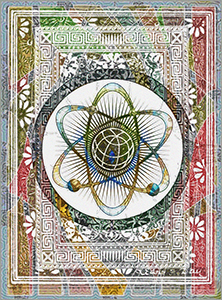
Still cleaning up my bookmark list. Here, a collage of the fine designs from the 1887 The Planning of Ornament (Link1) is a background for a radiation symbol from freegraphiclogo.com (Link2). Colors in the background are designs based on color chips in the 1930 Colors : How to Use Them in your Home (Link3).
Source:
Link1: archive.org/details/gri_33125014097261
Link2: www.freegraphiclogo.com/picture/global-atom-image-blue-vector-pixmac-vector-83581499/000083581499
Link3: archive.org/details/ColorsHowToUseThemInYourHome
January 1, 2015
Artistic Writing: Cleaning up my Bookmark List 1
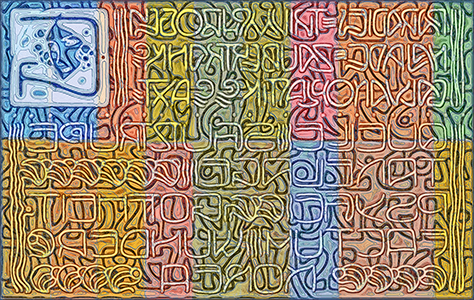
One of the tools I use to keep track of promising public domain (PD) image sources is the Internet Archive Bookmark List. The Bookmark List is my personal list of great finds; it is also publicly viewable here. When the mood hits, I go through recently uploaded PD documents, mainly from American Libraries, and bookmark the ones I want to return to. Unfortunately, I recently found out that with hundreds of documents on my list, I couldn't add any more. The list had grown because, although I intended to remove documents as soon as I used them, there were some that I especially valued; proven veterans were mixed in with the promising rookies. So I have given myself the New Year's task of pruning my Bookmark List.
Three places on the Bookmark List were filled with editions of Beispiele Kunstlerischer Schrift (Google Translate: "Examples of Artistic Writing"), collections from around 1900 of creative hand-drawn texts (Links 1-3). Here is a collage of several of these, overlaid on a composition of color samples from the 1923 Powdrpaint : A Remarkable Discovery, Reduces Cost of Painting 75% (Link4).
Source:
Link1: archive.org/details/gri_33125008890366
Link2: archive.org/details/gri_33125008890309
Link3: archive.org/details/gri_33125008890614
Link4: archive.org/details/PowdrpaintARemarkableDiscoveryReducesCostOfPainting75
December 31, 2014
Revealing Experiment in Color Inversion
<
Despite a near comatose holiday funk (connubial medical anxiety and my own aching back) and binge-watching all six seasons of The Wire, brain still working. Arose out of swamp of despair to run one simple experiment, and am surprised by the result. During the entire experiment with color chips, I was always surprised at how inversions of RGB images (left) led to very narrow range of colors (center). I decided to switch to CMYK mode, and the inversion led to a much wider range of tones and colors (right). Hmmmmmm.
December 30, 2014
1930's: Charles Atlas, Typewriter, Pipe-puffing Hobbyist
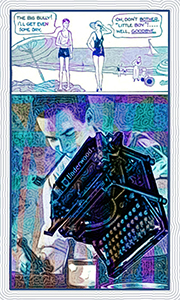
From a November 1933 Popular Science, three advertising illustrations combined: (top) a strip from an ad for the Charles Atlas bodybuilding method, (middle) a illustration of a satisfied user of then-new product Plastic Wood, and (center) an illustration of an Underwood typewriter, a heavy iron contraption upon which I learned to type over one summer in 1958.
Source:
Link1: archive.org/details/bub_gb_7CcDAAAAMBAJ
December 29, 2014
Composition for 70th Birthday
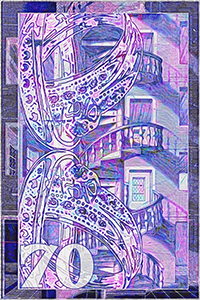
Turning seventy -- the Psalms' "threescore and ten". Did a memorial work based on (1) a 1604 book on Perspective, Perspective, id est, Celeberrima ars inspicientis aut transpicientis oculorum aciei : in pariete, tabula aut tela depicta, in qua demonstrantur quaedam tam antiqua, quam nova aedificia, templorum, sive aedium, aularum, cubicularum, ambulaciorum, platearum, xystorum, hortorum, fororum, viarum et hujusmodi alia, quae nituntur suis fondamentalibus lineis, quorum fondamentum descriptionibus clare exsplicatur, perutilis ac necessaria, omnibus pictoribus, sculptoribus, statuariis, fabriferrariis, architectis, inventoribus, cæmentariis, scrinariis, fabrilignariis, & omnibus artium amatoribus, qui huic arti operam dare volent, majori cum voluptate, & minori cum labore, (2) a graphic used to advertise a ring in a 1990 Weekly World News. The notation in lower left, ("70") is from the font FHA Nicholson French. Color in background is from same source as last two entries.
The Psalm goes on to say a man can make it to 80 if he has the strength -- but warns the way will be full of trouble and sorrow.
Source:
Link1: archive.org/details/GlassPaintsVarnishesAndBrushesTheirHistoryManufactureAndUse
Link2:
archive.org/details/gri_33125009324910
Link2:
archive.org/details/bub_gb_KfUDAAAAMBAJ
Member of Far Eastern Acting Troupe, 1880
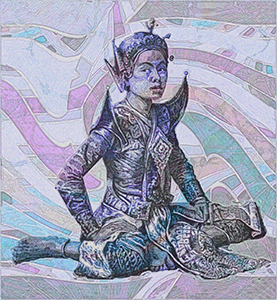
Background is another rearrangement of paint samples from the 1923 Glass, Paints, Varnishes and Brushes: Their History, Manufacture, and Use (Link1). Foreground is a treatment of a an illustration from the 1880 German travel book, Hinterindische länder und völker Reisen in den flussgebieten des Irrawaddy und Mekong ; in Birma, Annam, Kambodscha und Siam. Unter besonderer berücksichtigung der neuesten zustände in Birma bearb. (Google Translate: "Behind Indian national and international travel in the river areas of the Irrawaddy and Mekong; in Burma, Annam, Cambodia and Siam. Edit with particular consideration of the newest states in Burma."
Source:
Link1: archive.org/details/GlassPaintsVarnishesAndBrushesTheirHistoryManufactureAndUse
Link2:
archive.org/details/bub_gb_oC8-AAAAYAAJ
Acropolis Maiden on Paint Chip Pattern
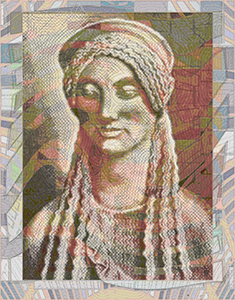
Background is a rearrangement of paint samples from the 1923 Glass, Paints, Varnishes and Brushes: Their History, Manufacture, and Use (Link1). Foreground is a treatment of a photo of a Madchenfigur von der Akropolis ("Figure of a Young Woman from the Acropolis") from the 1894 Eues Korrespondenz-Blatt für die Gelehrten - Und Realschulen Württembergs (Link2) ("New correspondent for the Journal of scholars and secondary schools Württemberg." The image represents a break from my recent styles, since I am quite confused as to the direction I should follow in 2015.
Source:
Link1: archive.org/details/GlassPaintsVarnishesAndBrushesTheirHistoryManufactureAndUse
Link2:
archive.org/details/bub_gb_VG8qAAAAYAA
December 18, 2014
Mage Script over Factory Marking Enamel
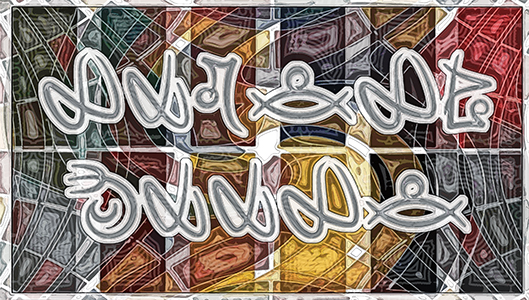
Background is a rearrangement of paint samples from the 1921 Character Paints for Mill and Factory, which shows small subset of colors used to mark valves, pipes, etc. in factories, mills, and power plants. (I remember my father used a similar system of color-coding of parts on the various lathes in his junior high wood shop. Overlaid in them is my name in the Mage Script alphabet.
Source:
Link1: archive.org/details/CharacterPaintsForMillAndFactoryASystemForDefinitelyDesignatingAll
December 18, 2014
HD Format: Star Wars Script over Plochre Color Plate
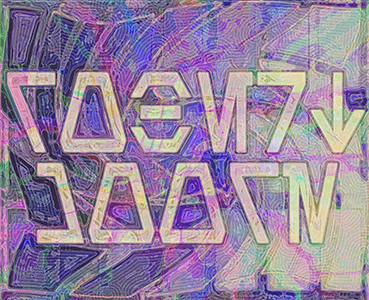
Background is another rearrangement of paint samples from the 1948 Plochere Color System, from Plate 51. Elements in the foreground are from another one of Pixel Saga's science fictional fonts showing the Aurebesh alphabet, the most common language of the Star Wars fictional universe. The characters reads "Robert Moore".
Source:
Link1: archive.org/details/PlochreColorSystem
December 16, 2014
HD Format: Dragon Claw Script over Paint Sample Plate

Background is another rearrangement of paint samples from the 1948 Plochere Color System. Elements in the foreground are from another one of Pixel Saga's fonts showing the Dovahkiin Script alphabet from another Elder Games: Skyrim edition.
Note date: your old PBob got knocked on his ass by a miserable hacking cough, made doubly worrisome by Janice's medical condition. Listless, watched a lot of TV including last 3 seasons of The L-Word and Marvell's new Guardians of the Galaxy.
Source:
Link1: archive.org/details/PlochreColorSystem
December 15, 2014
HD Format: Videogame Written Language over Plochre Sample Page
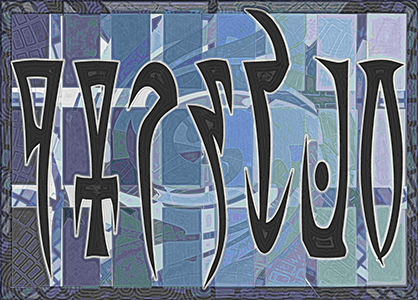
Background is another rearrangement of paint samples from the 1948 Plochere Color System. Elements in the foreground are the characters P..V of a fictional alphabet from the role playing game The Elder Scrolls, set to type by the prolific typographer Neale Davison, pen name Pixel Sagas.
Janice is recovering nicely from her lumpectomy, but somewhere in the roundtrip to Richmond, Virginia, taking Janice to the doctors, and running errands, I caught a hacking chest cold.
Source:
Link1: archive.org/details/PlochreColorSystem
December 6, 2014
HD Format: Vintage Frame and Palestinian "entry permit" over Paint Sample

Background is a rearrangement of paint samples from the 1948 Plochere Color System. Two elements in foreground: (1) a vintage panel from Amin Sughayer's Vintage Panels-04 and (2) a piece of political art by a Palestinian artist Khaled Jarrar, whose Live and Work in Palestine project consists of seemingly official Palestinian passport stamps. See his Facebook page
and two articles about his work: here and here. Generally, although I am not deeply familiar with Middle East politics, I think the Palestinians are getting a raw deal.
Source:
Link1: archive.org/details/PlochreColorSystem
December 5, 2014
HD Format: Vintage Panel over Sears Linoleum
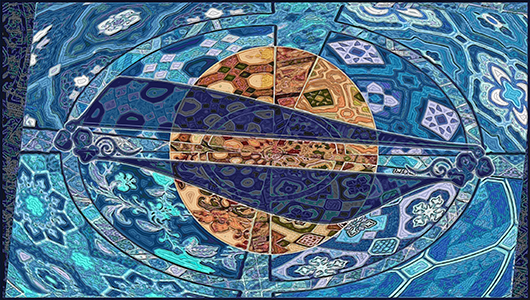
>
Background is a rearrangement of linoleum patterns from the 1912 Sears & RoebuckCatalog no. 124, foreground is another ornament from Amin Sughayer's Vintage Panels font.
Source:
Link1: archive.org/details/catalogno12400sear
December 4, 2014
HD Format: Typographic Ornament over Nature's Harmony
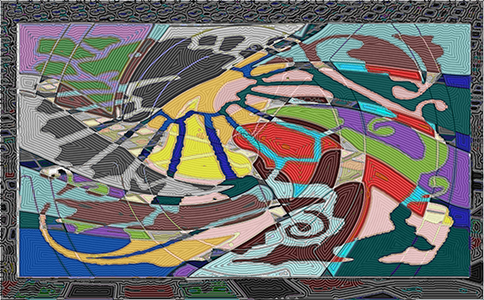
Background is a rearrangement of color samples from the 1940 Nature's Harmony: Primary Colors. Foreground is a distorted typographic ornament (capital "O") from Manfred Klein's dingbat font called Typo Backgrounds. The ornament is barely visible, but it seems to be a stylized lion rearing on its two hind legs, tail to the right, mane to the left.
Source:
Link1: archive.org/details/NaturesHarmonyPrimaryColors
December 4, 2014
HD Format: Vintage Panel over Sears Gingham
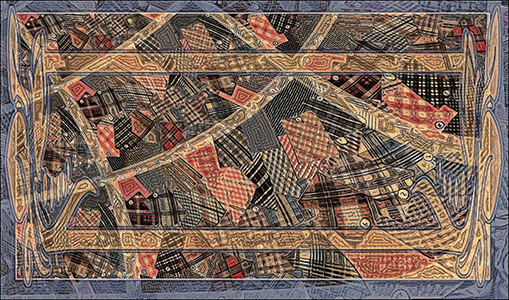
Background is a rearrangement of samples of gingham sewing cloth from the 1912 Sears & RoebuckCatalog no. 124. The foreground is a panel from Egyptian Amin Sughayer's Vintage Panels font.
Source:
Link1: archive.org/details/catalogno12400sear
December 3, 2014
HD Format: City of Lights 2015 over Sears Carpets
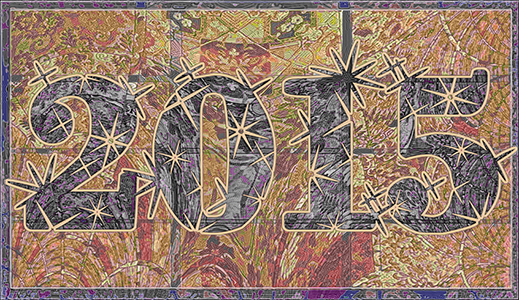
Background is a rearrangement of carpet samples from the 1250-page Sears & RoebuckCatalog no. 124 of 1912. Foreground is "2015" in a font called City of Lights by ImageX Fonts.
This image may become the first one of 2015, as I face the tedious task of pruning and renaming images from 2014 to an archived webpage.
Janice's operation was routine and uneventful and she sleeps peacefully in post-op exhaustion.
Source:
Link1: archive.org/details/catalogno12400sear
December 3, 2014
To contact Philly-Bob, email me at bobmoore [at symbol] pobox.com (of course, replace "[at symbol]" with "@"].
Masthead Portrait by Andy Hoffmann, 2014